Venue: Universität zu Köln, Physikalische Institute, Lecture Hall III, 4:00 pm
Sommer Term 2022
Dissecting the Chemical and Physical Structure of Pre-stellar Cores
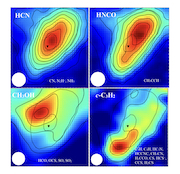
by Silvia Spezzano, Max Planck Institute for Extraterrestrial Physics, Garching, Germany
Pre-stellar cores are starless cores that are gravitationally bound, dynamically evolved and on the verge of gravitational collapse. They evolve towards a higher central condensation leading to formation of the central protostar. There is observational evidence that the chemistry does not undergo a complete reset with the formation of the protostar, and hence pre-stellar cores provide the budget of matter that will eventually be inherited by stars and planets.
The physics and chemistry of pre-stellar core are deeply interconnected. In my talk I will discuss our recent results on using pre-stellar cores as “space laboratory” to study the physics and chemistry in the early stages of star formation. In particular, I will present our observational and modelling efforts to use molecular spectra to dissect the physical and chemical structure of pre-stellar cores.
Image: Molecular emission maps of the pre-stellar core L1544 from IRAM 30m data. The dotted contours show the H2 column density computed from Herschel/SPIRE data. [Spezzano et al. 2017]
(Abstract PDF)
The PAH Revolution: Cold, Dark Carbon at the Earliest Stages of Star Formation
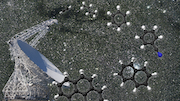
by Brett McGuire, MiT | Chemistry, Cambridge, Massachusetts, USA
Polycyclic Aromatic Hydrocarbons (PAHs) have been implicated as a large reservoir of reactive carbon in the interstellar medium since the 1980s. PAHs have been widely attributed as the carriers of the unidentified infrared bands where their aggregate vibrational emission spectra are extremely well matched to the observed line signals. Only in the last year have individual PAHs been detected in the ISM for the first time, however, allowing us to begin to investigate the detailed chemical pathways for the formation and destruction of these molecules. In this talk, I will discuss our detections of PAH molecules via their rotational transitions using Green Bank Telescope observations of TMC-1 from the GOTHAM collaboration. I will discuss the efforts to model the chemistry of these PAHs, the necessity of complementary laboratory kinetics work, our application of novel machine learning approaches to exploring the chemical inventory in TMC-1, and finally the benefits of unbiased reaction screening studies in the laboratory with Microwave Spectral Taxonomy.
(Abstract PDF)
High Resolution Infrared Spectroscopy of Molecular Ions of Astrophysical Interest
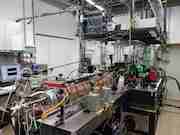
by José Luis Doménech, CSIC, Madrid, Spain
Molecular ions are at the heart of the formation routes of more complex molecules in the ISM. At the low temperatures and densities prevalent there, only binary reactions with no activation barrier are likely to proceed, and ion-molecule reactions fall generally into this category. Molecular ions are also tracers of the physical conditions of their environment, such as the degree of ionization or the fraction of gas in molecular form.
Although most of the identifications of molecules, including ions, in the ISM have been done using observations in the radiofrequency domain, the observations and laboratory experiments in the infrared region provide very valuable information. On the one hand, IR frequency measurements can provide accurate predictions of rotational transitions to be observed in space or in the laboratory, and, furthermore, ground-based observations in the IR are one of the few available means left to study light hydrides in the ISM.
I will describe the experimental approach followed in our laboratory to study the spectrum of molecular ions, i.e. high resolution tunable infrared laser absorption in hollow cathode electrical discharges, together with some contributions of our lab in this field. I will also comment on ongoing work on the implementation of magnetic fields on the experiment and future prospects.
(Abstract PDF)
The Importance of Career Self-management for Academic Career Development
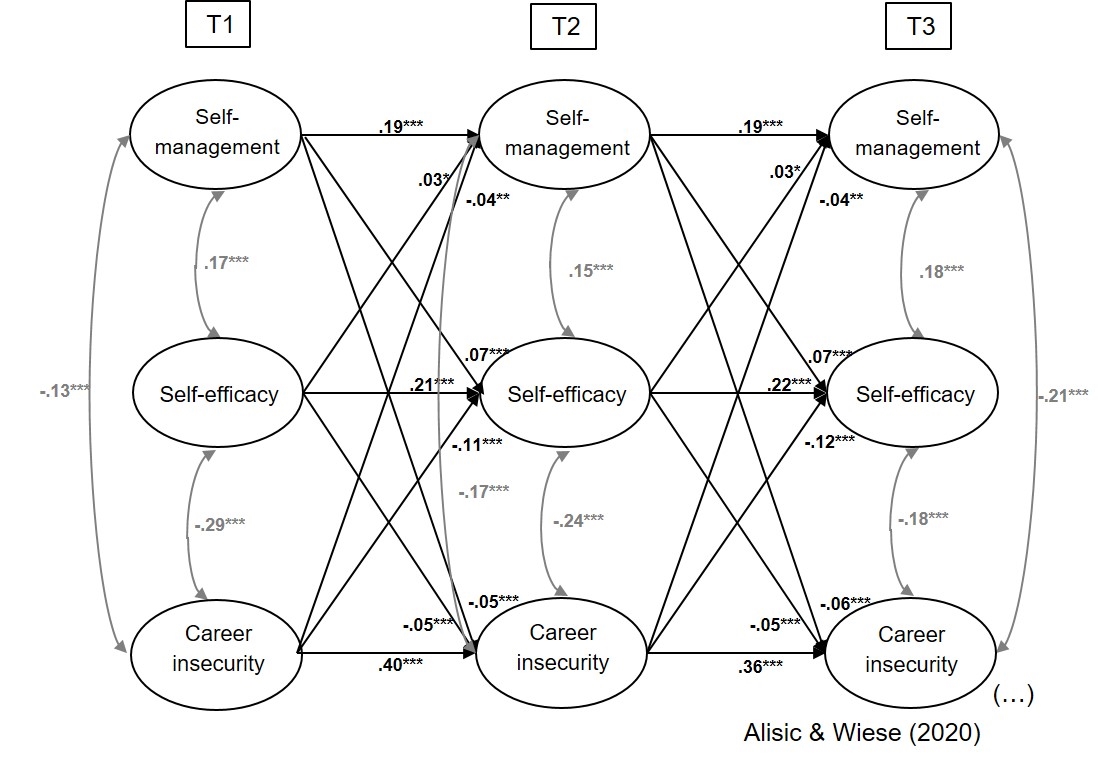
by Aida Alisic, RWTH Aachen, Germany
Career self-management is a central demand in academic career paths, since individuals are frequently held responsible for managing their careers by themselves and face high levels of insecurity in the early career phase. In this talk, I will present results of three longitudinal studies that were part of a larger nine-wave research project on the career paths of young STEM scientists. This research is approached from perspectives of inter-individual as well as intra-individual differences. Questionnaire data were analyzed by using the random intercept cross-lagged panel model (RI-CLPM; Hamaker et al., 2015) to separate between-person effects from within-person effects. The first study examined reciprocal relationships between work-related self-management, occupational self-efficacy, and career insecurity (N = 3118 PhD students and PhD holders). Results showed increases in self-management and self-efficacy to predict decreases in career insecurity as well as increases in career insecurity to predict decreases in self-management and self-efficacy. The second study investigated the dynamic relationship between flow experience and career goal clarity (N = 3094 PhD students and PhD holders). Results revealed increases in career goal clarity to be associated with subsequent increases in flow experience, and vice versa. The purpose of the third study was to illuminate the process of disengagement from the goal to obtain a PhD (N = 2,011 PhD students). It was assumed that both the lack of self-directed career management as well as social support fuel the experience of an action crisis with regard to the goal to complete a PhD, which, in turn, mitigates the motivation to engage in career management and seek out social support. Results confirmed these predictions. Practical implications will be discussed.
(Abstract PDF)
Probing the Microphysics of Radiative Feedback from Massive Stars in the James Webb Space Telescope Era
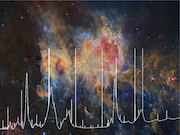
by Olivier Berne, CNRS/IRAP, Toulouse, France
Ultraviolet photons emitted by O/B stars have profound effects on the evolution of interstellar matter in our Galaxy and throughout the Universe, from the era of vigorous star formation at redshifts of 1-3 to the present day. The dominant radiative feedback processes can be probed by observations of the Photo-Dissociation Regions (PDRs) where the far-ultraviolet photons (E=5.17-13.6 eV) create warm regions of gas and dust in the neutral atomic and molecular gas. PDR emission provides a unique tool to study
in detail the physical and chemical processes that are relevant for most of the mass in inter- and circumstellar media including diffuse clouds, protoplanetary disks and molecular cloud surfaces, globules, planetary nebulae, and star-forming regions.
In this talk, I will present some recent efforts aiming at the improving our understanding of PDRs.
I will describe how recent results from laboratory astrophysics providing molecular parameters for Polycyclic Aromatic Hydrocarbons (PAHs) can be used to revisit the role and contribution of these species to the most important heating mechanism in PDRs, i.e. the photoelectric heating. I will then describe the PDRs4All project, which is an Early Release Science (ERS) program involving a large community of scientist from astronomy to laboratory astrophysics, aiming to observe the Orion Bar PDR with the James Webb Space Telescope (JWST) in the summer-fall 2022. Important efforts have been developed by the PDRs4All team, in terms of modelling and data processing methods relying on machine learning, to prepare for the analysis of the spectral images that will be obtained with the NIRSpec and MIRI spectrometers. These data in highly processed format as well as some analysis tools will be made available to the community in the months following the observations, and can be used to address key questions regarding PDR physics and chemistry which I will discuss. These efforts will contribute to a better understanding of the interaction of UV radiation with gas and dust, providing tools for the interpretation of JWST spectra which will be dominated by PDR emission throughout the Universe.
(Abstract PDF)
The Beginning of JWST Science: How We Got Here and Where We Are Going
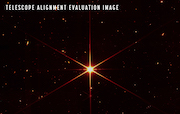
by Klaus Pontoppidan, Space Telescope Science Institute, Baltimore, USA
First science observations with the James Webb Space Telescope
Following the release of the JWST First Images on July 12th, 2022, the observatory will have successfully completed its commissioning activities and begun what we hope is many years of exciting scientific exploration of our infrared Universe. I will summarize how we got to where we are and discuss the basic performance of the observatory as determined during commissioning. I will also showcase the first images and spectra, tell the story of how they were created, and discuss how they are a resource both for public outreach and for first science. Finally, I will look ahead to the first year of planned JWST observations, and what can be expected for in the coming years.
(Abstract PDF)
Winter Term 2021/22
Probing the Stellar Initial Mass Function with CNO Isotopes

by Zhi-Yu Zhang, School of Astronomy and Space Science, Nanjing University, China
All measurements of cosmic star formation and stellar mass must assume the stellar initial mass function (IMF) to extrapolate from massive stars to total. Traditional determinations of the IMF in galaxies are made at ultraviolet, optical and near-infrared wavelengths, which cannot be probed in dusty gas-rich galaxies. The C-13/O-18 abundance ratio in the ISM – which are produced mainly by low-and-intermediate-mass stars and massive stars, respectively -- has been demonstrated as a sensitive index of the IMF in gas-rich galaxies. Besides the C-13/O-18 ratio, which is associated with different elements, O-17 and O-18 are likely even more sensitive to the IMF. Here we will present new ALMA observations and archival data of 17O and 18O in nearby galaxies. A systematic trend of 17O/18O ratios from starbursts to dwarf galaxies implies that a variable IMF is inevitable. At the end, we will present recent benchmarking on the CNO isotope gradient of the Milky Way, extending to the low-metallicity outer region.
(Abstract PDF)
Constraining the Cosmic Baryon Cycle with ALMA
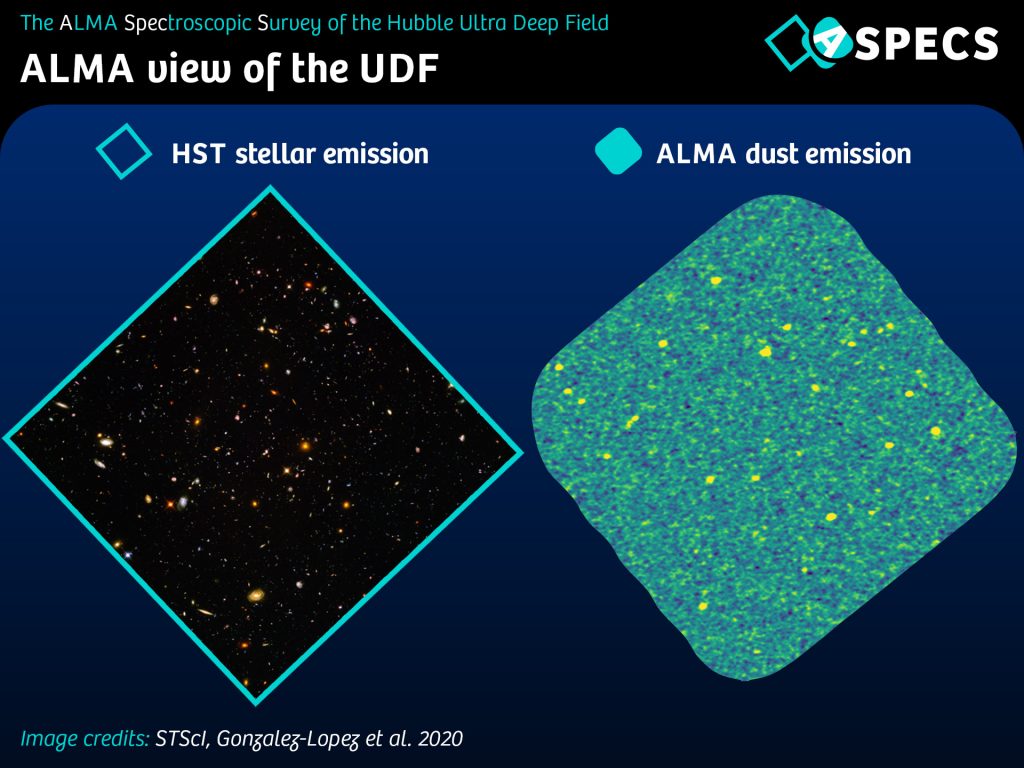
by Fabian Walter, MPI für Astronomie, Heidelberg, Germany
New observations with ALMA have provided a census of the density of molecular gas in the cosmic volume defined by the Hubble Ultra-Deep Field. This molecular gas density shows an order of magnitude decrease as a function of redshift from z~2 to z=0. It follows, to first order, the dependence of the cosmic star formation rate density. This is markably different from the atomic gas phase that shows a rather flat redshift dependence. At low redshift, observations of the interstellar medium of nearby galaxies (in particular the HERACLES survey of molecular gas and the THINGS survey of atomic hydrogen) have demonstrated that the atomic gas is significantly more extended than the molecular gas (the latter being tightly correlated with star formation activity). A similar picture is also emerging in observations of high-redshift galaxies. Assuming a simple galaxy model based on these findings, and using other measurements from the literature, the ALMA Hubble Ultra-Deep Field data are used to put observational constraints on the gas (net) accretion flows in galaxies. These gas flows are needed to explain the build-up of the stellar mass in galaxies, and are further compared to cosmological galaxy formation simulations.
(Abstract PDF)
Fragmentation and Protocluster Formation
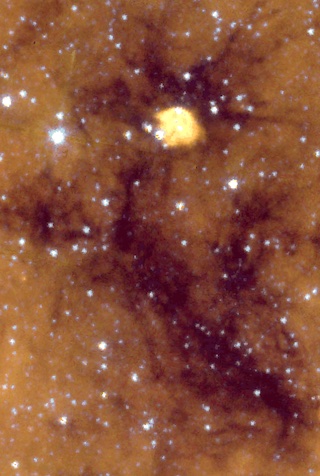
by Qizhou Zhang, Center for Astrophysics | Harvard & Smithsonian, Cambridge, Massachusetts, USA
Most stars in our Galaxy are born in clusters. How molecular clouds collapse and fragment to give rise to a cluster of stars with a range of stellar masses remains an open question. The physical conditions in clouds harboring protoclusters limit the Jeans mass to about 1 Msun. This creates a puzzle for massive star formation since dense cores much greater than 1 Msun tend to further fragment into lower mass cores. Recent sensitive and high angular resolution observations of cluster forming clouds begin to unravel the complex process of fragmentation. My talk will review the recent progress in fragmentation studies. I will present observations of protocluster forming clumps and discuss the role of turbulence and magnetic fields in the formation of protostellar cores.
(Abstract PDF)
Simulating Chemistry in Star Forming Environments
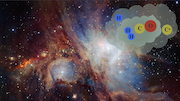
by Munan Gong, MPI for extraterrestrial physics, Garching, Germany
Chemistry determines many important aspects of the interstellar medium (ISM): for example, the abundance of observable species, heating and cooling of the gas, and the ionization fraction. Understanding chemistry is important for both understanding the physical processes that control star formation, and interpreting observations of molecular clouds in the local universe and beyond. In this talk, I will summarise our efforts in adding chemistry to numerical simulations of the ISM. I will give examples of applying chemistry in different contexts: the environmental dependence of the XCO conversion factor, self-consistent chemistry and thermodynamics, formation of molecules in HI clouds, and more.
(Abstract PDF)
Probing Star Formation in Dusty Galaxies
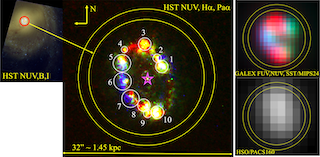
by Daniela Calzetti, Department of Astronomy, University of Massachusetts, USA
Over the next decade, new and upcoming facilities will secure observations of the restframe UV/optical spectral energy distributions (SEDs) for millions of galaxies across the entire span of cosmic time. Measurements of star formation rates (SFRs), masses, and other physical parameters from those SEDs will enable comparisons with models of galaxy evolution with unprecedented accuracy. Dust in galaxies provides an important limitation to the reliability of those measurements. (Sub)mm facilities have limited areal coverage and sensitivity and will not be able to observe those millions of galaxies. This implies that IR-based dust corrections will be difficult to extend to large galaxy samples, and dust removal from the SEDs will require the use of attenuation curves. I will review the current state of our understanding of attenuation curves at low and high redshift, highlight both their strengths and weaknesses, and discuss what steps may be able to move the field forward. During this presentation I will also highlight some recent results from the Large Millimeter Telescope and the insights they provide on star formation processes.
(Abstract PDF)
Astrochemistry at the Cryogenic Storage Ring
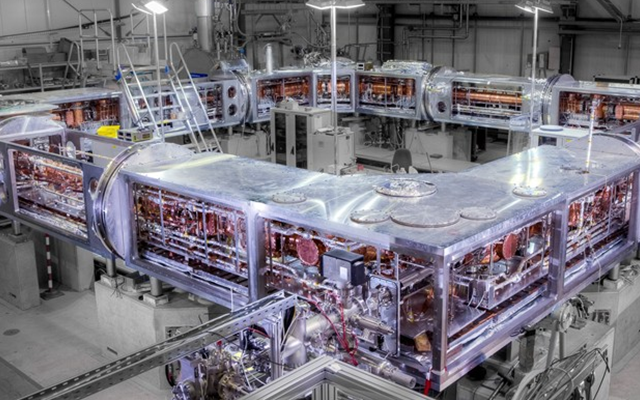
by Holger Kreckel, MPI für Kernphysik, Heidelberg, Germany
The Cryogenic Storage Ring (CSR) at the Max Planck Institute for Nuclear Physics in Heidelberg is the largest electrostatic storage ring project in the world. The CSR combines electrostatic ion optics with extreme vacuum and cryogenic temperatures. The storage ring has a circumference of 35 m, and all deflectors are housed in experimental vacuum chambers that can be cooled down to 5K. It has been shown that within a few minutes of storage inside the CSR infrared-active molecular ions (e.g., CH+, HeH+ and OH-) cool to their lowest rotational quantum states by spontaneous emission of radiation. Equipped with an ion-neutral collision setup and a low-energy electron cooler, the CSR offers unique possibilities for astrochemical experiments under true interstellar conditions. I will present an overview of the capabilities of the CSR, along with first experimental results on collision experiments between cold molecular ions and neutral atoms, free electrons, and photons, yielding quantum state-selective rate coefficients for astrophysically important processes.
(Abstract PDF)
Towards High-Precision Magnetometry in the ISM
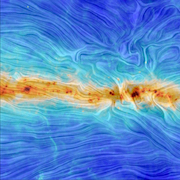
by Konstantinos Tassis, Department of Physics, University of Crete and Institute of Astrophysics, FORTH, Greece
A large-scale magnetic field permeates our Galaxy and is involved in a variety of astrophysical processes such as star formation and cosmic ray propagation. Dust polarization has been proven one of the most powerful observables for studying the magnetic field properties in the interstellar medium (ISM). However, it does not provide a direct measurement of its strength. Indirect methods have been developed, based on the assumption of equipartition between turbulent kinetic energy and fluctuating magnetic energy. However, these are rather inaccurate. In the era of large polarimetric surveys that will multiply the number of stars with measured polarimetric properties by a factor of 1000, it is important to find ways to mine high-accuracy information about magnetic field strengths from polarimetric data. In this talk, I will discuss how this is possible, by better accounting for the properties of interstellar medium magnetized turbulence.
(Abstract PDF)
From Clouds to Planets: The Astrochemical Link
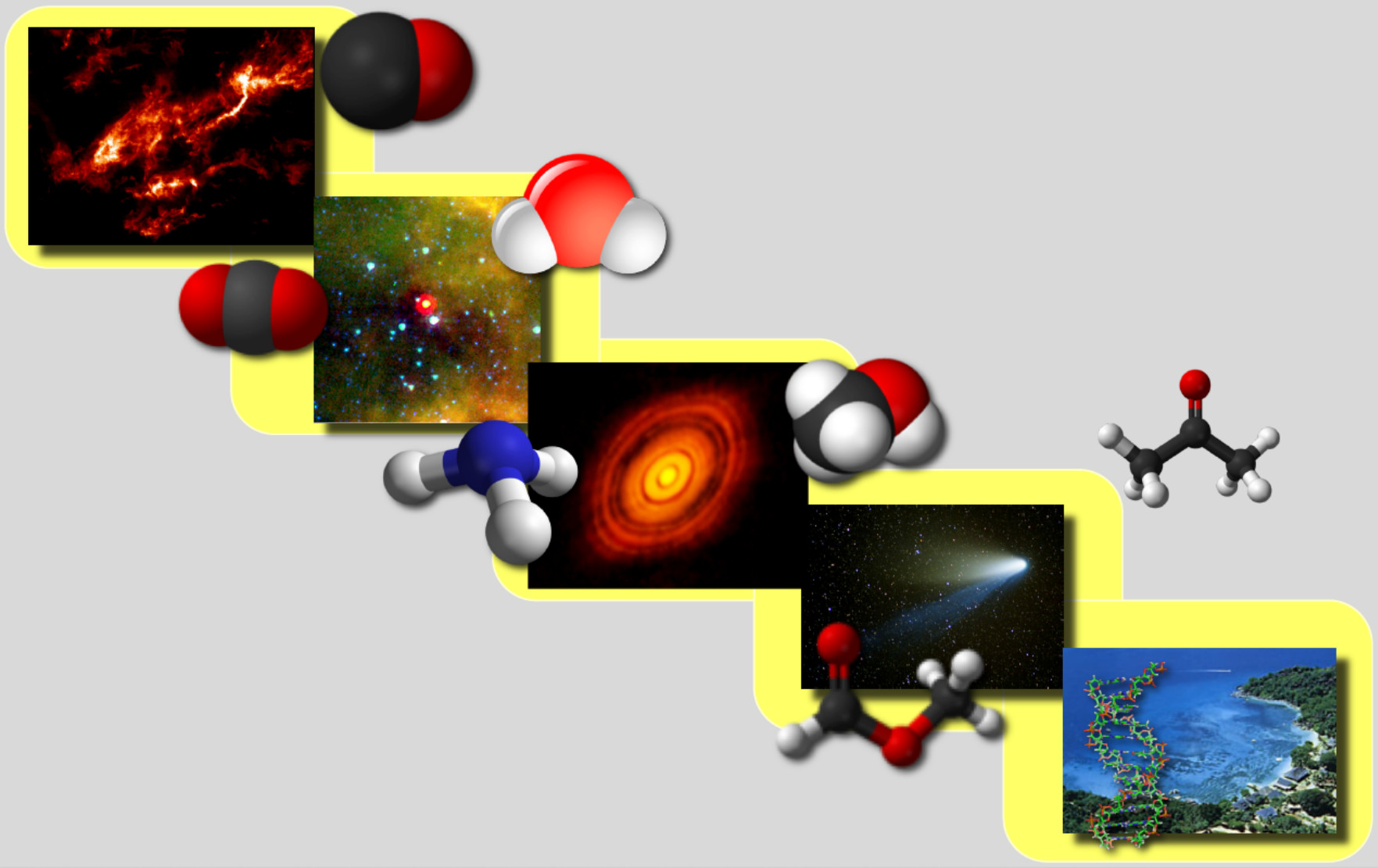
by Paola Caselli, Center for Astrochemical Studies, MPI for extraterrestrial physics, Garching, Germany
All ingredients to make stars like our Sun and planets like our Earth are present in dense cold interstellar clouds. In these "stellar-system precursors" an active chemistry is already at work, as demonstrated by the presence of a rich variety of organic molecules in the gas phase and icy mantles encapsulating the sub-micrometer dust grains, the building blocks of planets. Here, I’ll present a journey from the earliest phases of star formation to protoplanetary disks, with links to our Solar System, highlighting the crucial role of astrochemistry as powerful diagnostic tool of the various steps present in the journey.
(Abstract PDF)
SFB parenting experiences

by Rebekka Grellmann & Ronan Higgins, DLR/SFB 956
Sommer Term 2021
Astronomy and the Climate Crisis

by Leonard Burtscher, Leiden University, The Netherlands
Astronomy is a dirty business, at least in terms of its carbon footprint. Frequent, long-distance flights, the operation of observatories at remote locations, as well as the execution of CPU-intensive simulations lead to per-capita greenhouse gas emission significantly larger than those of the general population. Fortunately, inexpensive solutions, that would significantly reduce our carbon footprint immediately, are available. In this talk, I will break down the typical emissions from astronomical research and argue that we should reduce our own emissions significantly and become role models for demanding realistic change while we continue to collaborate globally. Perhaps more importantly, astronomers can convey awe for the wonders of the universe, a sense of the uniqueness of our planet, and a feeling of global citizenship -- the most important ingredients to provoke a feeling of urgency about the climate crisis, that ideally leads to climate action.
(Abstract PDF)
The Complex Chemistry of Young Stars
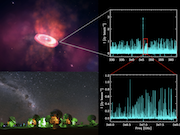
by Jes Kristian Jørgensen, Niels Bohr Institute, University of Copenhagen, Denmark
The environments in which young stars form show a rich and varied chemistry. Understanding how, when and where complex organic and potentially prebiotic molecules are formed in these regions is a fundamental goal of astrochemistry. With the Atacama Large Millimeter/submillimeter Array (ALMA) we are moving into a new territory for these studies with ALMA's high sensitivity for faint lines, high spectral resolution which limits line confusion, and high angular resolution making it possible to study the structure of young protostars on solar-system scales. In this talk I will present some of our recent ALMA results concerning the chemistry taking place in star forming regions. I will discuss the implications of these results on the formation of complex organic molecules around young protostars and the link between the birth environments of these protostars, the conditions in their protoplanetary disks and eventually the chemistry in emerging solar systems.
(Abstract PDF)
Our Galaxy’s Center: a Window into the High-Redshift Universe

by Cara Battersby, University of Connecticut, USA
Galaxy centers are the hubs of activity that drives galaxy evolution, from supermassive black holes to dense stellar clusters and feedback from newly-formed stars. Our own galaxy’s center has properties (densities, temperatures, and turbulent line widths) that are reminiscent of galaxies at the peak of cosmic star formation, but in our own cosmic backyard, where the interplay of these physical processes can be resolved in detail. In this talk, I will discuss gas inflow into our Galaxy’s Center, properties of the gas, and incipient star formation. I will discuss simulations of gas flows into the Galactic Center, which are thought to contribute to the unusual properties of star formation in this region, namely that it is producing 10x fewer stars than predicted by standard scaling relations. I will describe observations of the gas and incipient star formation in this region, as well as discuss efforts to measure whether or not this unusual environment results in a change to the Initial Mass Function.
Image: A three-color view of clouds in our Galaxy’s Center. Red shows new submillimeter observations, peering deep inside these dense clouds and pinpointing incipient star formation in the region (CMZoom: Battersby et al. 2020), Green is Herschel 70 micron (Molinari et al. 2010), and Blue is Spitzer 8 micron (Benjamin et al. 2003).
(Abstract PDF)
Implicit Bias: What it Is, Why it Matters, and What to Do (and not Do) about it

by Jennifer Saul, Waterloo Chair in Social and Political Philosophy of Language, Canada
In recent years, there has been an increasing awareness of the ways that implicit bias may contribute to the under representation of particular groups in academia. There has also been a large quantity of research on what does-- and doesn't-- work to combat implicit bias. One thing this has shown is that some of the most popular diversity-oriented interventions may be ineffectual or even counterproductive. This talk offers an overview of what implicit biases are, the sorts of effects that they may have in academia, and what remedies work and don't work for creating a more equitable environment. In particular, we will see that some of the most effective ways of combatting implicit bias require structural and institutional changes.
(Abstract PDF)
Simulating Star Formation with the Radiation Transport Code TreeRay
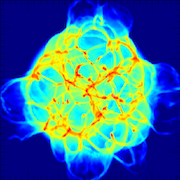
by Richard Wünsch, Astronomical Institute of the Czech Academy of Sciences, Prague, Czech Republic
I will present a novel fast radiation transport algorithm TreeRay, suitable to work together with hydrodynamic codes. It is based on reverse ray tracing combined with tree-based accelerated integration. TreeRay is implemented in the adaptive mesh refinement code FLASH, however, the method itself is independent of the host code and can be implemented in any grid based or particle based hydrodynamics code. A key advantage of TreeRay is that its computational cost is independent of the number of sources, making it suitable for simulations with many point sources (e.g. massive star clusters) as well as simulations where diffuse emission is important. A very efficient communication and tree-walk strategy enables TreeRay to achieve almost ideal parallel scalings. TreeRay can easily be extended with modules to treat radiative transfer at different wavelengths and to implement related physical processes. I will focus on the module calculating ionising radiation using the On-the-Spot approximation and describe various tests demonstrating that complicated simulations of star clusters with feedback from multiple massive stars become feasible with TreeRay. Finally, I will show several applications where TreeRay has been used, including project SILCC (SImulating Life Cycle of Clouds) - complex simulations of the interstellar medium in a part of the galactic disk, designed to capture the full matter cycle between gas and stars.
(Abstract PDF)
Precise Test of Quantum Theory and Determination of Fundamental Constants with HD+ Ions
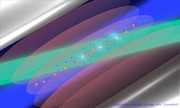
by Stephan Schiller, Institut für Experimentalphysik, Heinrich-Heine-Universität Düsseldorf, Germany
Frequency metrology of cold trapped molecules provides exciting opportunities in fundamental physics, including test of ab initio calculations (in particular of QED effects), determining fundamental constants, and search for physics beyond the standard model.
Our object of study is the HD+ molecule - a deceptively simple bound three-body quantum system that allows a high-precision calculation of its rovibrational energies, including relativistic and QED corrections. As of today the latter have been computed up to order α6 relative to the nonrelativistic energy. Since the theoretical calculation requires as input the values of fundamental constants (proton-electron mass ratio mp/me, deuteron-electron mass ratio md/me, proton and deuteron charge radii rp, rd, and Rydberg constant), a comparison of theoretical with experimental transition frequencies provides a means to determine these constants. Also, the level of agreement between theory and experiment can set an upper bound on a hypothetical non-Coulomb proton-deuteron spin-averaged interaction.
Experimentally, we showed that for a string of molecular ions, trapped in a linear ion trap and sympathetically cooled, excitation of transitions with radiation propagating perpendicularly to the trap axis allows spectroscopy in the Lamb-Dicke regime(1), i.e. Doppler-free.
We have performed spectroscopy of the fundamental rotational(1) (1.3 THz) and the fundamental vibrational(2) (5.1 µm) transitions in the ground electronic level. We measured 6 hyperfine transitions of the fundamental rotational transition and two hyperfine components of the fundamental vibrational transition.
The comparison with our high-precision ab initio calculations of the energy levels, that used CODATA2018 values of the fundamental constants, yields agreement at the fractional level 3x10-11. Alternatively, applying a suitable analysis technique, the comparison between experiment and theory results permitted determining a value of me (mp-1+md-1) with uncertainty smaller than both CODATA2018, and from direct mass measurements in Penning traps. Finally, our experiment also sets a > 20 times improved upper bound for the strength of a hypothetical "fifth force" between proton and deuteron, in the form of a Yukawa potential.
(1) S. Alighanbari, et al. “Precise test of quantum electrodynamics and determination of fundamental constants with HD+ ions”, Nature, vol. 581, p. 152-158, 2020.
(2)I.V. Kortunov, et al. “Proton-electron mass ratio by high-resolution optical spectroscopy of ion ensembles in the resolved-carrier regime”, Nat. Phys., 2021.
(Abstract PDF)
Going Local -- A Multi-scale Picture of the Magnetic Field in Star Formation
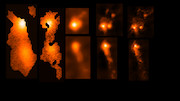
by Patrick Koch, Academia Sinica Institute of Astronomy and Astrophysics (ASIAA), Taipei, Taiwan
The role of the magnetic (B-) field in the star-formation process is highly debated. How important is the B-field? What is the role of the B-field in the presence of gravity and turbulence? While a growing number of instruments is now offering dust polarization observations as a tool to observe B-fields, the analysis and interpretation of these data can still be challenging. We present a synergetic multi-scale picture of the magnetic field, based on a series of dust polarization observations in high-mass star-forming regions. These observations image the B-field morphology with progressively higher resolutions from the pc-scale envelope, to globally collapsing cores, to the fragments within cores, and down to a network of core-connection fibers with the currently highest resolution around 500au. These data cover a range in resolution of about a factor 1,000 in area. Together with these scale-dependent B-field morphologies we analyze the gravitational vector field. In particular, our analysis is building on methods that are extracting local information of the B-field, to make optimized use of the detailed B-field structures that carry the imprints of the star-formation processes. As a result, we find recurring similarities in the B-field and in the gravitational vector fields. These self-similar structures point at a multi-scale collapse-within-collapse scenario. At the highest resolution, we find B-field orientations that are prevailingly parallel to the core-connecting extensions and fibers. With this we derive a stability criterion defining a minimum field strength that can stabilize fibers against a radial collapse. We find that the detected fibers are stable, hence possibly making them a fundamental component in the accretion onto central cores.
(Abstract PDF)
On the Universality of the Star-formation Processes
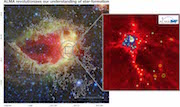
by Fabien Louvet, CEA-Saclay and ENS-Ulm, Paris, France
Star formation is a key astrophysical process. On small scales, it governs the settling of planetary systems and the complex chemistry allowing the emergence of life. On large scales, star formation controls the energy budget of galaxies. In this presentation, I will review some key similarities and differences between low- and high-mass star formation in line with one of the most important outcomes of star-formation: the initial mass of stars (IMF). We will question both its origin and universality, two hot topics in modern astrophysics.
(Abstract PDF)
Monitoring of OH Radicals on Ice Surfaces at Low Temperatures: Diffusion and Proton-hole Transfer
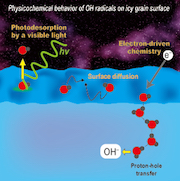
by Naoki Watanabe, Hokkaido University, Japan
The surface of cosmic ice dust is known as the birth place of various interstellar molecules in a very cold region in space, so-called a molecular cloud. Because the temperatures of ice dust are typically as low as 10 K in molecular clouds, radical reactions having little barriers play dominant roles on the surface. However, because of intrinsic experimental difficulty in detecting radicals, little is known about the behaviors of radicals on the ice surface. On cosmic ice dust, hydroxyl (OH) radical is considered to be one of most abundant adsorbates. The OH radicals can be easily produced by photolysis of water ice and reaction of hydrogen and oxygen atoms. Recently, we have developed the method to monitor the OH radical on ice at very low temperatures, which can open a new phase of research on physicochemical processes of radicals. My presentation will consist of two topics: description of the OH detection method and information of OH adsorption sites; clarifying a proton-hole transfer in ice using that method.
The detection of OH radicals on ice can be achieved by a combination of photostimulated desorption and resonance-enhanced multiphoton ionization methods. The kinetic and internal energies of desorbed OH were measured. From the results of experiments and quantum chemical calculations, we will discuss photodesorption mechanisms and adsorption sites of OH radicals on ice. Furthermore, information of surface diffusion of OH radicals on ice will be provided. We also focus on the behavior of OH radicals with coexistent of electrons on the ice surface. we found that once OH adsorbate captures an electron on the surface, the OH- on the surface abstracts a proton from neighbouring H2O which becomes OH-. The sequence of this proton-hole transfer leads to the flow of negative current in ice.
(Abstract PDF)
Winter Term 2020/21
The C+ Universe
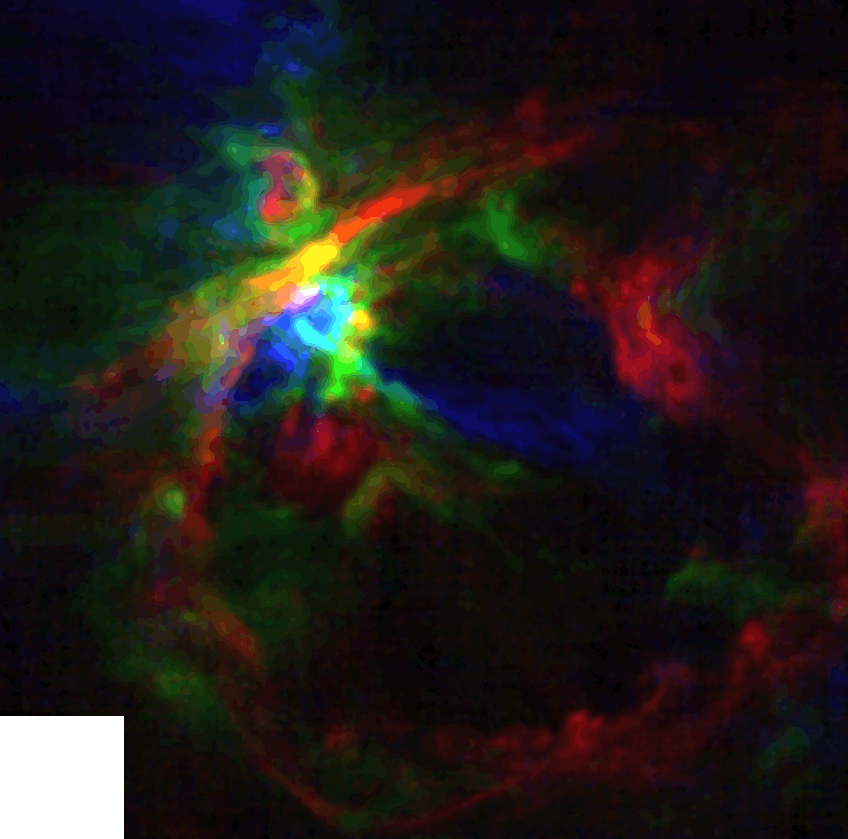
by Xander Tielens, Astronomy Department, University of Maryland, College Park and Leiden Observatory, Leiden University, The Netherlands
The interstellar medium (ISM) and its interaction with massive stars are central to galactic evolution. Interstellar gas is known to exist as atomic (HI) clouds and star forming molecular clouds. Recent observations reveal that half of the interstellar gas is in CO-dark molecular gas that has eluded detailed characterization because of lack of suitable tracer. Hence, its physical conditions and relationship to other gas reservoirs are largely unknown. Atomic and CO-dark molecular gas are heated by far-UV photons from massive stars through photo-electrons from large molecules, producing (inter)cloud phases of the ISM and controlling its emission characteristics. Through winds and explosions, stars also stir up the ISM dynamically. This source of turbulent pressure supports clouds & the gas disk against (self)gravity, disrupts molecular clouds, and compresses gas, triggering new star formation.
However, until recently, there was no good tracer for this dynamic interaction. LOFAR has opened up the low frequency sky to efficient surveys, providing a sensitive diagnostic of physical conditions and kinematics of HI and CO-dark molecular gas. Development of sensitive THz heterodyne receiver arrays combined with SOFIA's nimble telescope allow large scale surveys at sub-km/s resolution, probing coupling of radiative and mechanical energy from massive stars to their environment. Centered on these new observing opportunities, I will review our current understanding of the interstellar medium.
(Abstract PDF)
GOTHAM: A Meeting of Laboratory Spectroscopy, Observations, and Machine Learning

by Kelvin Lee, Department of Chemistry, Massachusetts Institute of Technology, USA
The recent discovery of benzonitrile towards the cold, dark molecular cloud TMC-1 with the 100 m Green Bank Telescope sparked interest into understanding the role small aromatic molecules play in the chemistry and physics of the interstellar medium. On the spectrum of molecular complexity, these species are intermediate between the small, several atom large molecules that are routinely as tracers, and the peculiar behemoths like the fullerenes and the ubiquitous polycyclic aromatic hydrocarbons (PAH). Beyond mere chemical curiosities, understanding how these molecules are formed and destroyed is relevant to how a substantial amount of material—in particular carbon—is transported and transformed in the interstellar medium, as well as gas phase synthetic routes to prebiotic molecules.
In this talk, I will present the latest results from the GOTHAM (GBT Observations of TMC-1: Hunting Aromatic Molecules) project, a large scale spectral line survey focusing on characterizing the chemical inventory of TMC-1 in the context of small aromatic molecules.I will discuss new molecular detections from this collaboration, which have been facilitated by new workflows in high resolution laboratory spectroscopy and signal analysis. Finally, I will present new machine learning methods I have developed to automate the discovery of new molecules, with the aim of providing guidance to laboratory, observation, and chemical modeling work in GOTHAM and subsequent campaigns.
(Abstract PDF)
The Inner Workings of a Starburst
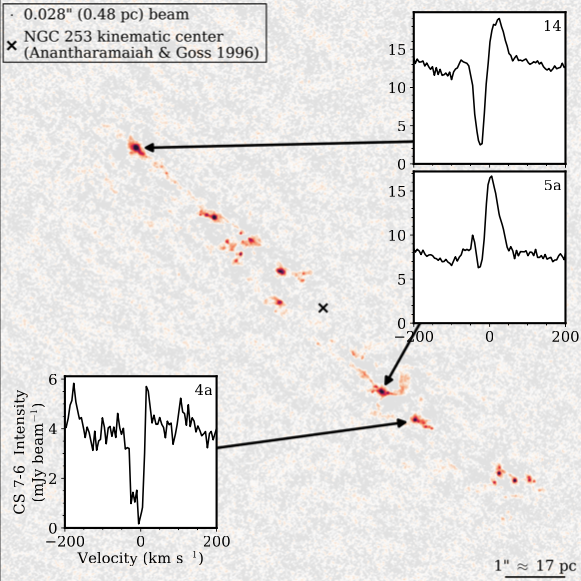
by Alberto D. Bolatto, University of Maryland at College Park, USA
Starbursts are a rare phenomenon in the present day universe, but they represent perhaps the most common mode under which stars form and galaxies grow during the z~1-2 peak of cosmic star formation activity. This mode of star formation is not a simple scaling of what happens in typical molecular clouds, but represents a much more efficient manner of converting gas into stars likely through the formation of massive clusters. The resulting feedback in the form of galaxy-scale outflows is, together with AGN, thought to be one of the main forms of regulation of galaxy growth. NGC 253 is the premier local example for a nuclear starburst, and has been targeted with several ALMA observations in order to study how these processes work. I will discuss the properties of the galactic molecular outflow, including our best constraints on the mass and outflow rate, and the
properties of the molecular gas. I will, however, focus on the results from high-resolution observations which reveal a dozen compact structures with properties corresponding to massive young star
clusters and super star clusters (SSCs), most of which are so embedded that are invisible in optical and NIR observations (the exception is a known SSC). Finally, I will present the analysis of our 0.5-pc resolution observations which reveal feedback and disruption on the scales of these clusters, I will discuss the properties of these "cluster-scale" outflows, and I will compare them to theoretical expectations.
(Abstract PDF)
Peering into the Dark: Probing the Formation and Early Evolution of Massive Stars
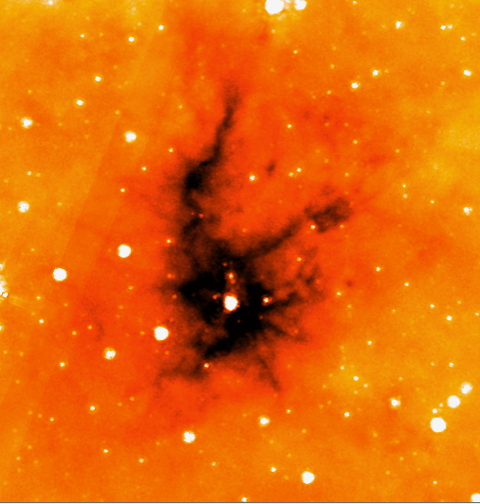
by Gary A. Fuller, Jodrell Bank Centre for Astrophysics, The University of Manchester, UK
This presentation will focus on recent work aimed at understanding the formation and early evolution of massive protostars. The massive (M>8 Msol) stars into which these evolve are the primary drivers of galactic ecosystems. The energy and nuclear processed material these massive stars inject into their enviroment during their lives and ultimately as supernovae, shapes the physical and chemical evolution of the ISM in galaxies. These stars are the precursors of a range of important astrophysical phenomena inlcuding pulsars, blackholes and gamma-ray bursts. Understanding the formation and early evolution of massive protostars is therefore essential for building comprehensive models of star formation and galactic evolution. Infrared dark clouds (IRDCs) are dense regions which are not (yet) dominated by the feedback from star formation and so are important regions for studying the initial conditions for the formation of massive stars, and their associated clusters of lower mass stars.
In this presentation I will discuss recent results from a number of studies of infrared dark clouds which shed light on the formation of these regions and the protostars which are forming within them. Using data from ALMA and other telescopes I will describe the evidence for infall over pc-scale sized regions around the most massive IRDCs and explore the extent to which observations can constrain the properties of the infall. I will then move on to discuss the initial results from TEMPO, an ALMA survey to investigate the chemical properties of a sample of massive protostars as a probe of their evolutionary stage.
(Abstract PDF)
The Chemistry of Planet Formation
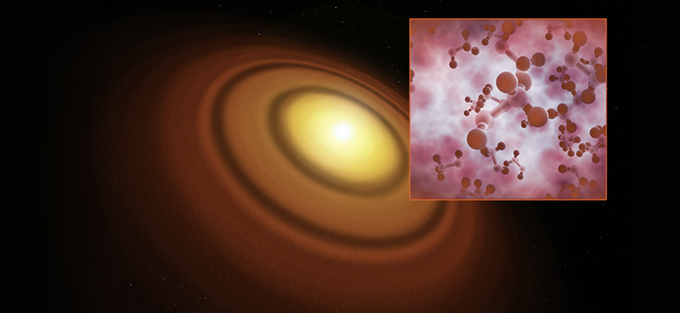
by Catherine Walsh, Astrophysics Group, School of Physics and Astronomy, University of Leeds, UK
Protoplanetary disks around young stars are the
factories of planetary systems. These structures contain all the
material - dust, gas, and ice - that will build planets and other bodies
such as comets. Hence, understanding the physics and chemistry of disks
provides much needed insight into the conditions under which planets
form, and determining their molecular content reveals the raw
ingredients of planetary atmospheres.
In this colloquium I will present early results from the first ALMA
Large Program dedicated to the observation of molecular line emission
from protoplanetary disks around nearby young stars at high angular
resolution (0.1" - 0.3"), titled "Molecules with ALMA on Planet-Forming
Scales" or MAPS. I will present images that reveal intriguing
sub-structure in emergent line emission from key organic molecules such
as CO, C2H, HCN, and CH3CN. I will discuss the link between known dust
substructure and the observed line emission, and will present results
from quantitative analyses of source properties such as radial mass
distribution, chemical structure, ionisation structure, and elemental
composition of the gas. I will also discuss how observations in the
gas-phase of large organic molecules provide insight into the
composition of the icy-comet building reservoir around other stars.
Finally I will discuss how early results from MAPS have provided the
most detailed studies to date of the chemistry of planet formation.
(Abstract PDF)
Cloud Formation and Feedback Processes: Results from the THOR Survey

by Henrik Beuther, Max-Planck-Institut für Astronomie, Heidelberg, Germany
The large program THOR conducted with the Very Large Array (VLA) is a Milky Way survey that investigates our Galaxy in the atomic gas 21cm line, in molecular gas OH emission, and in the ionised gas in the continuum and radio recombination line emission. With this diverse setup, scientific questions can be addressed from the formation of clouds and atomic to molecular gas conversion at early evolutionary stages, to feedback processes of HII regions and Supernova remnants at late evolutionary stages of star formation. This talk will give an overview of the project and present recent results obtained within the survey.
(Abstract PDF)
GAIA-BIFROST: Formation and Architecture of Star and Planetary Systems
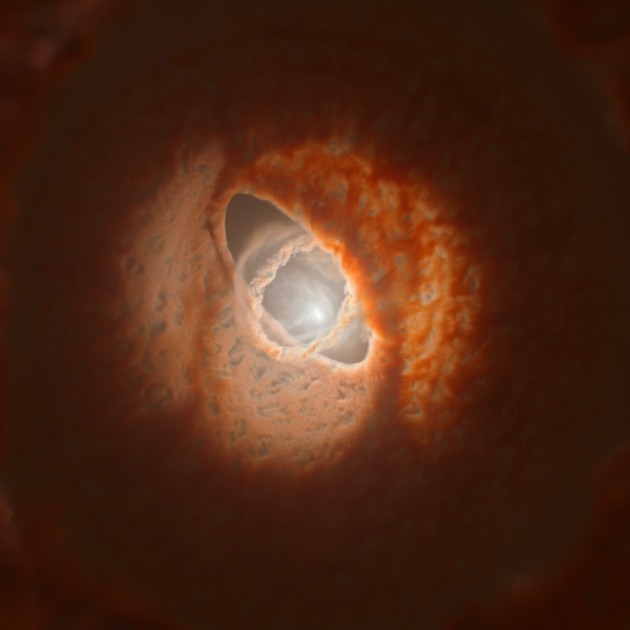
by Stefan Kraus, University of Exeter, UK
Most stars do not exist alone but are orbited by planets or stellar-mass companions. One of the big open questions concerns how planetary systems and multiple-star systems form and what causes the diversity in their orbital characteristics. For instance, the orbits of many Hot Jupiters are tilted with respect to the stellar spin axis, indicating that these planets formed in the outer disk and were then transported onto oblique orbits through dynamical interactions.
In this talk, I will outline how infrared interferometry allows us to explore the origin of the diversity that we see in star and planetary systems. I will discuss results from our MIRCX six-telescope imager at CHARA, where we achieve the resolution of a 330m telescope and search for potentially planet-induced structures in the innermost astronomical unit of protoplanetary disks. In another study, we find evidence for the disk tearing effect, where the gravitational torque of companions on misaligned orbits tears the disk apart and moves disk material out of the disk plane, enabling planet formation on highly oblique orbits.
In the second part, I will present the ERC-funded GAIA-BIFROST project that will measure orbital parameters, precision masses, and spin-orbit alignments for thousands of binary and planetary systems. We will build a new beam-combination instrument for ESO’s VLT Interferometer, named BIFROST, that will open the short-wavelength and high spectral-resolution window at VLTI. This will allow us to measure spin-orbit alignments for wide-separation planets, providing fundamentally new insights on the dynamical processes that shape system architectures.
Finally, I will outline the prospects of using BIFROST with the VLTI unit telescopes for the characterisation of exoplanet atmospheres. Combining star-light suppression from interferometry and adaptive optics, BIFROST will be able to probe closer-in planets than GRAVITY/GRAVITY+ and provide access to complementary molecular line tracers, probing deeper layers of the atmosphere.
(Abstract PDF)
A New Guided Ion Beam Instrument – NOVion: Recent Results
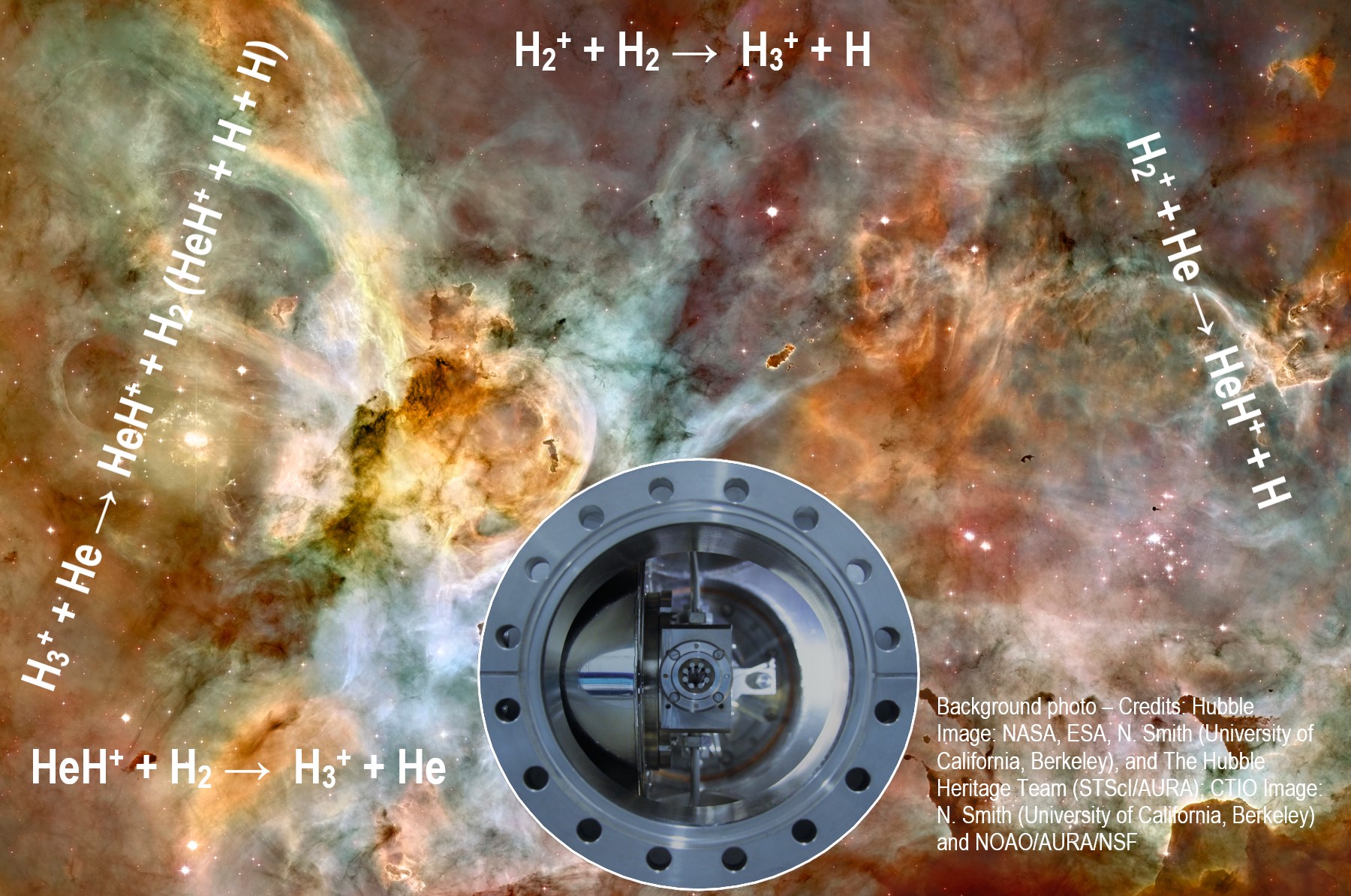
by Igor Savic, University of Novi Sad, Faculty of Sciences, Department of Physics, Serbia
Laboratory experiments concerning the formation and destruction of molecular ions are of great importance for modeling astrophysical and laboratory plasmas. The H3+ ion is the dominant ion in any kind of hydrogen plasma, triggering the formation of other molecular ions (in interstellar space as well as in laboratory plasmas). Formation and destruction of HeH+ ions (they were recently discovered in the planetary NGC 7027) are also significant for helium-hydrogen chemistry in different environments.
In this lecture, details about the newest Guided Ion Beam instrument will be presented, in addition to the technique in general. This instrument is used for investigating low energy collisions of interest for astrophysical and laboratory plasmas. Additionally, recent results on the formation of H3+ by collision of H2+ and H2 will be given. First results on the formation of HeH+ via collision of H2+ and H3+ with He will be presented. Furthermore, the results on the destruction of HeH+ in collision with H2 will be shown.
(Abstract PDF)
Sommer Term 2020
CCAT-prime: Status and Perspectives
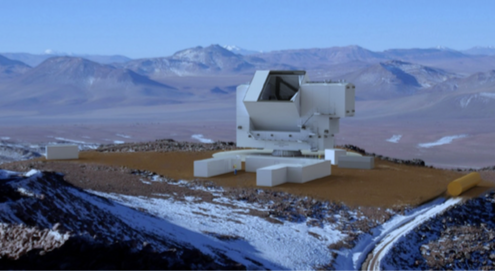
by Jürgen Stutzki, I. Physikalisches Institut, Universität zu Köln, Germany
I will summarize the rational behind, the present status, and the perspectives of the new CCAT-prime telescope and observatory. The talk will put CCAT-prime into context for the Universität zu Köln astrophysics program (including the instrumentation development). It will outline the present planning of the core science program for CCAT prime and will thus put it into the context of the international developments of the next decade.
(Abstract PDF)
Physical Conditions for Galaxy Evolution across Cosmic History as Revealed by their Cold Gas Content
by Dominik Riechers, Cornell University
The formation of stars is both fueled and controlled by the properties of the interstellar medium (ISM) in galaxies. I will outline how the ISM properties of galaxies evolve in different environments throughout 13 billion years of cosmic history based on some of the most detailed recent observations obtained with the most powerful facilities operating at radio to submillimeter wavelength such as the Karl G. Jansky Very Large Array (VLA) and the Atacama Large sub/Millimeter Array (ALMA). I will describe new results from the VLA COLDz and ALMA ASPECS molecular line scan surveys, and from targeted multi-wavelength studies of main sequence galaxies and massive dusty starbursts out to the highest redshifts. I will show how these results provide a consistent view of the full baryon cycle from gas to stars, where they hint at additional complexities, and where they challenge our current understanding built on simulations. I will conclude by discussing how planned and upcoming facilities like the Next Generation Very Large Array (ngVLA), the Square Kilometer Array (SKA), and CCAT-prime will provide new avenues towards overcoming some key challenges in our current understanding.
(Abstract PDF)
Characterizing the Dense Molecular Gas in Galaxies
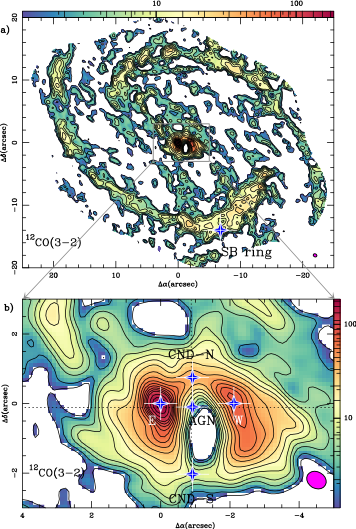
by Serena Viti, Physics and Astronomy Department, University College London, UK
It is now well established that chemistry in our Milky Way as well as in external galaxies is rich and complex. In this talk I will show how molecules play a key role in determining the characteristics of our own Galaxy, as well as nearby galaxies. By using examples from different regions of space, from interstellar and star forming gas, to extragalactic shocked regions, I will demonstrate how molecules can be ideal probes of the nature of the dense gas and hence help us to describe the different phases of the neutral gas in galaxies. Finally I will present a new approach for theinterpretation of molecules using Bayesian and Machine Learning techniques.
(Abstract PDF)
The Origin of Interstellar Turbulence
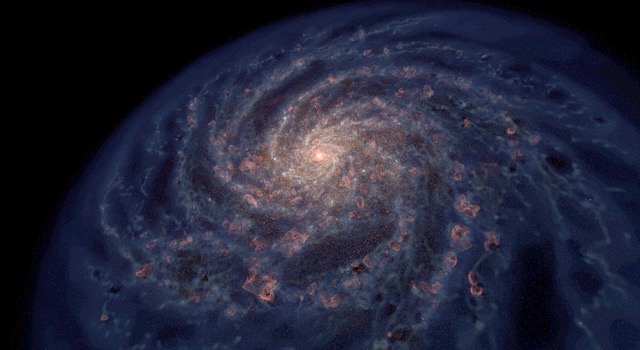
by Mark Krumholz, Research School of Astronomy and Astrophysics, Australian National University, Canberra, Australia
In this talk, I review attempts to build a self-consistent model for the origin of turbulence in the interstellar medium (ISM) of star-forming galactic discs. Ideally such a model would incorporate all potential sources of turbulence: stellar feedback, gravitational and other instabilities, and driving by stellar gravity, and would be able to explain observed correlations between ISM turbulence and other properties of galaxies, such as their star formation rates. I summarise the various ways that theorists have attempted to fit together physical ingredients to reach this goal, the differing physical pictures behind these models, and the strengths and weaknesses of each when it comes to reproducing the observations. I then show that it is possible to combine the best elements of these models into a single, unified picture that explains the relative roles of the various sources of turbulence, and successfully reproduces most of the major observations. I suggest future observations that can be used to test this unified model.
(Abstract PDF)
Thick as Thieves - Feeding and Feedback in the Most Obscured Galaxy Nuclei
by Susanne Aalto, Department of Space, Earth and Environment (SEE), Chalmers University of Technology, Gothenburg, Sweden
Cold gas plays a central role in feeding and regulating star formation and growth of supermassive black holes (SMBH) in galaxy nuclei. Particularly powerful activity occurs when interactions of gas-rich galaxies funnel large amounts of gas and dust into nuclei of luminous and ultra luminous infrared galaxies (LIRGs/ULIRGs). These dusty objects are of key importance to galaxy mass assembly over cosmic time. Dust embedded galaxy evolution also occurs in less extreme galaxies – including nearby starbursts or enshrouded AGNs. Studying them is fundamental to our understanding of how galaxies evolve in the Universe.
Some (U)LIRGS have deeply embedded galaxy nuclei that harbour a particularly active evolutionary stage of AGNs and/or starbursts: the Compact Obscured Nuclei (CONs). The nuclear activity drives mechanical feedback in the form of molecular winds, jets and outflows. This feedback can remove baryons from low-mass galaxies, prevent overgrowth of galaxies, explain “red-and dead” properties of local ellipticals, and be linked to the M-sigma relation. With mm/submm to FIR and IR telescopes, we can study the morphology, velocity structure, physical conditions and even chemistry of the obscured nuclei and their cold flows at unprecedented sensitivity and resolution.
I will focus on recent ALMA and NOEMA studies of enshrouded nuclei, AGN and feedback. ALMA studies (resolution 0.”02 (1 – 7 pc)), reveal launch regions of molecular outflows, inflows, and dusty nuclei of the nearby LIRGs NGC1068, NGC1377 and IC860. The outflows are different from each other where NGC1068 shows gas carried out by a radio jet, NGC1377 has a 150 pc scale radio-quiet molecular jet, and the IC860 flow is exceedingly compact and dense. I will also discuss how vibrationally excited molecular emission (e.g. HCN) can reach behind the curtain of dust to undertake new studies of heretofore hidden, rapid evolutionary phases of galaxy nuclei. Do CONs represent a new, unknown evolutionary phase of galactic growth?
Gender Bias in STEM

by Lina Vollmer, Freelance Trainer in the Field of Diversity and Anti-Discrimination and Consultant in the Department of Gender & Diversity Management at the UoC
Despite decades of gender equality policy, the proportion of women declines with each higher level of scientific qualification and is particularly low in the STEM area. My talk "Gender Bias in STEM" serves as an introduction in the topic of gender-specific exclusion mechanisms in science and gender bias.
Gender bias is a form of unconscious bias. This term describes distortion effects of our perception which we are not aware of. These distortions arise in connection with stereotypes and are directly related to social discrimination processes. They affect our judgements, our decision-making and eventually our actions. They can influence personnel selection decisions, performance appraisals and can cause biased judgements, even if we think we are acting fairly. I will present different gender bias effects in science and mechanisms of gender specific exclusion at universities. We will also discuss to which extent such mechanisms are particularly strong in the STEM sector and which approaches of intervention are appropriate from the university's point of view.
Picture: copyright Kira auf der Heide, unsplash.com
(Abstract PDF)
Winter Term 2019/20
Explaining the Luminosity Spread in Young Clusters
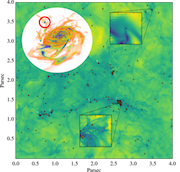
by Troels Haugbølle, Center for Star and Planet Formation, Niels Bohr Institute, University of Copenhagen, Denmark
An important shortcoming of the classical model of low-mass star formation is the so-called luminosity problem, whereby embedded protostars are observed to be under-luminous compared to what is expected from a steady mass accretion. An effect of this is observed in the Hertzsprung-Russell diagrams of star forming regions that show a large luminosity spread, which is incompatible with well-defined isochrones based on classic non-accreting protostellar evolution models. A possible solution is that accretion is not steady, but varies with time. It is debated if the time evolution of accretion rates in deeply embedded protostars is best characterised by a smooth decline from early to late stages, or by intermittent bursts of high accretion. Furthermore, while an age can be defined for a star forming region, the ages of individual stars in the region will vary. I will discuss how we can trace the accretion history of young stars, how non-steady accretion impacts the evolution of the protostellar structure, and how the observed luminosity spread can be explained through the combined effect of a protostellar age spread, a consequence of sustained star formation in star forming regions, and time-varying protostellar accretion for individual protostars.
Image: Star formation is a chaotic and dynamic process of interacting gas and stars. The gravitational collapse makes it inherently multi-scale, and variability is seen on a large range of space and time-scales. This is illustrated here column by density images obtained from global models of a star forming region with a dynamic range of up to 500 million allowing us to capture dynamics on the star cluster, core, and circumstellar disk scales.
(Abstract PDF)
Quasiparticle Approach to Molecules Rotating in Quantum Solvents

by Mikhail Lemeshko, Institute of Science and Technology (IST), Austria
Recently we have predicted a new quasiparticle - the angulon - which is formed when a quantum impurity (e.g. a molecule, atom, or electron) exchanges its angular momentum with a many-particle environment (such as lattice phonons or collective excitations in a liquid) [1,2]. Soon thereafter we obtained strong evidence that angulons are formed in experiments on molecules trapped inside superfluid helium nanodroplets [3].
In my talk, I aim to introduce the concept of angulon quasiparticles and to demonstrate how complex problems of far-from-equilibrium many-body dynamics can be simplified using this concept. In addition, I will describe novel physical phenomena that arise in molecules interacting with superfluid helium [1,5,6], as well as possible connections between matrix isolation spectroscopy and non-equilibrium magnetism.
[1] R. Schmidt, M. Lemeshko, Phys. Rev. Lett. 114, 203001 (2015)
[2] R. Schmidt, M. Lemeshko, Phys. Rev. X 6, 011012 (2016)
[3] M. Lemeshko, Phys. Rev. Lett., 118, 095301 (2017); Viewpoint: Physics 10, 20 (2017)
[4] B. Shepperson, A. A. Sondergaard, L. Christiansen, J. Kaczmarczyk, R. E. Zillich, M. Lemeshko, H. Stapelfeldt, Phys. Rev. Lett. 118, 203203 (2017)
[5] E. Yakaboylu, M. Lemeshko, Phys. Rev. Lett. 118, 085302 (2017)
[6] E. Yakaboylu, A. Deuchert, M. Lemeshko, Phys. Rev. Lett. 119, 235301 (2017)
(Abstract PDF)
The Role of Ecology in Star and Planet Formation
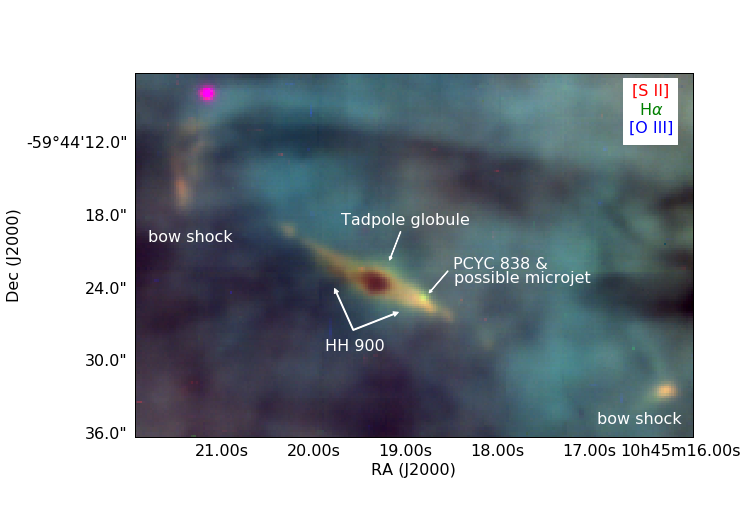
by Megan Reiter, UK Astronomy Technology Centre, Royal Observatory, Edinburgh, UK
Understanding how feedback regulates star and planet formation is one of the outstanding unsolved problems in astrophysics. Stellar feedback affects all astrophysical scales: it shapes the interstellar medium and mass function of galaxies, determines the fragmentation and star formation efficiency of molecular clouds, and plays a central role in the geochemical evolution of terrestrial planets. High-mass stars shape the local star-forming environment - the ecology - via radiation pressure, stellar winds, photoionization, and supernovae. Photoionization is the least explored of these; however, recent numerical work suggests that it dominates the destruction of molecular clouds and planet-forming disks around stars born in clusters. These predictions depend critically on the dynamics of newborn stars and feedback-altered gas, but these quantities are poorly unconstrained. I will talk about on-going surveys using ALMA, MUSE/VLT, and M2FS/Magellan to measure gas and stellar kinematics in order to test the role of environment in shaping the outcome of star and planet formation.
(Abstract PDF)
PHANGS: Star Formation, Feedback and Chemical Enrichment in Nearby Galaxies
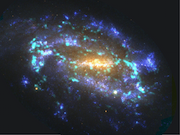
by Annie Hughes, Institut de Recherche en Astrophysique et Planetologie (IRAP), France
The Physics at High Angular resolution in Nearby Galaxies (PHANGS) project is pursuing thee major observing programmes with ALMA, VLT/MUSE and the HST in order to study the interplay of the small-scale physics of gas and star formation with galactic structure and galaxy evolution across a representative sample of star-forming main sequence galaxies in the local Universe (d20Mpc). With observations at high angular resolution (100pc), the PHANGS legacy datasets provide a detailed, panchromatic view of ionised gas, stellar light and the cold molecular gas in nearby galaxies and enable statistical studies of star formation, feedback and chemical enrichment across different galaxy environments. In this talk, I will given an overview of the PHANGS project, and highlight our latest results for the physical conditions in the molecular gas reservoir, the timescales of star formation activity and chemical enrichment in PHANGS galaxies.
(Abstract PDF)
Planetary Mass Spectrometry 389Team - Compact QIT-Mass Spectrometers for Lunar and Planetary Applications
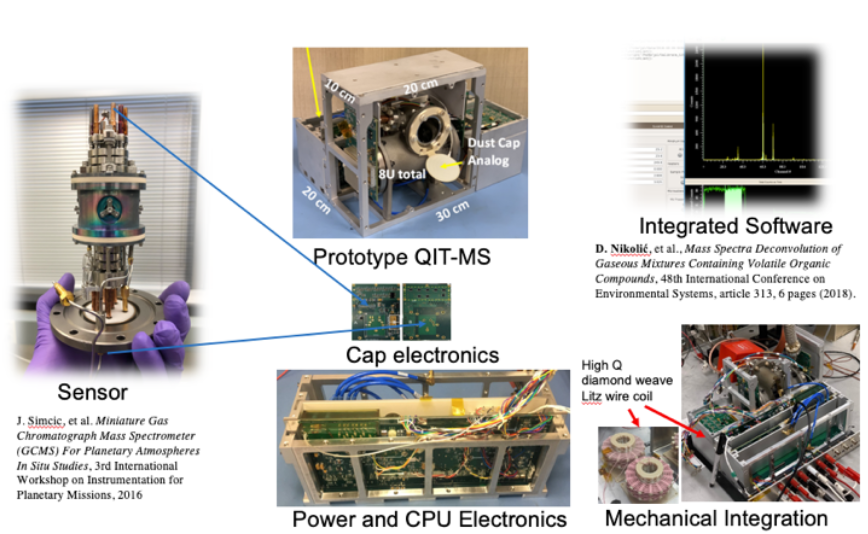
by Frank Maiwald, Jet Propulsion Laboratory, California Institute of Technology, USA
The Mass Spectrometer 389Team consists of experts in modeling, developing, and deploying technologies. Their goal is to send Compact QIT-Mass Spectrometers to Lunar, Comets, and Planetary missions. Over the past 20 years, the team has miniaturized and used QIT based mass spectrometer successfully for the International Space Station. Their accomplishments include Micro-Electro-Mechanical-Systems (MEMS) devices to reduce the weight and volume of Spacecraft Atmospheric Monitor (S.A.M.). The team has also been developing front ends to expand applications in dense atmospheres (ex: Venus) or liquids (ex: ocean worlds). Most of these developments can be used to determine any contaminants in air, water, or volatile in solids.
(Abstract PDF)
Mapping the Ionized ISM in Nearby Galaxies
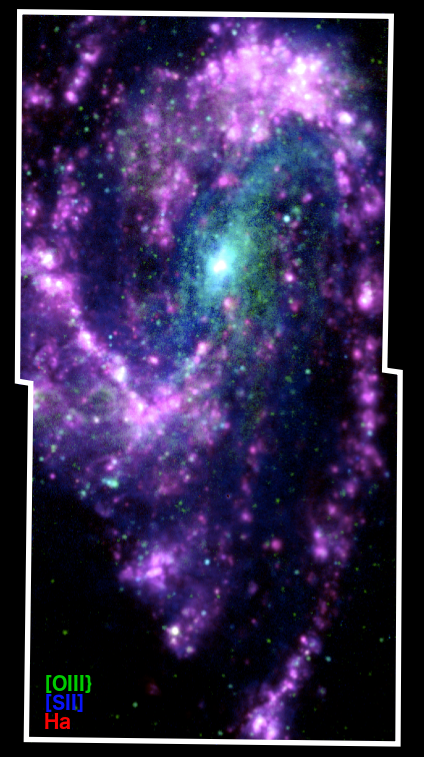
by Kathryn Kreckel, Astronomisches Rechen-Institut (ARI), Universität Heidelberg, Germany
The ionized interstellar medium (ISM) provides crucial insights into understanding baryon cycling within disk galaxies and tracing radiative and mechanical feedback from young massive stars. With new VLT/MUSE optical integral field spectroscopy, the PHANGS team now has a wealth of emission line maps that trace different ionization sources and physical conditions across nearby disk galaxies at the 50pc spatial scales needed to isolate individual ionized regions (e.g. HII regions, supernova remnants, planetary nebulae) from surrounding diffuse ionized gas. I will present our most recent results connecting the molecular gas with observed sites of massive star formation, and measuring the gas phase oxygen abundances across thousands of HII regions. Within the context of the large scale galactic environment, these studies have implications for our understanding of how spiral structure acts to organize and mix the ISM, and regulate star formation.
(Abstract PDF)
(Sub)millimeter Observations of Hidden Star Formation and the Formation of Dust Through Cosmic Times
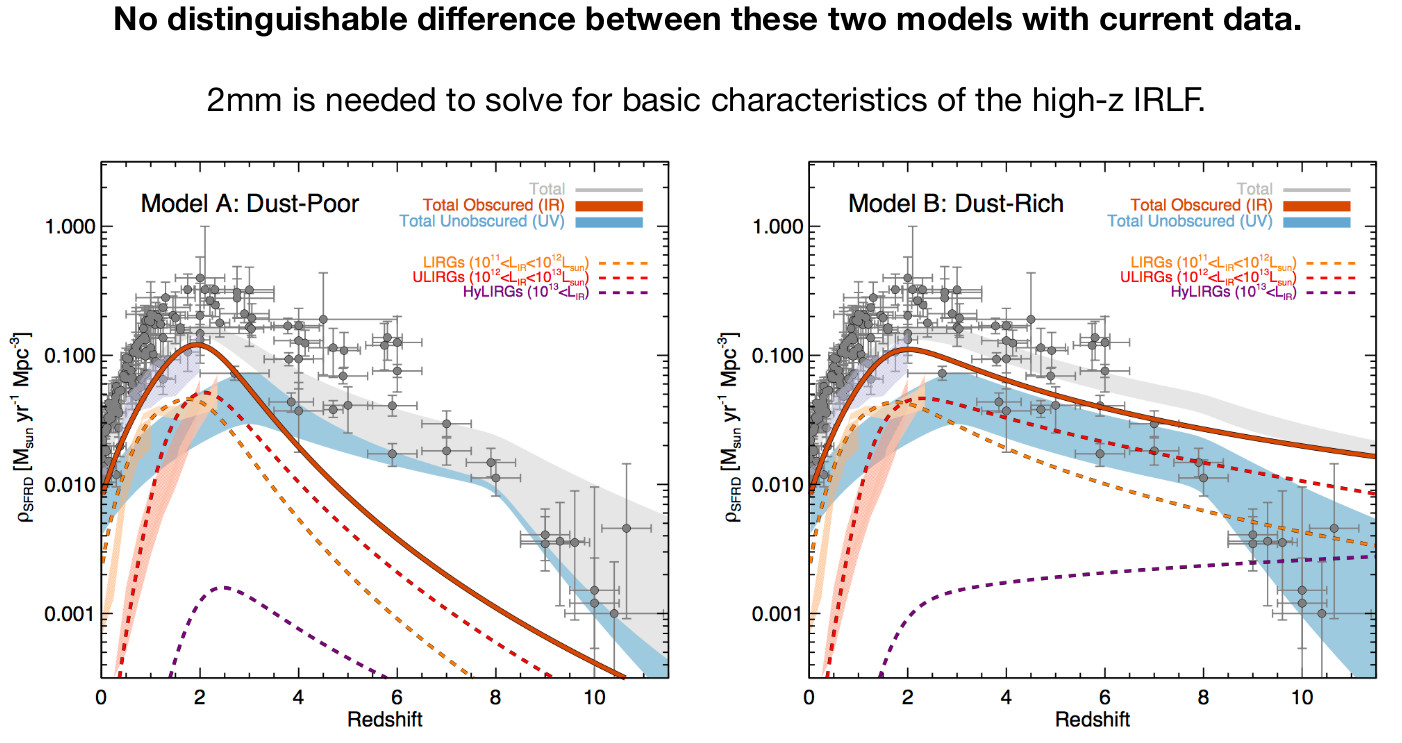
by Johannes Staguhn, Department of Physics & Astronomy, The Johns Hopkins University / Laboratory for Observational Cosmology, NASA's Goddard Space Flight Center, Greenbelt, USA
Understanding the emergence and evolution of star formation, the interstellar medium (ISM) in galaxies, as traced by dust emission, and how these two quantities relate to the underlying dark matter and larger scale structures is a major goal of astronomy. The primary tracers of star formation and the ISM are observable at FIR through (sub)millimeter wavelengths, yet most analysis of early Universe galaxy evolution has been done using optical/near-infrared studies. However, in the rest-frame UV and at visible wavelengths, most of the star formation is strongly obscured by foreground dust, so few constraints exist on the universal star formation activity, in particular in redshift z>3 galaxies. To bridge this gap in our understanding, large (sub) millimeter surveys will be necessary.
I will illustrate the anticipated scientific capabilities of such surveys by presenting scientific results we have already obtained from observations with the GISMO 2 mm continuum camera at the IRAM 30 m telescope in Spain. These observations include one ultra-deep and one medium deep millimeter survey in the HDF and in the COSMOS field, respectively. As an example of nearby hidden star formation I will present a recent analysis of GISMO observations of the Galactic Center region. I will finish with an outlook on the potential future of millimeter through FIR astronomy in the coming decade(s).
(Abstract PDF)
Laboratory Astrophysics Using VUV Synchrotron Radiation
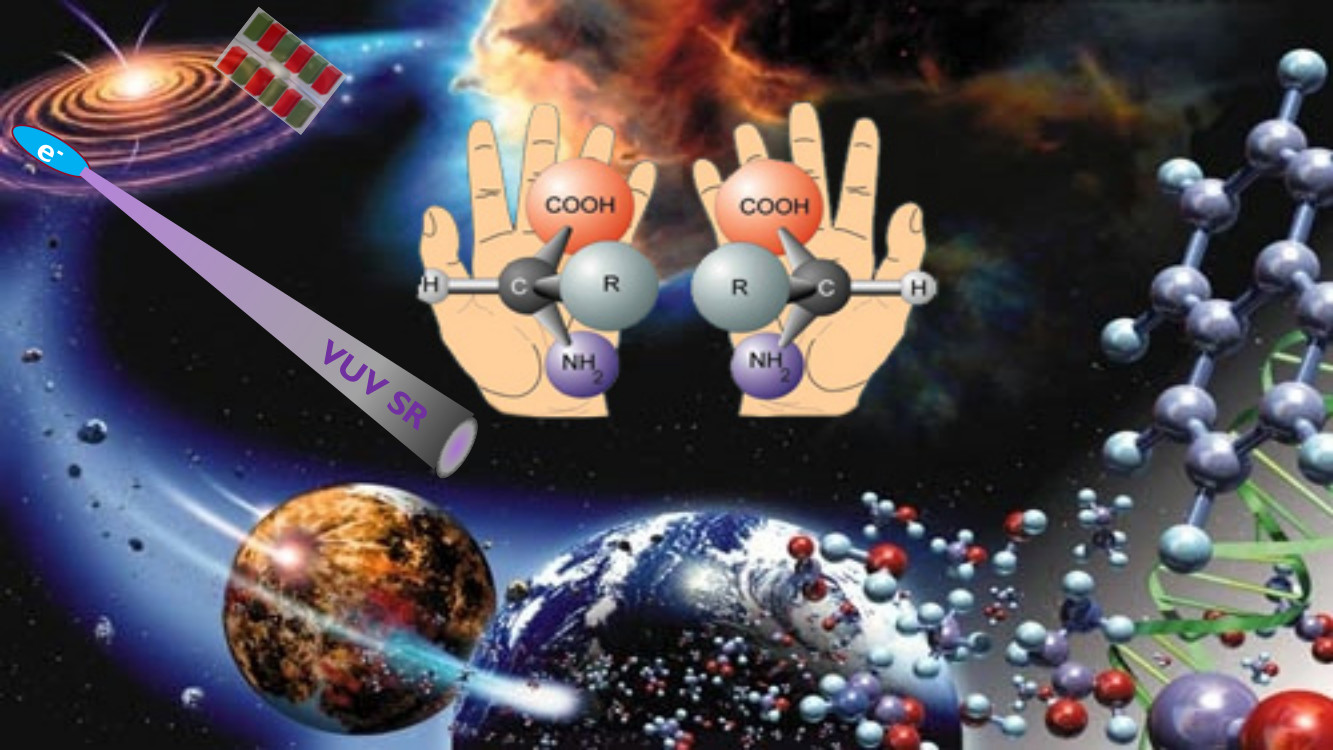
by Laurent Nahon, Synchrotron SOLEIL, Gif-sur-Yvette, France
DESIRS is a high resolution/high flux variable polarization VUV (5-40 eV) beamline [1] at synchrotron SOLEIL devoted to the study, on gas phase (cold molecules to clusters and nanoparticles) and condensed matter (thin films, ices), of molecular and electronic structures, reactivity and polarization-dependant photodynamics involving valence-shell excitations. The beamline possesses several branches including: (i) a white beam branch for ultra-high resolution absorption spectroscopy based upon a VUV Fourier-Transform Spectrometer (FTS), capable of resolving power up to 106 [2]; (ii) a monochromatic branch connected to a versatile molecular beam/aerosols chamber equipped with a double imaging electron/ion coincidence spectrometer [3] to study photoemission on mass-selected samples, nascent or as reaction products.
All of these features provide unique opportunities in the fields of Sciences of the Universe allowing (i) to study the molecular and electronic structures (and associated dynamics) of objects encountered in astrophysical environments; (ii) to simulate in the lab the VUV spectrum of ISM and planetary ionospheres to mimic photon-induced processes; (iii) to study chemical reactivity by either preparing the reactants or probing the products of reactions.
After an introduction on these opportunities and a short description of the beamline and associated instrumentation, I’ll show a few examples of recent studies including:
• High resolution absorption spectroscopy of diatomic closed-shell and radical species [4]
• Photoelectron spectroscopy of size-selected PAH clusters in link to their structures [5]
• Asymmetric VUV photon-induced processes in link with the origin of life’s homochirality: photochirogenesis of amino-acids from achiral interstellar ice analogues [6] and Photoelectron Circular Dichroism on amino-acids in the gas phase [7,8]
• VUV Photoemission from Titan’s aerosol analogs [9]
[1] L. Nahon, N. de Oliveira, G. Garcia, J. F. Gil, B. Pilette, O. Marcouille, B. Lagarde, and F. Polack, J. Synchrotron Rad. 19, 508 (2012).
[2] N. de Oliveira, M. Roudjane, D. Joyeux, D. Phalippou, J. C. Rodier, and L. Nahon, Nature Photonics 5, 149 (2011).
[3] G. Garcia, B. Cunha de Miranda, M. Tia, S. Daly, and L. Nahon, Rev. Sci. Inst. 84, 053112 (2013).
[4] A. N. Heays, N. de Oliveira, B. Gans, K. Ito, S. Boyé-Péronne, S. Douin, K. M. Hickson, L. Nahon, and J. C. Loison, J. Quant. Spectrosc. Radiat. Transfer 204, 12 (2018).
[5] C. Joblin, L. Dontot, G. A. Garcia, F. Spiegelman, M. Rapacioli, L. Nahon, P. Parneix, T. Pino, and P. Brechignac, J Phys Chem Lett 8, 3697 (2017).
[6] P. Modica, C. Meinert, P. de Marcellus, L. Nahon, U. J. Meierhenrich, and L. L. S. d'Hendecourt, The Astrophysical Journal 788, 79 (2014).
[7] M. Tia, B. C. de Miranda, S. Daly, F. Gaie-Levrel, G. A. Garcia, I. Powis, and L. Nahon, Journal of Physical Chemistry Letters 4, 2698 (2013).
[8] R. Hadidi, D. Bozanic, G. Garcia, and L. Nahon, Advances in Physics: X 3, 1477530 (2018).
[9] S. Tigrine, N. Carrasco, D. K. Bozanic, G. A. Garcia, and L. Nahon, The Astrophysical Journal 867, 164 (2018).
(Abstract PDF)
Tricks from Machine Vision Applied to the Study of the Magnetized Interstellar Medium
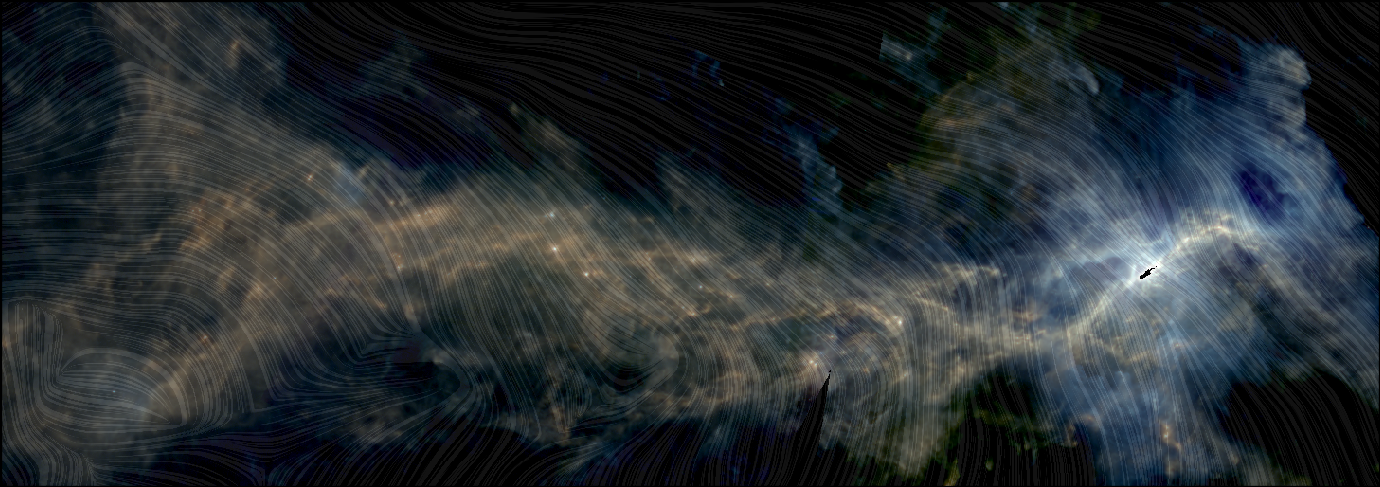
by Juan Soler, Max-Planck-Institut für Astronomie, Heidelberg, Germany
Machine vision is the set of tasks for gaining a high-level understanding of images sets, automating or enhancing the tasks that the human visual system can do.
In this talk, I will describe how we used basic techniques of machine vision for the analysis of the recent observations of the dust polarized emission with the Planck and BLASTPol instruments. I will report how these techniques are providing crucial insight into how magnetohydrodynamic (MHD) turbulence is structuring the interstellar medium (ISM).
Finally, I will show how the extensions of these machine vision techniques can be used to look for the imprints of the molecular cloud formation and destruction in the extended HI and 13CO observations from the THOR and GRS surveys of the Galactic plane.
(Abstract PDF)
First astrophysical observations of the helium hydride ion (HeH+) in a planetary nebula
by David Neufeld, Johns-Hopkins-University
More than four decades after the helium hydride ion was first recognized as potentially-detectable interstellar molecule, its first astrophysical detection was obtained recently (Güsten et al. 2019, Nature) with the use of the German Receiver for Astronomy at Terahertz Frequencies (GREAT) on the Stratospheric Observatory for Infrared Astronomy (SOFIA) to observe the fundamental rotational transition at 2010.184 THz (149.137 µm) toward the planetary nebula NGC 7027. In this talk, I will discuss the discovery of astrophysical HeH+, its astrophysical significance, its astrochemistry in planetary nebulae, and recent ground-based observations that have led to the detection of HeH+ vibrational emissions from NGC 7027.
Towards a Unified Model for Star-formation

by Alvaro Hacar, Leiden University, The Netherlands
Using single-dish and ALMA molecular observations, we have investigated the internal structure of several paradigmatic nearby proto-clusters across their entire mass spectrum. In all cases, the analysis of different molecular line tracers indicates a high level of internal organization in which apparently monolithic clumps are actually complex networks of small-scale fibers. In both low- and high-mass clusters, fibers are characterized by presenting transonic internal motions respect to their local sound speed and a mass per-unit-length close to hydrostatic equilibrium. Conversely, the fiber dimensions (width and length) appear to be self-regulated depending on their intrinsic gas density of their local environment. Combining observations in different star-forming regions, we identify a systematic increase of the surface density of fibers as a function of the mass of these systems. Based on this empirical correlation, we propose a unified star-formation scenario where the observed differences between low- and high-mass clouds, and the origin of clusters, emerge naturally from the initial concentration of fibers.
(Abstract PDF)
Sommer Term 2019
Exploring the H3+ and H4+ Potential Energy Landscape by Photodissociation and Reactive Scattering
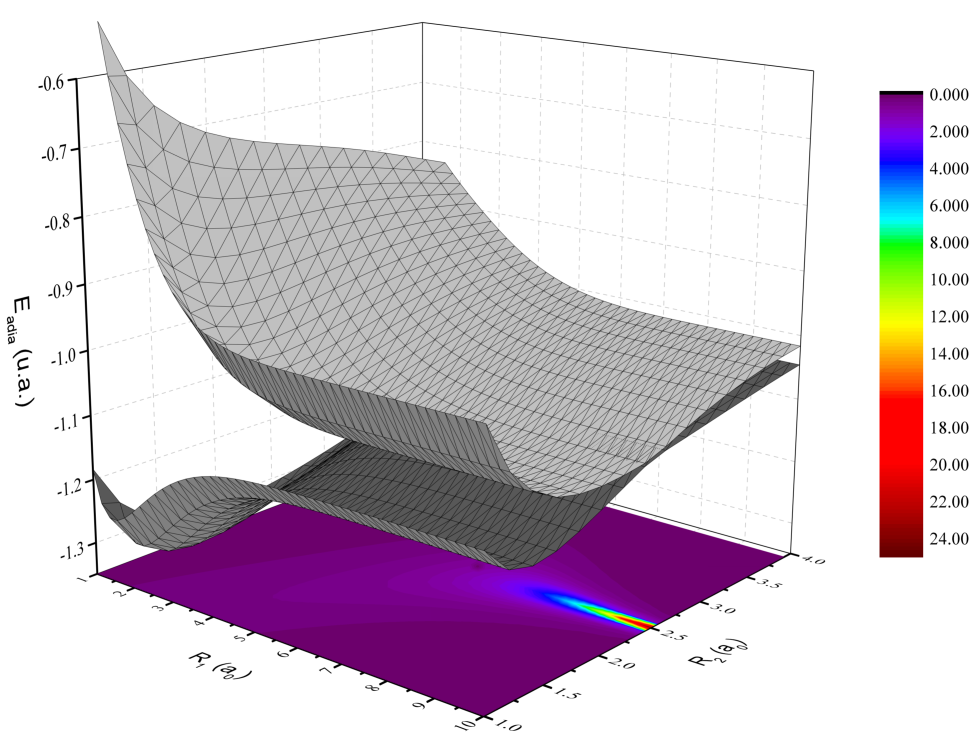
by Xavier Urbain, Institute of Condensed Matter and Nanosciences, Université catholique de Louvain, Belgium
The H3+ and H4+ species both exhibit a rich potential energy surface topology, which affects their collisional and laser induced dynamics. We have investigated the charge transfer and atom interchange in a series of fast-beam experiments.
Photodissociation experiments were conducted to investigate the role of the avoided crossing seam between the ground and first excited potential energy surface of H3+[1]. Three-dimensional imaging of dissociation products was used to determine the kinetic energy release and branching ratio among the fragmentation channels. Vibrational distributions were measured by dissociative charge transfer of H2+ products. It is found that the photodissociation of hot H3+ in the near ultraviolet produces coldH2+, but hot H2. Modelling the wavepacket dynamics along the repulsive potential energy surface accounts for the repopulation of the ground potential energy surface. The important role of the H3+ avoided crossing seam for the astrophysically relevant H2+ + H2 charge transfer reactions [2] will be underlined.
The partially deuterated isotopologues of H3+, i.e. H2D+ and D2H+, have pure rotational spectra that can be excited at prestellar core temperatures, allowing for the total H3+ abundance to be inferred, provided the deuterating reactions of H3+ are well understood. Here, we present laboratory measurements of the rate coefficients for the reactions of atomic D with H3+, H2D+, and D2H+. The measurements were performed using a dual-source, merged fast beams apparatus [3]. In addition, high-level quantum ab initio calculations have been carried out to model the zero-point-energy corrected energy profile and the shape of the potential energy barrier, allowing an evaluation of tunneling effects. From the combination of our experimental and theoretical results, we derive thermal rate coefficients in the temperature range relevant for prestellar cores [4].
[1] X. Urbain, A. Dochain, R. Marion, T. Launoy, and J. Loreau 2019 Phil. Trans. R. Soc. A (submitted).
[2] X. Urbain, N. de Ruette, V.M. Andrianarijaona, M.F. Martin, L. Fernández Menchero, L. Errea, L. Méndez, I. Rabadán, B. Pons 2013 Phys. Rev. Lett. 111 203201.
[3] A. P. O'Connor, X. Urbain, J. Stützel, K. A. Miller, N. de Ruette, M. Garrido, and D. W. Savin 2015 ApJ Suppl. 219 6.
[4] P.-M. Hillenbrand, K. P. Bowen, J. Liévin, X. Urbain, and D. W. Savin 2019 ApJ (submitted).
(Abstract PDF)
Cosmic Star Formation as Seen from the Milky Way
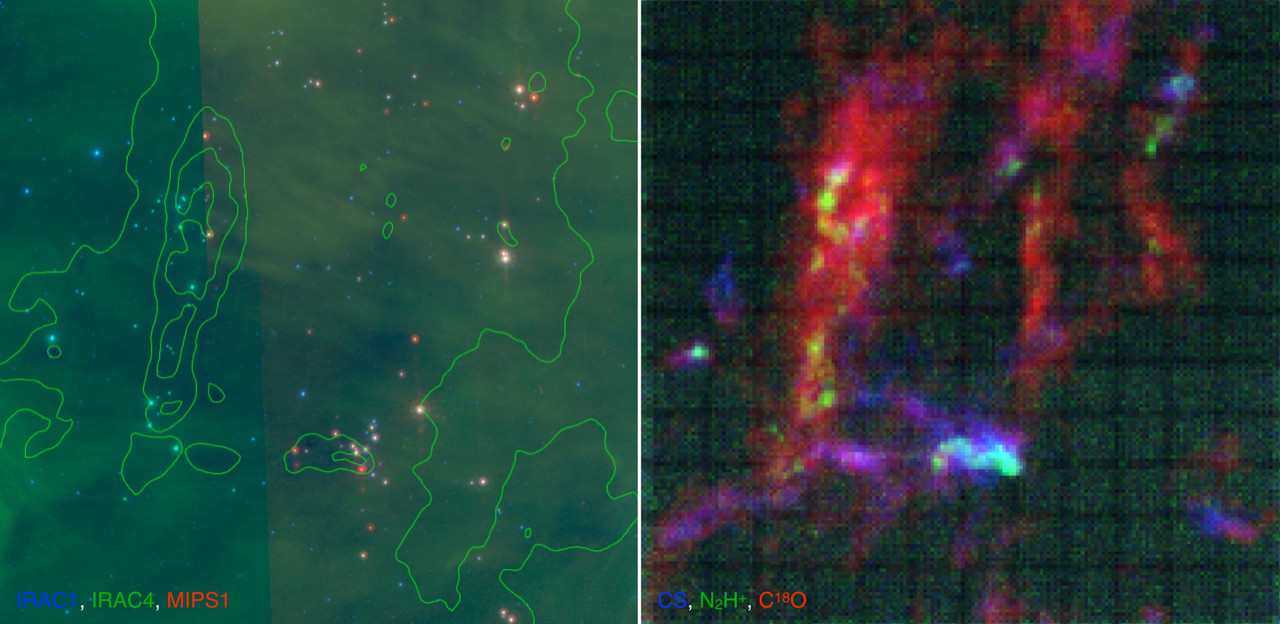
by Jens Kauffmann, Haystack Observatory, Massachusetts Institute of Technology, MA, USA
Star formation is the key astrophysical process that converts baryonic matter into the stars and planets that form the backbone of galaxy structure. Many details of the star formation process can only be investigated in the Milky Way. Such research thus provides us with important information about the evolution of the gas and the stars in galaxies over cosmic time.
I will discuss two studies of star formation in the Milky Way that seek to advance our understanding of cosmic star formation. First, I will talk about research into Galactic Center molecular clouds with ALMA and other interferometers. This informs us about star formation under extreme conditions, resembling those found in starburst galaxies. Second, I will present results from the LEGO Large Program on the IRAM 30m–telescope, which obtains the most comprehensive wide–field spectroscopic views of molecular clouds available to date. Such work shows us how we can characterize spatially unresolved gas in other galaxies, and it reveals the astrochemistry of star and planet formation at an unprecedented level of detail.
(Abstract PDF)
Extended Townes-Dailey Analysis and Four-Fold Internal Rotation
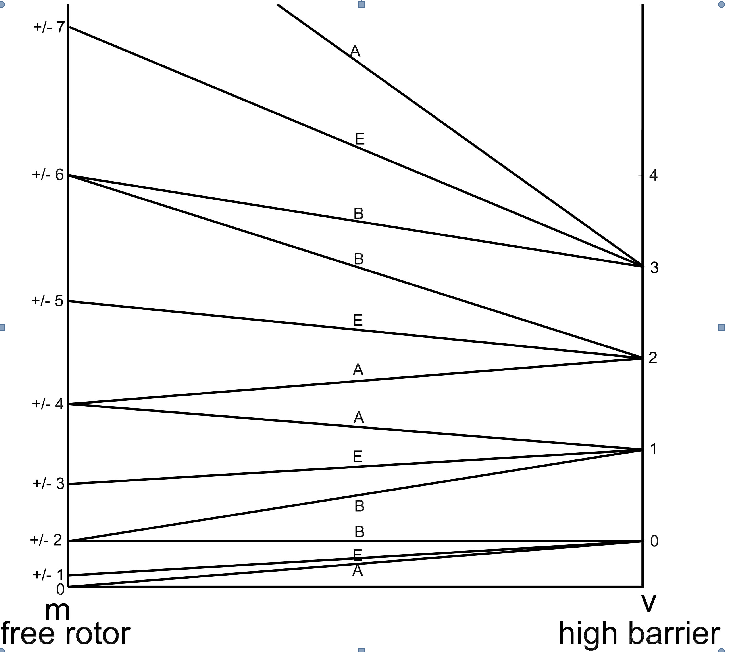
by Stewart Novick, Wesleyan University, Middletown, CT, USA
This talk (might) cover three topics, depending on time. Topic1, The use of the Extended Townes Dailey (ETD) analysis to understand the two hyperfine tensors of 2-bromopyridine. The ETD analysis is a generalization on the original Townes-Dailey analysis, which involved determining the only one component of the nuclear quadrupole coupling tensor, With ETD, all component of the tensor are predicted, including when the orbitals of atom in question is hybridized. With this as a background, the ETD analysis will be used to try to understand how the p orbitals on nitrogen could generate an eQq of CN+ of +5.0 MHz. Topic 2, The first high resolution study of the torsional splittings of a four-fold internal rotor, vinylsulfur pentafluoride. Topic 3, will be on spin statistics made (overly) simple. This part of the talk is pedagogical, and should be useful for researchers and students.
Chart caption: Correlation diagram for the four-fold internal rotor
(Abstract PDF)
Linking the Initial Conditions of Star Formation to Galactic Environment
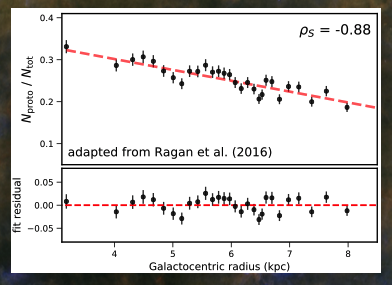
by Sarah Ragan, Cardiff University, UK
Surveys of the Milky Way plane in a variety of gas or dust tracers have helped us develop an understanding of how the physical conditions of the interstellar medium vary throughout the Galaxy. We are now able to investigate what role Galactic environmental factors might play in giving rise to the conditions conducive to star formation. I will discuss a recent study conducted using the Herschel Infrared Galactic Plane Survey (Hi-GAL), which has catalogued over 100000 compact objects, or "clumps", throughout the plane and characterised their properties by modelling their spectral energy distributions (SEDs). We find that although the spiral arms of our Galaxy are where clumps are primarily (though not exclusively) concentrated, the clumps found in arms are not significantly more likely to be star-forming than interarm clumps. We also find a notable gradient in the prevalence of star formation in clumps with Galactocentric radius. I will also discuss our studies of "giant" 100-parsec scale molecular filaments in the Galaxy which enable us to link the clump scales up to Galactic scales. A comprehensive profile of the Milky Way from parsec to kiloparsec scales provides us with the appropriate context in which we can understand star formation in other galaxies.
(Abstract PDF)
Radiative Feedback and PDRs in Orion
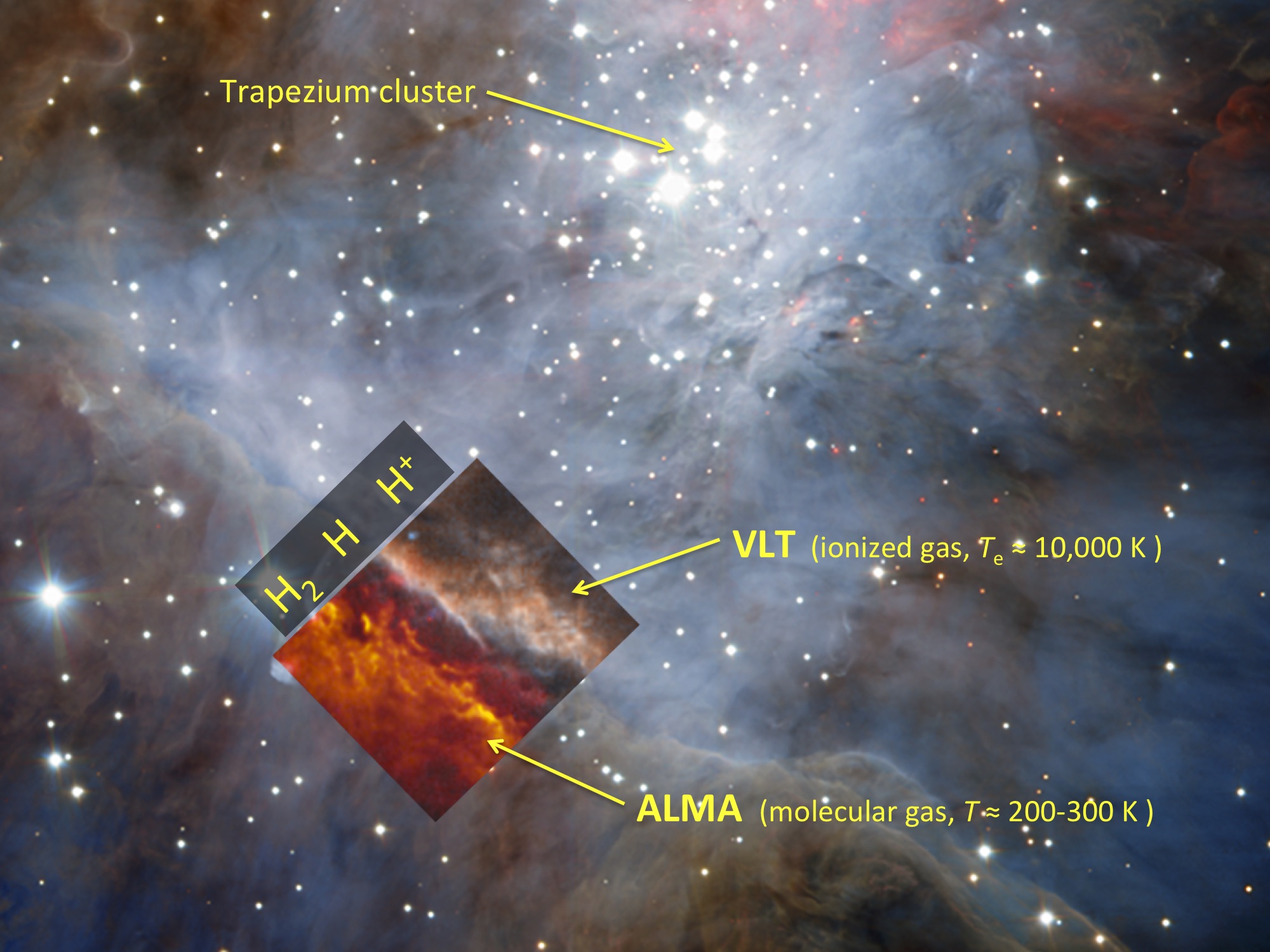
by Javier R. Goicoechea, Instituto de Fisica Fundamental, CSIC, Madrid, Spain
Young massive stars regulate the dynamics, ionization, and fate of their parental molecular cloud. Modern day telescopes provide a wealth of spectroscopic tracers to better understand and quantify stellar feedback processes at very different spatial scales: from a few hundred AU (with ALMA mosaics) to several parsec scales (with Herschel, SOFIA and IRAM 30m maps). The detection of very extended emission from C+, PAHs, vibrationally excited H2, mid-J CO lines, and reactive molecular ions such as CH+, probes the interaction between stellar far-UV radiation (E 13.6 eV) - emitted by nearby hot stars - and their interstellar environment. In this seminar I will summarize the main results of our program to observe the famous Orion (M42) region with the above observatories. I will try to demonstrate the dynamical and non-equilibrium nature of the interaction between stellar far-UV radiation and winds with their parental cloud. These questions are at the core of our understanding of stellar feedback, a collection of complicated processes that take place at many galactic scales and drive the evolution of the ISM. Our detailed view of Orion allows us to reveal the underlying physical and chemical processes. These can later be generalized to other far-UV irradiated environments, including proplyds, planetary nebulae, molecular cloud surfaces, as well as much more massive and extreme star forming regions in starburst galaxies.
(Abstract PDF)
The Intricate Role of Cold Gas and Dust in Galaxy Evolution at Early Cosmic Epochs
by Dominik Riechers, Department of Astronomy, Cornell University, USA
Great progress has been made over the past two decades i constraining the star formation history of the universe, but our understanding of how cosmic star formation is fueled by cold gas at high redshift is currently informed primarily by specific, and potentially biased samples of galaxies. To overcome these limitations, we have carried out the CO Luminosity Density at High Redshift (COLDz) survey, a large volume line scan search for cold molecular gas in galaxies at redshifts 2-3 and 5-7 with the Karl G. Jansky Very Large Array (VLA). The resulting measurement of the "cold gas history of the universe" near the peak epoch of cosmic star formation and in the first billion years of cosmic time provides important information on the fueling mechanisms that drive cosmic star formation. Surveys like COLDz set the necessary broader context for targeted in-depth studies of the physical properties of star formation in different galaxy populations back to the earliest epochs with the Atacama Large sub/Millimeter Array (ALMA). Such studies fundamentally enhance our picture of early galaxy evolution by providing a better understanding of the stellar mass buildup, and they are a critical pathfinder toward galaxy and large-scale structure surveys in the early universe with the most powerful upcoming facilities, in particular the Next Generation Very Large Array (ngVLA) and CCAT-prime.
From Cosmic Web to Molecular Clouds: the Multiple Scales of Star Formation
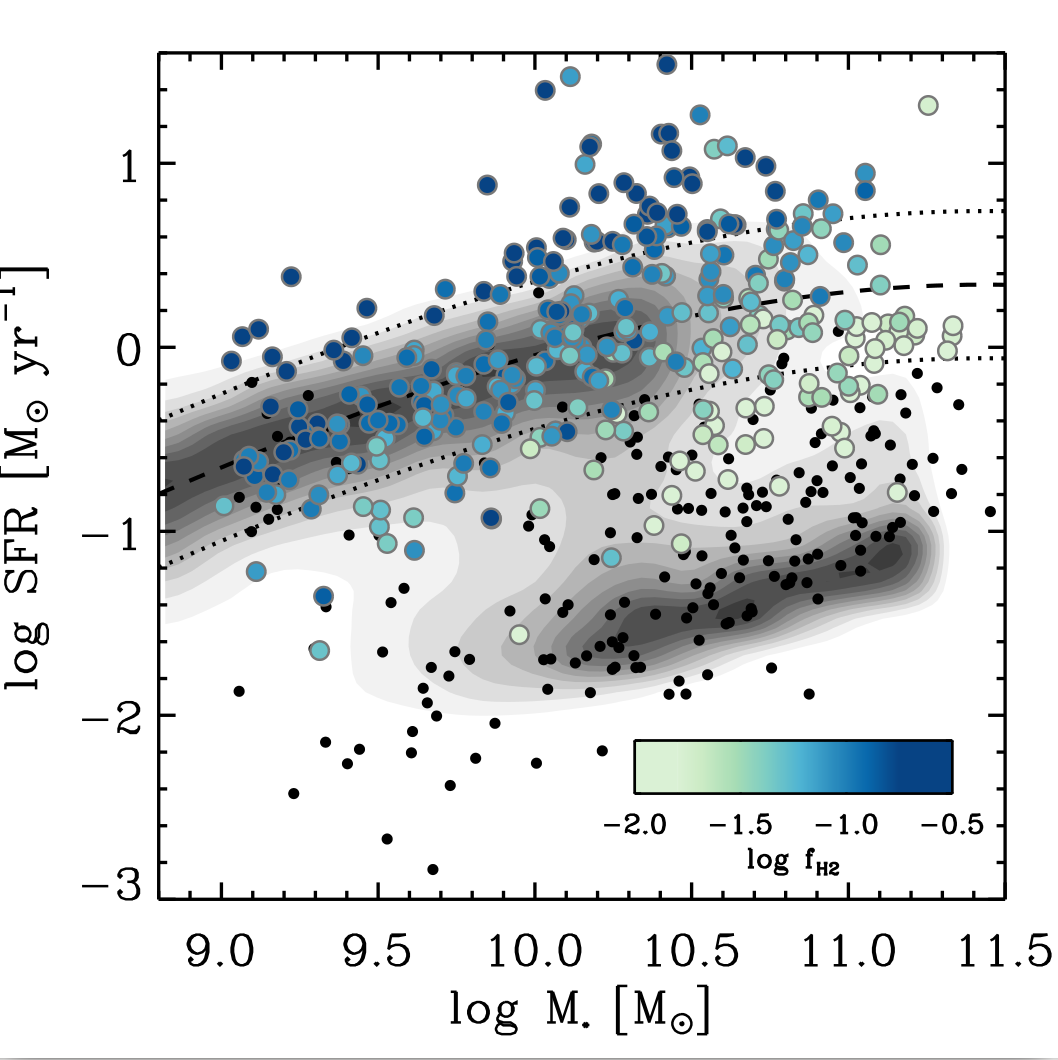
by Amelie Saintonge, Department of Physics and Astronomy, University College London, UK
Observations of molecular gas and dust in distant galaxies are experiencing a coming-of-age, transitioning from a "discovery" to a "survey" mode. New and upgraded facilities are now making it possible to survey the cold interstellar medium efficiently for large galaxy samples, and these observations are proving to be critical in refining our general picture of galaxy evolution. In this talk, I will review results from a number of new large surveys for molecular gas and dust across the galaxy population at low and high redshifts, and show how they combine to lend strong support in favour of the "equilibrium" model for galaxy evolution, under which most of galaxy evolution is regulated by gas inflows and outflows, and by the efficiency of the star formation process. These results highlight the multi-scale nature of the galaxy evolution problem, from gas flows along the cosmic web to the small-scale physics of star formation, and the need to investigate new tools to study the cold interstellar medium of distant galaxies.
(Abstract PDF)
Winter Term 2018/19
ISM Dynamics and Star Formation
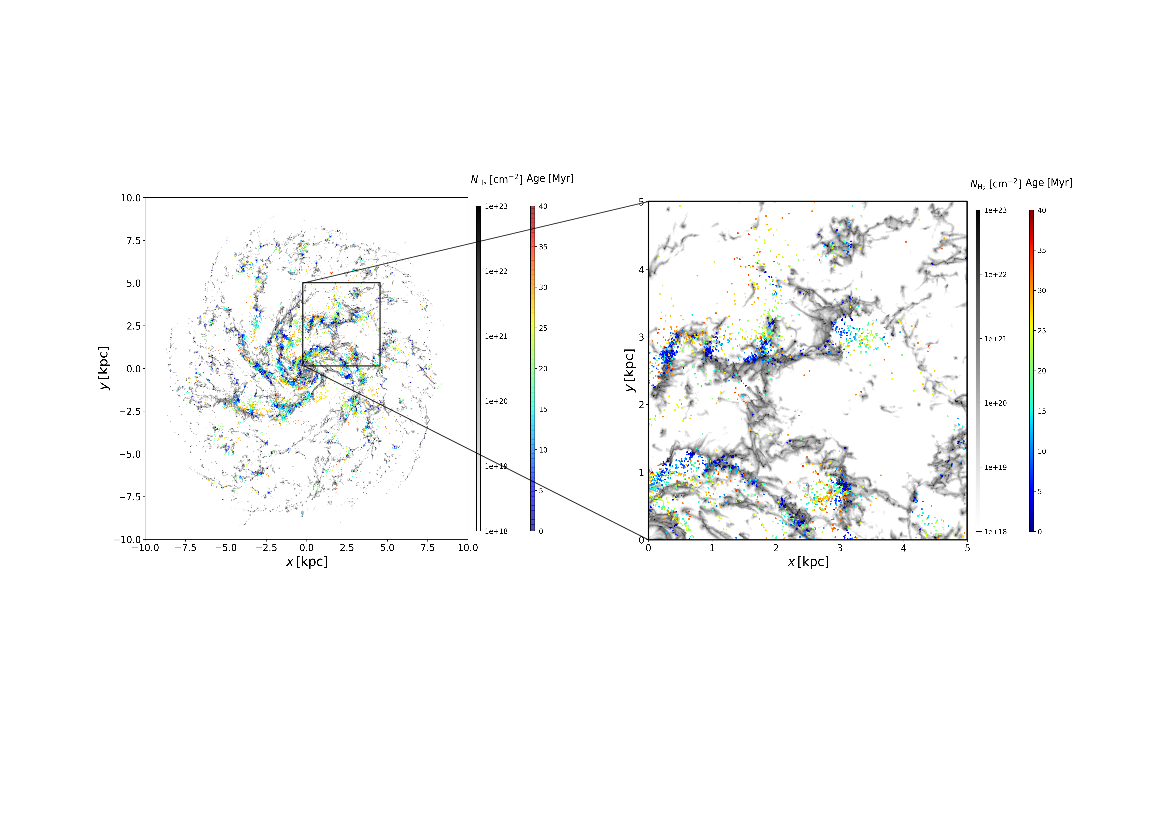
by Ralf Klessen, ITA, Universität Heidelberg, Germany
Stars and star clusters form by gravitational collapse in regions of high density in the multi-phase interstellar medium. The process of stellar birth is controlled by the complex interplay between the self-gravity of the star-forming gas and various opposing agents, such as supersonic turbulence, magnetic fields, cosmic ray and gas pressure, or stellar feedback in form of radiation, winds, and supernovae. Turbulence plays a dual role. On global scales it provides support, while at the same time it can promote local collapse. This process is modified by the thermodynamic response of the gas, which is determined by the balance between various heating and cooling processes, which in turn depend on the chemical composition of the material. I will review the current status of the field and discuss a few examples of recent progress.
(Abstract PDF)
Multifractal Analysis of Herschel/Hi-GAL Observations: First Results
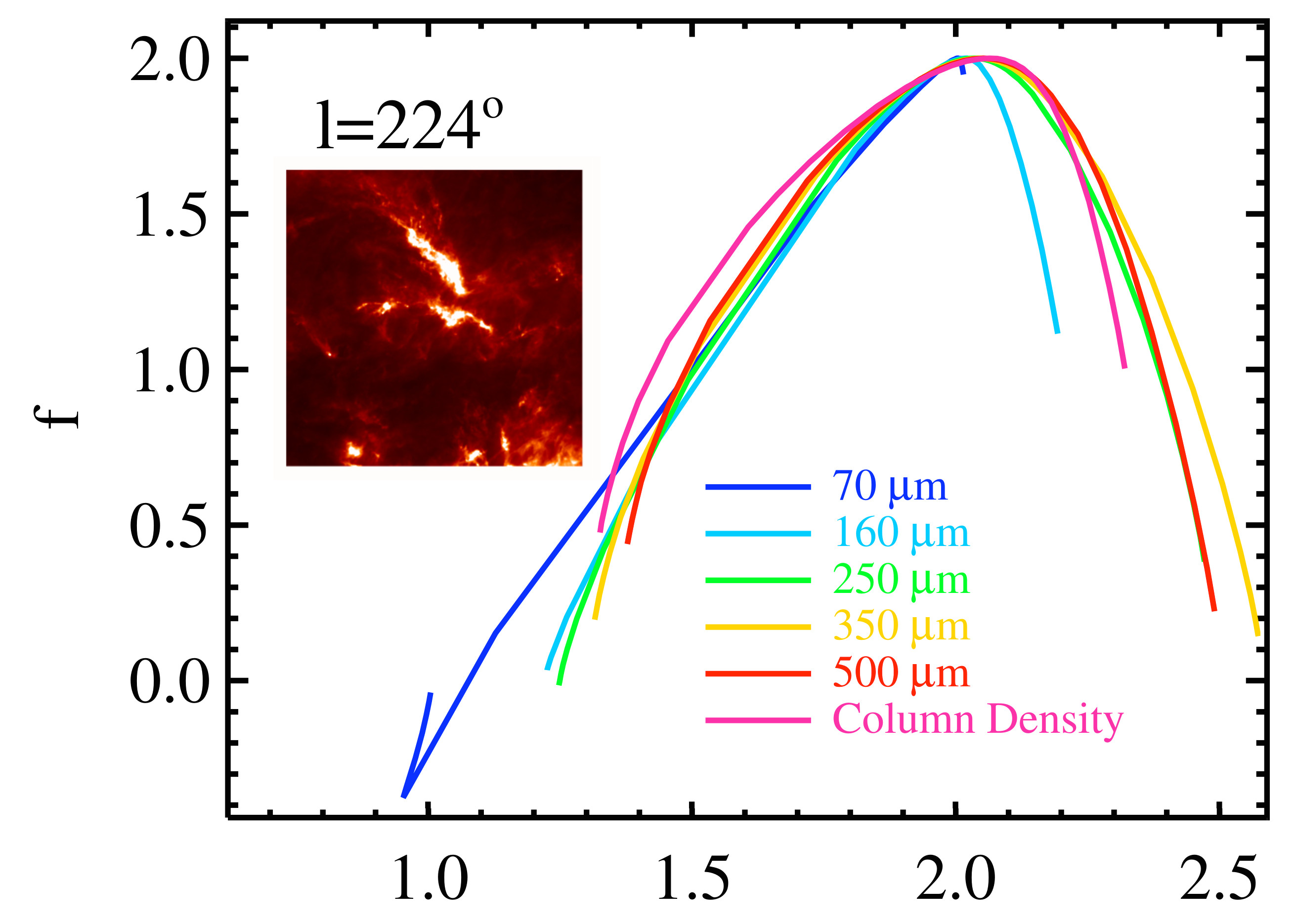
by Davide Elia, Istituto di Astrofisica e Planetologia Spaziali, INAF, Roma, Italy
The images of the interstellar clouds, obtained observing molecular lines or dust continuum emission, exhibit a certain degree of self-similarity, generally ascribed to internal turbulence. The fractal geometry is therefore invoked to provide a quantitative description of the cloud morphology. As a further development, the multifractal approach is based on a continuous spectrum of exponents rather than on a single descriptor (the fractal dimension). It is more suitable to describe sets of intertwined fractals, showing a deviation from a strict self-similarity, which is typical of natural (stochastic) fractals, including clouds. However, the multifractal geometry remained an underexploited approach to describe and quantify the large-scale structure of interstellar clouds. I'll describe how multifractal analysis was applied to Herschel far-infrared (70-500 ?m) dust continuum maps, representing an ideal case of study. In particular, I computed the so-called multifractal spectrum and generalized fractal dimension of six Hi-GAL regions in the third Galactic quadrant, measuring systematic variations of the spectrum at increasing wavelength, which generally correspond to an increasing complexity of the image. Furthermore, I found a peculiar behaviour for each investigated field, strictly related to the presence of high-emission regions, which in turn are connected to star formation activity. The same analysis was also applied to synthetic column density maps, generated from numerical turbulent molecular cloud models and from fractal Brownian motion, allowing for the confrontation of the observations with models with well controlled physical parameters. I will discuss the results for both these classes of images. Finally, the link between mono-fractal parameters and multifractal indicators was investigated: I will describe common trends, but also differences highlighting the fact that multifractal analysis can offer a more extended and complete characterization of the cloud structure.
(Abstract PDF)
Models of Isotope and Spin-state Chemistry in Star-forming Clouds
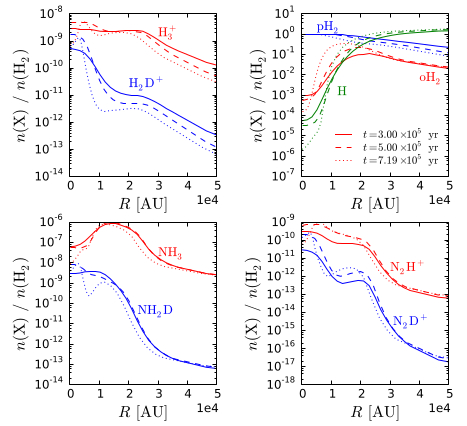
by Olli Sipilä, Max-Planck-Institut für Extraterrestrische Physik, Garching, Germany
The high density and low temperature in the central areas of star-forming cloud cores leads to the efficient depletion of various molecules onto the surfaces of interstellar dust grains. This severely limits the number of available tracer molecules that we can use to obtain information on, e.g., the gas temperature in these conditions. Fortunately, the onset of depletion allows deuterium chemistry to proceed, and indeed the abundances of deuterated molecules tend to peak toward high-density regions where depletion is strong. This provides us with unique observational tools to study the physical properties of star-forming cores, and hence it is highly desirable to develop detailed models of deuterium chemistry in order to understand the observations. Deuterium chemistry is strongly affected by spin-state chemistry, and in fact spin states can play a role in the formation of heavier species, such as ammonia, as well.
In this talk I will discuss in detail the connection of isotope (in particular deuterium) and spin-state chemistry, and will describe how studies of these topics allow us to understand the initial stages of the star-formation process better. I will introduce several past and present modeling efforts in this context, and will also outline future prospects that will further enhance our understanding of interstellar chemistry.
(Abstract PDF)
Simulating Cosmic Ray-Driven Processes in Astrochemical Models: How and Why

by Christopher Shingledecker, Max-Planck-Institut für Extraterrestrische Physik, Garching, Germany
Material in the ISM is subjected to bombardment by several types of ionizing radiation including cosmic rays, stellar winds, x-rays, and gamma-rays from radionuclide decay. It is known that such radiation can have a significant physicochemical impact on interstellar environments, and a large body of experimental work has shown that the interaction between such energetic particles and low-temperatures ices can result in the formation of complex - even prebiotic - molecules. Even so, modeling the chemical effects of cosmic ray collisions with interstellar dust grain ice mantles has proven challenging due to the complexity and variety of the underlying physical processes. In this talk, we review recent work by us on the methods of incorporating such processes into astrochemical models, as well as their effects on cold core simulations.
(Abstract PDF)
Reactions of Molecules on Ice Nanoparticles: Synthesis of Complex Molecules from Simple Precursors in the Space

by Michal Fárník, Academy of Sciences of the Czech Republic, Prague
Extremely low densities leading to rare collisions between molecules and low temperatures in the majority of the interstellar space make it a very unfriendly environment for any kind of chemistry. Thus, the more complex molecules in the space have to be formed either in barrier-less ion-molecule reactions or reactions on ice/dust particles, which can adsorb reactant molecules on surfaces for long times.
In our laboratory, we can investigate the reactions on ice nanoparticles in a complex molecular-beam apparatus. Beams of different ice nanoparticles are produced in supersonic expansions. The nanoparticles fly isolated in vacuum and cool down by evaporation to typical temperatures of 10-100 K. Thus they represent good proxy for astronomical ices. As they pass through several pick-up cells, the nanoices can pick-up various gas-phase molecule on their surfaces. Then reactions can be triggered by photons (UV or IR) or electrons (fast, ~100 eV, causing ionization or slow, 0-10 eV, leading to the electron attachment), and we observe the reactions by mass spectrometry, velocity map imaging and other techniques.
Several examples of such investigations will be presented: pickup and coagulation of simple molecules on pure water-ice nanoparticles, generation of biologically relevant hydrogen bonds between molecules adsorbed on ices, ionization of doped ammonia ices, reactions of methanol and formic acid on ices, etc.
(Abstract PDF)
Following the Interstellar Gas and Ice through the Formation of Stellar Nurseries
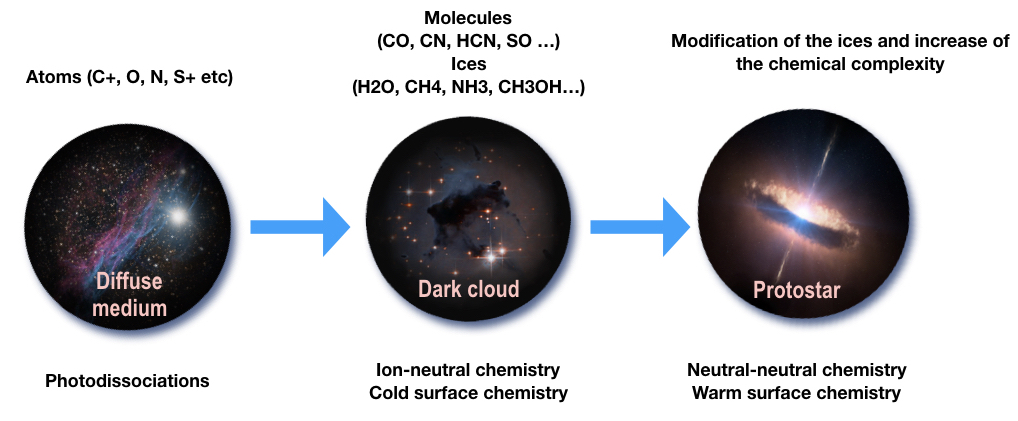
by Valentine Wakelam, Laboratoire d'Astrophysique de Bordeaux, Univ. Bordeaux/CNRS, France
Carbon and heavier atoms are born in the centre of stars. At the end of their life, stars spread their inner material into the diffuse InterStellar Medium (ISM), yielding at the same time the formation of interstellar dust refractory cores. This diffuse medium (where photo-dissociation dominates the chemistry) gets locally denser in the form of dark clouds whose innermost part is shielded from the external UV field by the dust, allowing for molecules to grow and get more complex. As dust grains start to be covered by molecules, they also undergo coagulation. Gravitational collapse occurs inside these dense clouds forming protostars and their surrounding disks, and eventually planetary systems like (or unlike) our own solar system. Throughout all these stages, chemistry keeps evolving far from the equilibrium/steady-state set by physical conditions.
In recent years, our knowledge on the composition of the ISM and the process of star formation has entered a new area with the powerful capabilities (in term of sensitivity, spatial resolutions and/or new wavelength windows) of recent ground based and space observatories (Spitzer, Herschel, ALMA, NOEMA, and the new EMIR receiver on the IRAM 30m). These new instruments have allowed for the detection of new molecules (in the gas-phase or in the ices), either simple ones such as HCl+ or complex ones such as CH3NCO. In addition to revealing the richness of the ISM chemistry, they have revealed the non-uniform distribution of their abundances from object to object or even within a certain type of object (with similar physical conditions). One of the key questions astrochemists want to answer is: how do these molecules in the gas-phase or in the ices form and can we reproduce their variability in abundance?
In this presentation, I will describe the tools and methodology used to study the chemical composition of the interstellar medium and what we think we currently know about it.
(Abstract PDF)
Characterising the Physical Properties of the ISM from Molecular Emission
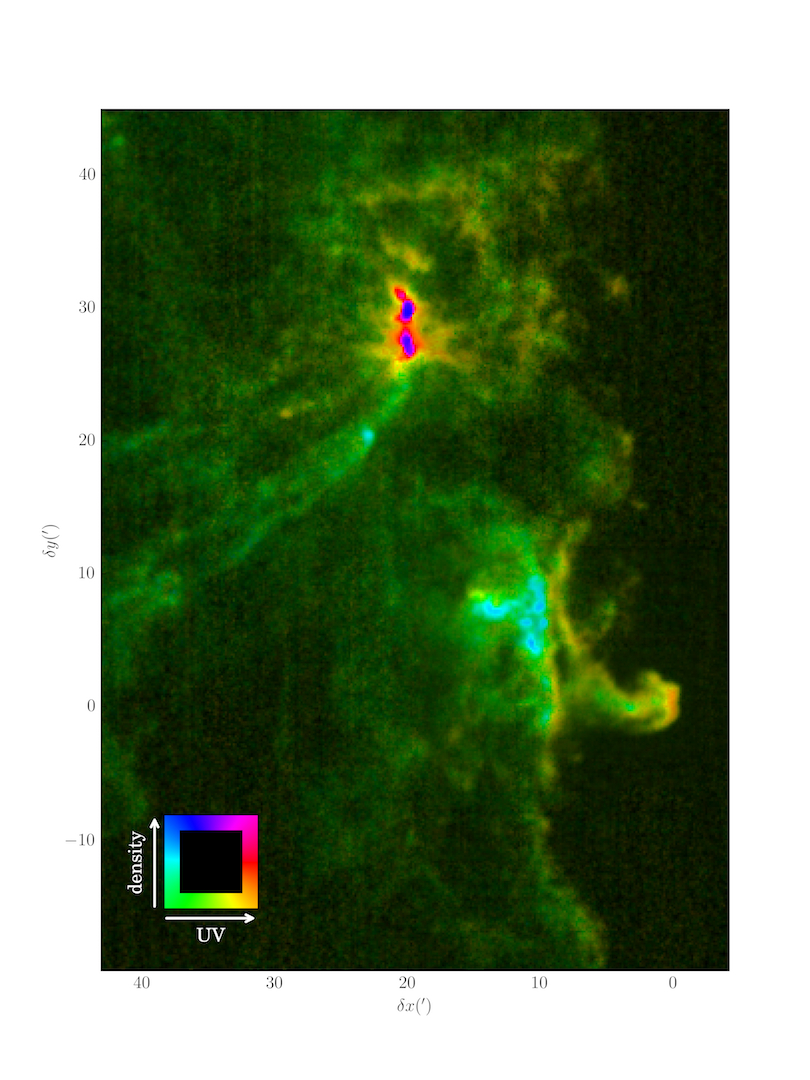
by Pierre Gratier, Laboratoire d'Astrophysique de Bordeaux, Univ. Bordeaux/CNRS, France
New receivers and spectrometers installed at millimeter and submillimeter telescopes now have very large bandwidths spanning tens of gigahertz at very high resolutions (~50-200kHz) yielding spectra comprising of hundred of thousands channels. These observing modes are now standard, which means that spectral surveys are now the observations obtained by default. With these instruments, large, several square degree, maps of the ISM are starting to be observed yielding massive hyperspectral datasets combining the emission of tens of species. The observed line intensities are function of both the ISM chemical composition and physical condition; using these molecular datasets it is possible to extract these ISM properties. In the framework of the ORIONB IRAM 30m large program we have developed statistical methods to study the physical conditions of the ISM solely from the observed molecular emission. I will present in particular:
i) the application of a Principal Component Analysis to decompose the maps into regions of low/high density and low/high UV illumination (Gratier et al. 2017),
ii) the application of the MeanShift clustering algorithm to segment the molecular cloud into physically and chemically similar regions (Bron et al. 2018) and,
iii) preliminary results on the application of supervised machine learning to infer the total column density from molecular emission.
(Abstract PDF)
New Simulations and Observations of Highly-complex Molecules in Star-forming Regions
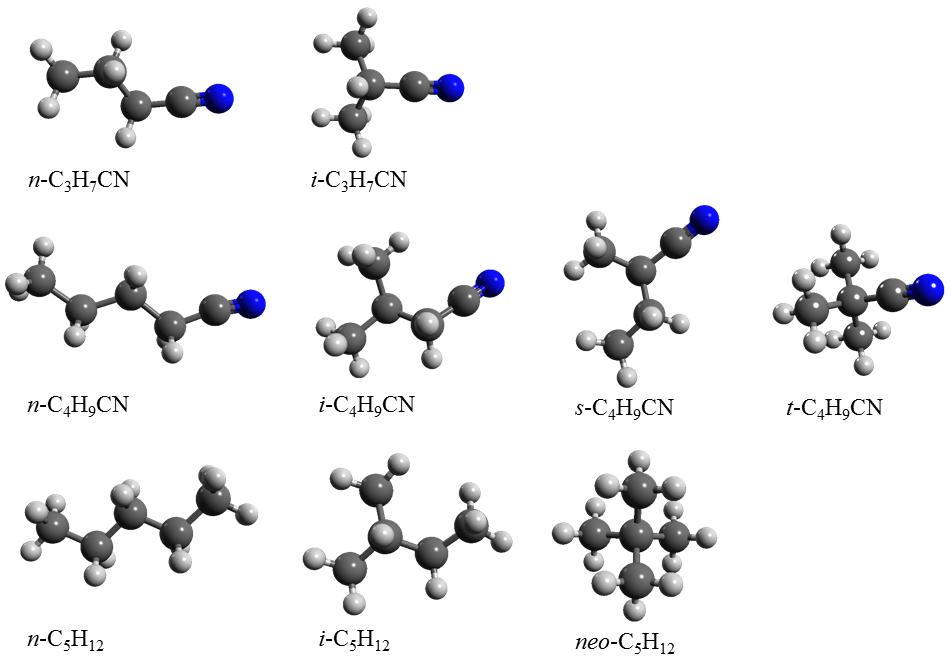
by Robin Garrod, University of Virginia, USA
The interstellar medium (ISM) is replete with molecules, and high-mass star-formation regions in particular are host to some of the most complex organic molecules yet detected outside of our solar system. Millimeter/sub-millimeter wavelength spectral data from the ALMA telescope allows us to explore the chemistry of such regions in much greater detail than ever before. The ALMA 3mm line survey EMoCA ("Exploring Molecular Complexity with ALMA") of the chemically-rich Galactic Center source Sagittarius B2(N) has not only identified several new molecules in that source, but has led to the identification of new hot cores - a total of five are now known to exist in Sgr B2(N).
I will give a brief overview of the molecular detections made by EMoCA toward Sgr B2(N). I will also present chemical kinetics models of the coupled gas-phase and grain-surface/ice-mantle chemistry occurring in Sgr B2(N) related to these molecules, with an emphasis on the treatment of the recently-detected branched carbon-chain molecule iso-propyl cyanide (i-C3H7CN). I will assess the possibilities for the presence and detectability of other branched carbon-chain molecules in the ISM. I will also present recent work that uses complex molecule abundances to constrain the cosmic-ray ionization rates and chemical timescales within different hot cores.
(Abstract PDF)
On the Formation of OB Stars: Clouds, Filaments, Cores, and the Role of Stellar Feedback
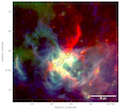
by Nicolas Peretto, Cardiff University, UK
The initial conditions of star formation are imprinted within the properties of the many interstellar gaseous structures that are involved in the process. Understanding what physical mechanisms drive star formation therefore requires a detailed understanding on what regulates the dynamical evolution of the interstellar gas, from large diffuse clouds to these compact balls of nuclear burning gas. Mostly driven by the powerful combination of recent sensitive sub-millimeter large-scale surveys of star-forming clouds and high-angular resolution follow-up observations of selected sources, significant progress has been made in our understanding of star formation in the past decade. However, despite such progress, fundamental questions regarding, for instance, the pace at which gas flows from large to small scales and the origin of the low star formation efficiency within molecular clouds, still remain highly debated. In this context, I will present recent results on the properties of massive-star-forming molecular clouds from tens of parsec scales down to a few thousand AU scales. More specifically, I will be focusing on three key aspects: the evolution of cloud virial ratios as a function of cloud sizes; gravitational collapse and the role of hub filamentary systems in the formation of massive cores; and the impact of feedback from OB stars on the gas properties of the parent clouds.
(Abstract PDF)
IRAM Status, Developments and Plans – Breaking the Path for Modern Millimetre Astronomy
by Karl Friedrich Schuster, IRAM, Grenoble, France
In 2019 IRAM will celebrate 40 years of existence and service to the astronomical community. Since the foundation of IRAM, operational and instrumental upgrades have kept IRAM at the forefront of millimetre wave astronomy. Over the last years IRAMs facilities NOEMA and the 30m telescope once more underwent rapid evolution and upgrades on all levels. I will describe the recent status of the observatories and the resulting scientific capabilities. While the upgrades provide vastly improved return for well-established science topics they also open up totally new approaches of astronomical research.
In a second part I will describe the challenges of the next steps as well as outline the ongoing developments and the current plans for the future of the IRAM facilities.
Sommer Term 2018
The Manifold Roles of Cosmic Rays in Star-forming Environments

by Marco Padovani, INAF-Osservatorio Astrofisico di Arcetri, Firenze, Italy
The study of the interaction of cosmic rays with the interstellar matter is a multi-disciplinary investigation that involves the analysis of several physical and chemical processes: ionisation of atomic and molecular hydrogen, energy loss by elastic and inelastic collisions, energy deposition by primary and secondary electrons, gamma-ray production by pion decay, the production of light elements by spallation reactions, and much more.
Cosmic-ray ionisation activates the rich chemistry of dense molecular clouds and determines the degree of coupling of the gas with the local magnetic field, which in turn controls the collapse timescale and the star-formation efficiency of a molecular cloud. In recent years a wealth of observations from the ground and from space has provided information and constraints that still need to be incorporated in a consistent global theoretical framework. My goal is to use the results of chemodynamical models and state-of-the-art numerical simulations supplemented by dedicated observations to provide a unifying interpretation of the data with a model of cosmic-ray propagation specifically developed to make predictions that can be tested against the observations.
Finally, I will talk about my most recent study: a mechanism able to accelerate local thermal particles in protostars that can be used to explain the high ionisation rate as well as the synchrotron emission observed towards protostellar sources.
(Abstract PDF)
Spectroscopy in Solid Para Hydrogen Matrices
by Yuan-Pern Lee, National Chiao Tung University, Taiwan
PGOPHER – A Program for Rotational, Vibrational and Electronic Spectra

by Colin M. Western, School of Chemistry, University of Bristol, UK
PGOPHER is a general-purpose program for simulating and fitting rotational, vibrational and electronic molecular spectra. It can be used with many different spectroscopic techniques, including microwave, infra-red, Raman, visible, ultra-violet and multiphoton spectra. It can handle many different types of molecule and interactions, including linear, symmetric and asymmetric tops, fine and hyperfine structure and perturbations. It can handle many states and species simultaneously. It is designed to be used both for analyzing unknown spectra and extracting information such as temperature and state populations from observations on known species. It is an open source program, and can be freely downloaded from a supporting website.
The talk will start with a tutorial style introduction to what the program can do, and how calculations can be set up, including an example of its use in undergraduate teaching labs. This will be followed by presentation of recent developments in the program for automatic and semi-automatic assignment of unknown spectra. Assignment of spectra remains a significant problem; it is not unusual for high resolution spectra to have 20,000 lines needing assignment, with little or no obvious pattern to the lines. PGOPHER has recently gained several tools to help with this, including several different types of plot, and methods of trying many different trial assignments, and these will be discussed.
(Abstract PDF)
Analysis of the Helicity Measured in Tomo-PIV Jet Experiments
by Rodion Stepanov, Institute for Continuous Media Mechanics of the Russian Academy of Sciences
Tomographic Particle Imaging Velocimetry (Tomo-PIV) is a new technique to determine three-dimensional velocity vector fields. Tomo-PIV measurements of turbulent swirling jets open new
explorations of mean-pulse interactions and pattern dynamics. We use TomoPIV data (resolution 0.84 mm) to analyse the 3D velocity field of turbulent swirling flows. The spatial distribution of the mean and fluctuating components of energy and helicity are studied. Helical turbulence excitation and decay along the stream of the jet strongly depend on the inflow swirl. We observe a spatial separation of the turbulent flows with opposite signs of helicity while integrated values are conserved. It is shown that the large scale helicity of a swirling flow cascades toward the small scales. Our results can be used to benchmark
numerical simulations with turbulent closure technique.
Looking into the Origins of Molecular Deuteration with SOFIA
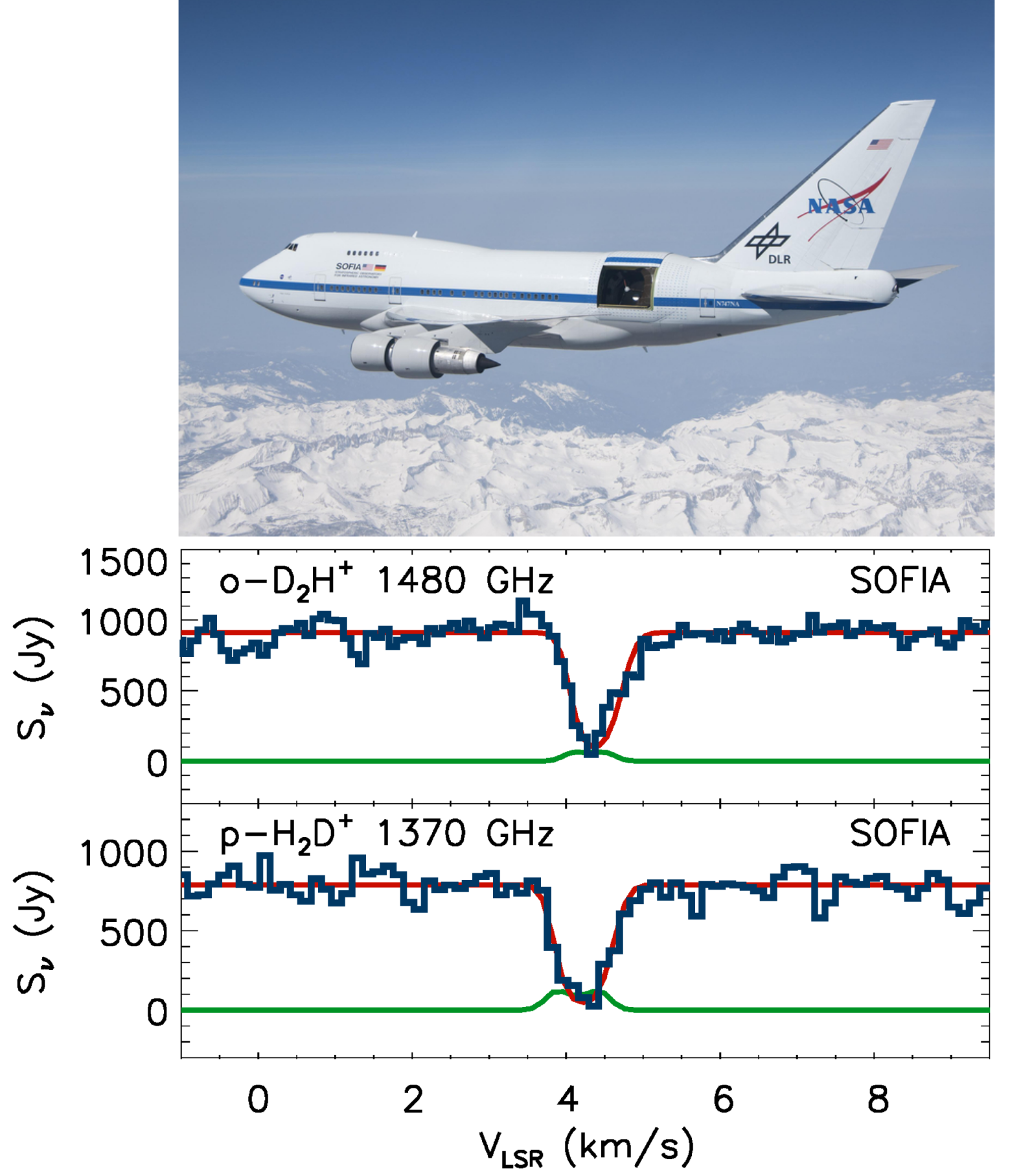
by Jorma Harju, Max-Planck-Institut für extraterrestrische Physik (MPE), Garching, Germany and Department of Physics, University of Helsinki, Finland
In this talk I discuss observational efforts with SOFIA aiming at a better understanding of deuterium chemistry in the interstellar space. The enhancement of deuterium in molecules above the cosmic D/H fraction is particularly strong in dense and cold interstellar clouds. These regions are cites of future star and planet formation. As evidenced by the oceanic D/H ratio, deuteration is also part of the chemical history of our Solar System. SOFIA, equipped with the GREAT receiver, is capable of observing fundamental transitions of the most important molecular carriers of deuterium: HD, H2D+, D2H+, D3+, and CH2D+. While HD is the main repository of deuterium in molecular clouds, the mentioned molecular ions work as mediators of deuterium between HD and heavier species. In addition to this gas-phase function, the dissociation of deuterated ions produces free D atoms that accrete onto grains and get involved in interstellar ices. The recently added capacity to observe the ground-state lines of the OH and OD radicals makes SOFIA useful for studying the deuteration of the closely related water in space. Combined with HDO, the abundances of these radicals can also be used for discriminating between gas-phase and grain-surface origins of water.
(Abstract PDF)
Shocks and Turbulent Dissipation in the Interstellar Medium
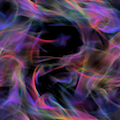
by Pierre Lesaffre, CNRS/LERMA/ENS, Paris, France
Typical velocities in the interstellar medium (ISM) are within an order of magnitude of the sound speed. Shocks should therefore be a ubiquitous component of this turbulent gas.
Ordered kinetic energy is converted into heat inside a shock's working surface, the thermal collisions excite the gas and the excitation energy is radiated away in their wake. Shocks should then be one of the most efficient ways to probe dissipation in our galaxy. However, their unambiguous observational characterisation has remained elusive in the dilute ISM.
A state-of-the-art shock models such as the Paris-Durham steady-state shock code has made tremendous progress in matching more and more complex observational results. However, its underlying geometry is plane-parallel while actual astrophysical shock working surfaces are likely entangled, or at least bent as in bow-shocks in the wake of runaway stars or at the tip of protostellar jets.
I will illustrate a simple method to approximate the actual geometry of 3D shocks thanks to a distribution of planar shocks. And I will show how in the course of the PhD thesis of Le Ngoc Tram this method could be used with great advantage to explain and reproduce the emission properties (line intensities and shapes) of molecular hydrogen in shocked gas.
(Abstract PDF)
Weak Gravitational Lensing - A Tool to Study Cosmology and Galaxy Astrophysics
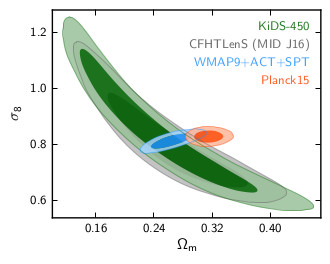
by Hendrik Hildebrandt, Argelander-Institut für Astronomie, Rheinische Friedrich-Wilhelms-Universität Bonn, Germany
Gravitational lensing represents a unique tool to study the dark Universe. In the weak lensing regime small distortions in the images of galaxies caused by the large-scale structure can be detected over the whole sky. Measuring these coherent distortions yields cosmological insights complementary to other probes like the cosmic microwave background (CMB). In this talk I will first briefly review the history of weak lensing measurements and then concentrate on recent results from the ongoing European Kilo Degree Survey (KiDS). These measurements show a mild tension with CMB measurements from the Planck mission when the standard cosmological model is assumed. Possible solutions to this discrepancy using extensions to the standard model of cosmology as well as poorly constrained astrophysical mechanisms like baryon feedback will be discussed. I will present how cross-correlating weak lensing observations with data at other wavelengths sheds light on these mechanisms, enhances our understanding of feedback processes, and - at the same time - leads to complementary and more robust cosmological conclusions.
(Abstract PDF)
The Hot Interstellar Medium
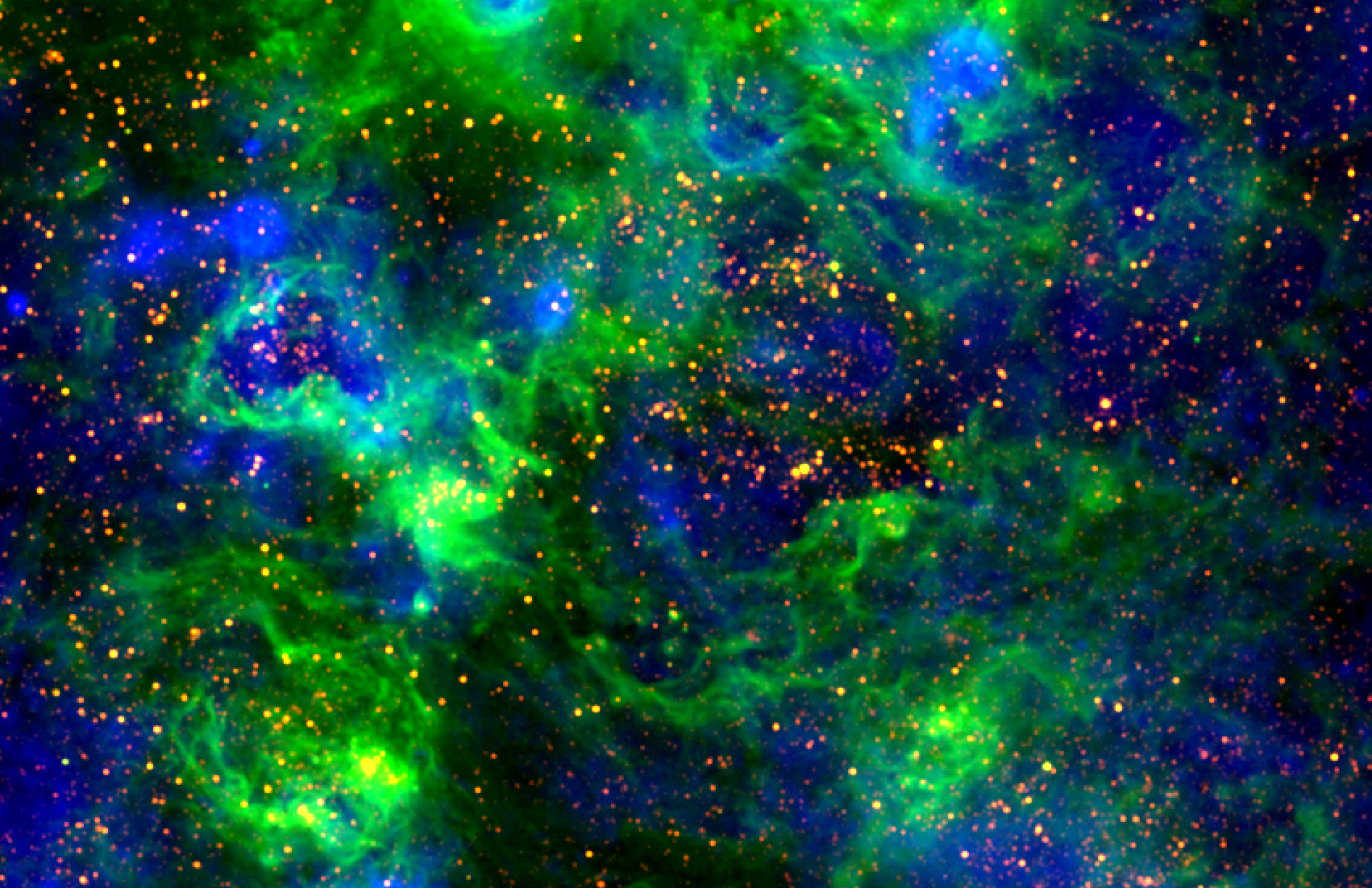
by Manami Sasaki, Dr. Karl Remeis Observatory, ECAP, Friedrich-Alexander-Universität, Erlangen-Nürnberg, Germany
Massive stars inject energy into the interstellar medium through radiation, which ionises their environment and creates HII regions. Their strong stellar winds form shock waves, which further heat and ionise the ambient gas. These shocks will create interstellar bubbles filled with hot thin plasma with temperatures of 10^6 - 10^7 K, which emits soft thermal X-rays. Finally, the massive stars finish their evolution in supernova (SN) explosions, which again heat and ionise the interstellar medium. Through observations over the entire electromagnetic spectrum we can study the cycle of matter in a galaxy and hence improve our understanding of the evolution of galaxies. I will present recent results of our studies of the hot interstellar medium in the Milky Way and nearby galaxies. I will discuss the physics of the hot plasma, the evolution and energetics of supernova remnants and superbubbles, and their impact on star formation.
(Abstract PDF)
Wide Fields of View at High and Low Frequencies
by Richard Hills, University of Cambridge, UK
Although early radio astronomy was dominated by observations requiring wide fields of view, such as all sky surveys, most of the work in the intervening years has been on studies of individual objects, so the focus has been on obtaining high angular resolution. Experiments involving large fields have recently become important again in several areas and this talk will discuss detailed aspects of two such cases. The first is the optics of the CCAT-prime telescope, where the concept of "coma-correction" is being applied to an off-axis design to obtain a field of view of more than 10 square degrees at sub-millimetre wavelengths. The second concerns the EDGES experiment - a single antenna observing the whole sky - where the detection of an absorption feature which may be due to the 21cm line of hydrogen at a redshift of ~17 has been announced. Here I will focus on the analysis of the data and ask how secure the detection really is.
Winter Term 2017/18
Cations in Motion

by Attila G. Császár, Eötvös Loránd University, Budapest, Hungary
The notion of molecules and structures is central to our chemical understanding of the nature surrounding us. One useful definition of neutral as well as charged molecules is that they correspond to minima on potential energy surfaces (PES) and the local PES must support at least one bound rovibrational state. The structure of a molecule is usually considered to be the geometry corresponding to the minimum. If a molecule exists and has a structure, it is also commonly accepted that its internal motions can be separated into vibrations and rotations, motions which usually have very different time and energy scales.
Nevertheless, there are chemical systems where both the notion of a molecule, that of a structure, as well as the separation of rotational and vibrational motion can be questioned. One part of the present lecture is centered around cations where the concept of a structure and the separation of vibrations and rotations seems to break down. Notably, cations characterized by bonds whereby the covalent bonding picture is challenged are prone to exhibit unusual structures and unusual quantum dynamical behavior. Highly excited states of “simple” molecules also exhibit unusual rotational-vibrational characteristics but in the cases of quasistructural cations it is not sufficient to keep the concept of a well-defined structure to explain the high-resolution spectrum of the molecule.
The lecture focuses on the following cations and their deuterated analogues: H3+, HeH2+, ArNO+, H5+, and CH5+. Not only bound but also rovibrational resonances are investigated for some of these cations. Fourth-age quantum chemical tools developed to understand the complex quantum dynamics of these cationic systems are presented and discussed briefly.
(Abstract PDF)
SOFIA’s Eye on the Galactic Center
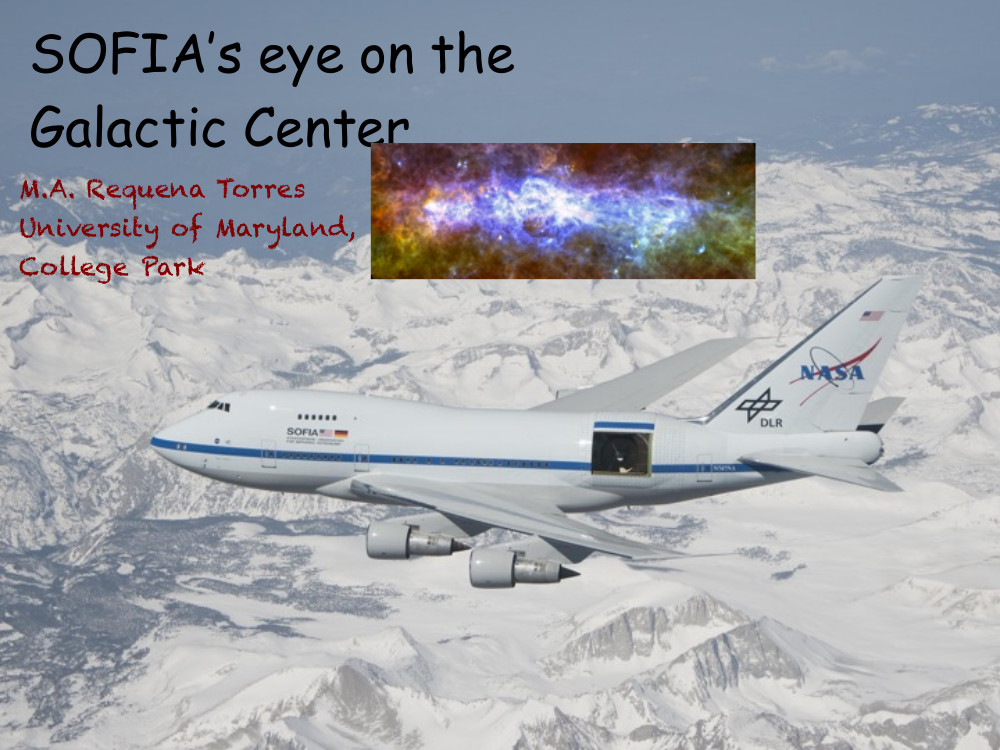
by Miguel Requena-Torres, University of Maryland, College Park, USA
During the last 7 years, SOFIA has been flying above our heads to try to catch those photons that will never arrive to our observatories on land. During its life, SOFIA has been targeting the Galactic Center with not only GREAT, but with several of its instruments. I will review all the projects observed by the observatory and the new proposals that we hope will be accepted in the near future.
(Abstract PDF)
Illuminating the Dark Universe with Fluorescent Lyman-alpha Emission
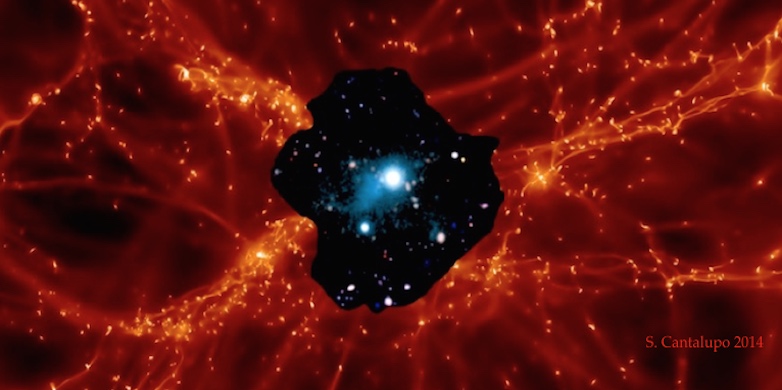
by Sebastiano Cantalupo, ETH Zürich, Switzerland
Gravitational collapse during the Universe's first billion years transformed a nearly homogeneous matter distribution into a network of filaments - the Cosmic Web - where galaxies form and evolve. Because most of this material is too diffuse to form stars, its study has been limited so far to absorption probes against background sources. In this talk, I will present the results of a new program to directly detect and study high-redshift cosmic gas in emission using bright quasars and galaxies as external "sources of illumination’’. In particular, I will show results from ultra-deep narrow-band imaging and recent integral-field-spectroscopy as a part of the MUSE Guaranteed Time of Observation program that revealed numerous giant Lyman-alpha emitting filaments extending up to several hundred kpc around quasars and bright galaxies. I will discuss how the unexpectedly high luminosities of these systems, together with the constraints from Helium and metal extended emission, represent a challenge for our current understanding of cosmological structure formation. In particular, I will show that current observations suggest that a large amount of “cold" and dense gaseous “clumps" should be present around high-redshift galaxies and I will present our first attempts to understand the origin and nature of these structures using high-resolution hydrodynamical simulations.
(Abstract PDF)
The Role of Turbulence in Star Formation: from Dense Cores to Disk Formation

by Jaime Pineda, Max-Planck-Institut für extraterrestrische Physik, Garching, Germany
A detailed understanding of star-formation is important to establish the "micro-physics" involved in the galactic star-formation relations, but also to determine the initial condition for proto-planetary disks. One of the important steps in the star-formation process is the accumulation of material from the molecular cloud with supersonic motions into the dense cores, which have subsonic turbulence. The first direct observation of the transition between supersonic and subsonic turbulence in a nearby cloud provided the first direct constrains on this dissipation process. I'll show the latest efforts on how to determine the scale at which turbulence is dissipated and how fragmentation of dense cores is enabled by turbulence. I will describe how these initial results explored in other regions, thanks to a new large program at the Green Bank Telescope (~250hrs, PIs: Jaime Pineda and Rachel Friesen). Now, ALMA observations present us with a new window to directly test the formation mechanism of dense cores, for which we present the initial results. Finally, I will show how does the turbulence affects the initial conditions of disk formation, by studying the transport of angular momentum in the envelope of young protostars, and how new ALMA observations will allow us to constrain this transport down to the scales relevant for disk formation.
(Abstract PDF)
Intriguing Extraterrestrial Tales of Molecules CH3NCO and CH2CHCN
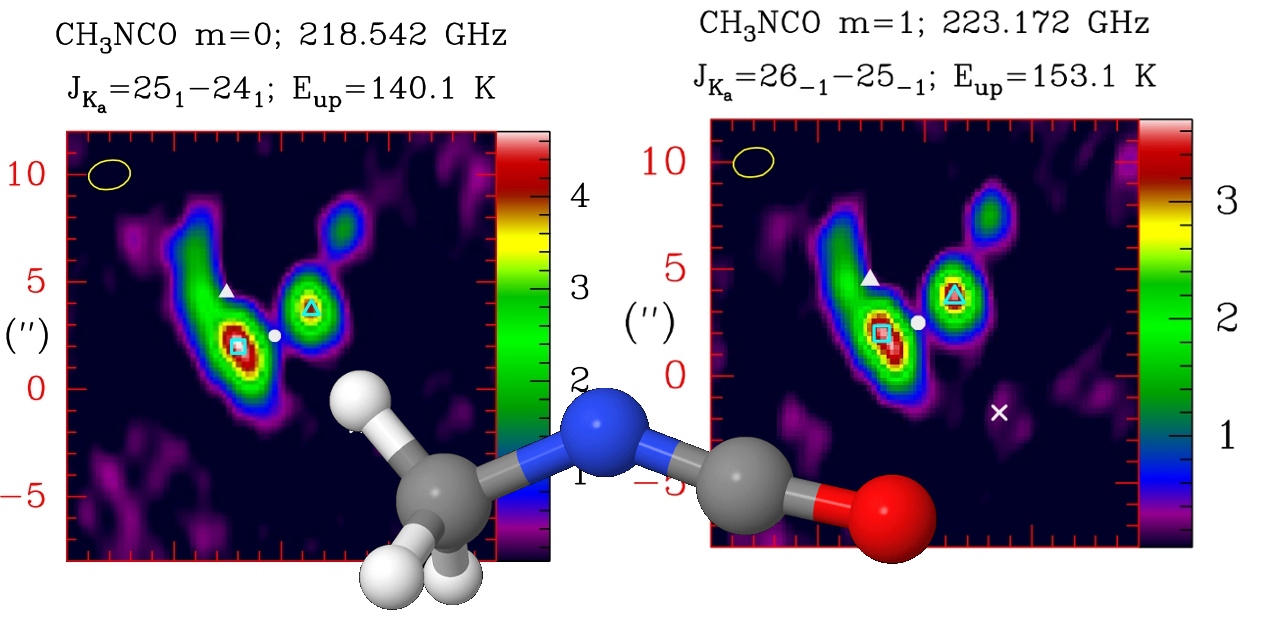
by Zbyszek Kisiel, Institute of Physics, Polish Academy of Science, Warszawa, Poland
Recently, there have been thought provoking astrophysical developments concerning the molecules methyl isocyanate (CH3NCO) and acrylonitrile (CH2CHCN). The associated stories connect in a rather unorthodox manner the spectroscopy of the interstellar medium, of the Solar System and in the laboratory. Two distinct stories will be covered in the talk. The first originates in the Rosetta mission finding that the hitherto astrophysically overlooked CH3NCO was rather abundant on the 67P/Churyumov-Gerasimenko comet surface. Following this impulse the molecule was readily detected both in Sagittarius B2 and in Orion KL. The hindrance to earlier astrophysical detection of CH3NCO arose from the inability to fit the mm-wave rotational spectrum to experimental precision, due to complications from a combination of two low-frequency internal motions. Nevertheless, recording of the complete laboratory mmw spectrum allowed unambiguous detection of 399 lines of CH3NCO in IRAM 30m and ALMA spectra of Orion (Astronomy & Astrophysics 587, L4, 2016). It turns out that CH3NCO could have been detected even in various legacy spectra if only suitable laboratory data was available, and its addition to astrophysical reaction schemes seems desirable.
The second story concerns the acrylonitrile molecule. This was not expected to hold many astrophysical surprises, since interstellar transitions of its isotopic species and of rather highly excited vibrational states have been detected as a result of extensive laboratory work (also carried out in Köln). However, identification of atmospheric acrylonitrile on Saturn’s moon Titan (Science Advances 3, e1700022, 2017) turned out to be rather newsworthy in the context of theoretical predictions that it might be a building block of vesicle structures possible in the liquid methane environment on Titan. Atmospheric modeling suggested that the measured stratospheric abundance would be sufficient to lead to near-saturation of acrylonitrile in the surface methane lakes facilitating the hypothesized more complex, life related chemistry.
(Abstract PDF)
Dust Dynamics and Evolution in Expanding HII Regions
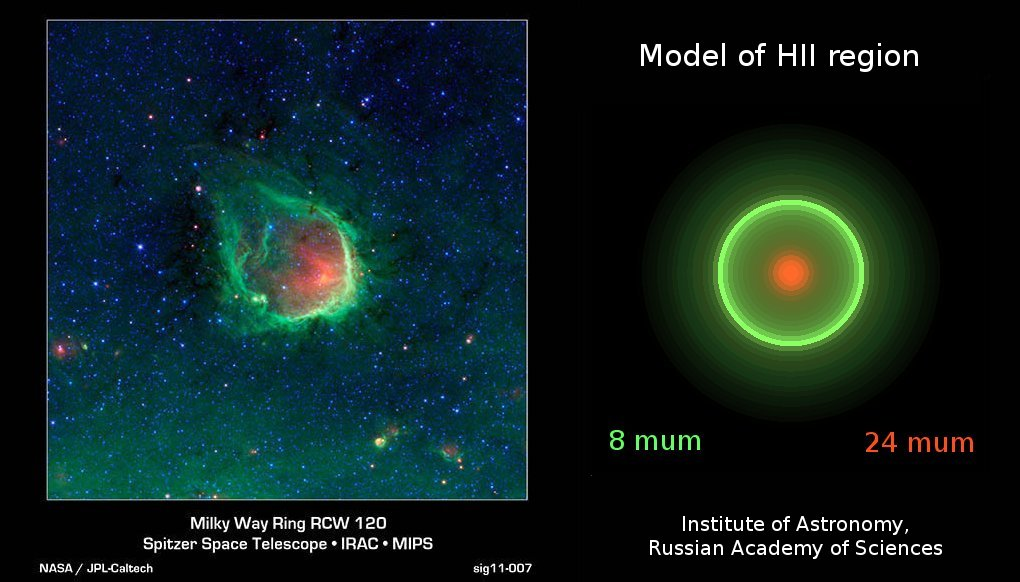
by Maria Kirsanova, Institute of Astronomy, Russian Academy of Sciences, Moscow
Massive stars signpost places of their birth in molecular clouds by expanding volumes of hot ionized gas. The region between hot ionized and cold molecular gas is known as photodissociation region (PDR). The physical and chemical properties of this region are defined by radiation spectrum from a massive star. The local radiation intensity inside PDR is able to dissociate molecules but not sufficient to ionize hydrogen. The HII and PDRs have very specific observational manifestation on Spitzer's images. Namely, the ring-like structures which are seen at 8 micron surrounds the inner regions which are bright at 24 micron. This is most probably related to the properties of dust particles which are not same inside and outside of HII regions. We started a theoretical study of expanding HII regions to clarify the reasons of this specific observational appearance and to understand how HII and PDRs look during their development around massive stars. We consider the dust drift under influence of radiation pressure during the pressure driven expansion of an HII region. The dust particles are represented by polycyclic aromatic hydrocarbons (PAHs) and ensemble of silicate and graphite grains of larger sizes. The radiation pressure on dust, Coulomb drag, dust drift, and the lug of gas by dust are all important process which are considered simultaneously to describe the dynamics of HII regions. We evaluated a grain charge evolution within the HII region for each dust type. Big grains are effectively swept out of the HII region. PAHs and smaller graphite grains are mostly coupled to the gas. Intermediate size grains have double-peaked distribution. Accurate treatment of dust dynamics let us explain some observational features of HII and PDRs and also suggest other processes needed to build complete sequence of dust evolution near massive stars.
(Abstract PDF)
RadioAstron Maser Observations - Record of Angular Resolution
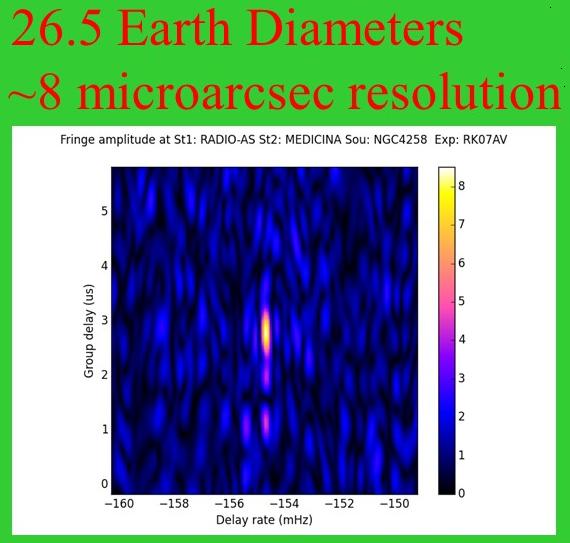
by Andrej Sobolev, Ural Federal University, Yekaterinburg
Extremely long baselines of the space-ground interferometer RadioAstron allow achieve ultra-high angular resolution. Possibility of detection of maser emission with resolutions about several micro-arcseconds was arguable before successful experiments reported in this paper. We present the results of the maser survey obtained by RadioAstron during first 5 years of operation. Extremely high angular resolution of 8 micro-arcseconds has been achieved in observations of the megamaser galaxy NGC 4258. For the galaxy at the distance about 7.2 Mpc this corresponds to linear resolution around 60 a.u. Very compact features with angular sizes about 20 micro-arcseconds have been detected in star-forming regions of our Galaxy. Corresponding linear sizes are about 5-10 million kilometers.
(Abstract PDF)
Resolving the Physical State of Cold Gas and the Star Formation Process on Cloud-scales across the Local Galaxy Population
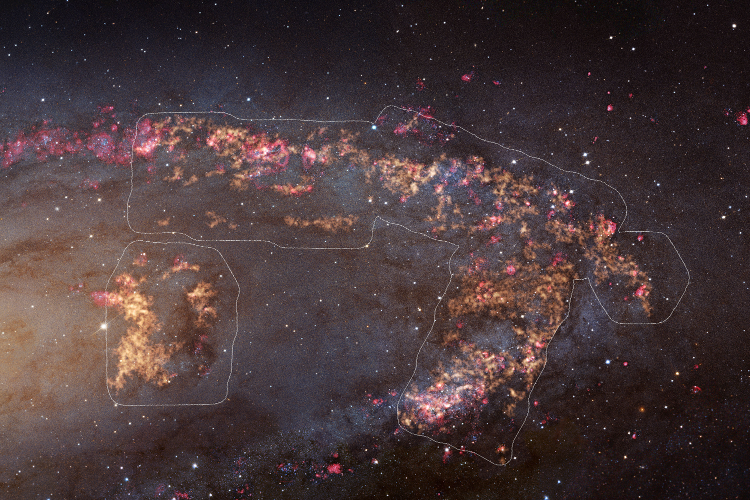
by Andreas Schruba, Max-Planck-Institut für extraterrestrische Physik, Garching, Germany
State-of-the-art instrumentation like ALMA, NOEMA, JVLA, and VLT/MUSE is revolutionizing our view on the gas-star formation cycle in nearby galaxies. I will highlight recent results from several concerted large surveys targeting galaxies inside and outside the Local Group. These observations resolve the interstellar medium (ISM) and young stellar population down to individual molecular clouds and young stars. These observations provide a view as detailed as so far only known from within the Milky Way but now across the local galaxy population. This includes (a) the multi-scale structure of the atomic and molecular gas and the finding of significant diffuse molecular gas. (b) Constrains on ISM properties on cloud-scale and their systematic dependence on galactic environments. (c) These local ISM properties relate to observed variations in the gas-star formation (Kennicutt-Schmidt) relation and allow for tests of theoretical models that predict the efficiency of star formation from local ISM properties. (d) I highlight how we measure molecular cloud lifetimes and test theories of their formation. In summary, new high-resolution observations of nearby galaxies transform our understanding on how ISM properties and star formation process depend on galactic environment and regulate each other.
(Abstract PDF)
Unraveling Interstellar Chemistry with Broadband Microwave Spectroscopy and Free-electron Lasers
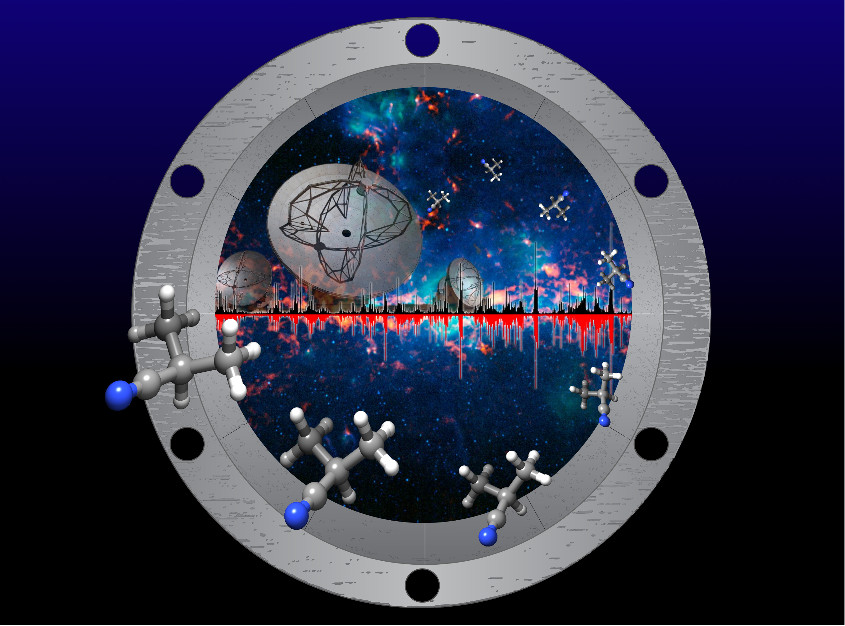
by Melanie Schnell, Deutsches Elektronen-Synchrotron (DESY), Hamburg, Germany
In the interstellar medium (ISM), chemical reactions are taking place in both the gas phase and on grain surfaces, which build up the complexity of organic molecules. We provide high-resolution laboratory data, obtained with broadband chirped-pulse rotational spectroscopy and various advanced light sources, such as Free-Electron Lasers (FELs) and synchrotrons, to improve the knowledge of the chemical inventory of the ISM and potential chemical mechanisms. We are particularly interested in polycyclic aromatic hydrocarbons (PAHs) and molecules in vibrationally excited states.
While it is postulated that PAHs are at the basis of a rich chemistry, there has been no direct detection of individual types of PAHs in astronomical environments. We use a multi-spectroscopic approach to investigate PAHs and their chemistry. We employ broadband rotational spectroscopy to determine their structures and to investigate the hydration of PAHs to set a foundation for the future exploration of potential ice formation pathways. Far-IR spectroscopy allows us to study the global vibrations at low energies and the effect of anharmonicity. X-ray spectroscopy and VUV-UV and VUV-IR pump-probe spectroscopy provides insight into potential mechanisms for the interplay between ionization and fragmentation when interacting with harsh radiation.
Molecules in vibrationally excited states are interesting from a spectroscopic point of view and can provide information about the physical conditions of their environment. For this, we use a segmented W-band spectrometer (75–110 GHz), which provides direct overlap with ALMA band 3, and perform the experiments under room-temperature conditions (as shown in the example for i-propyl cyanide below). This approach thus provides access to high-resolution, pure rotational data of vibrational modes that occur in the far-infrared fingerprint region and that can be difficult to access with other techniques.
(Abstract PDF)
Dwarf Galaxies as Local Laboratories to Study the Interplay between Star Formation and Low Metallicity Environment
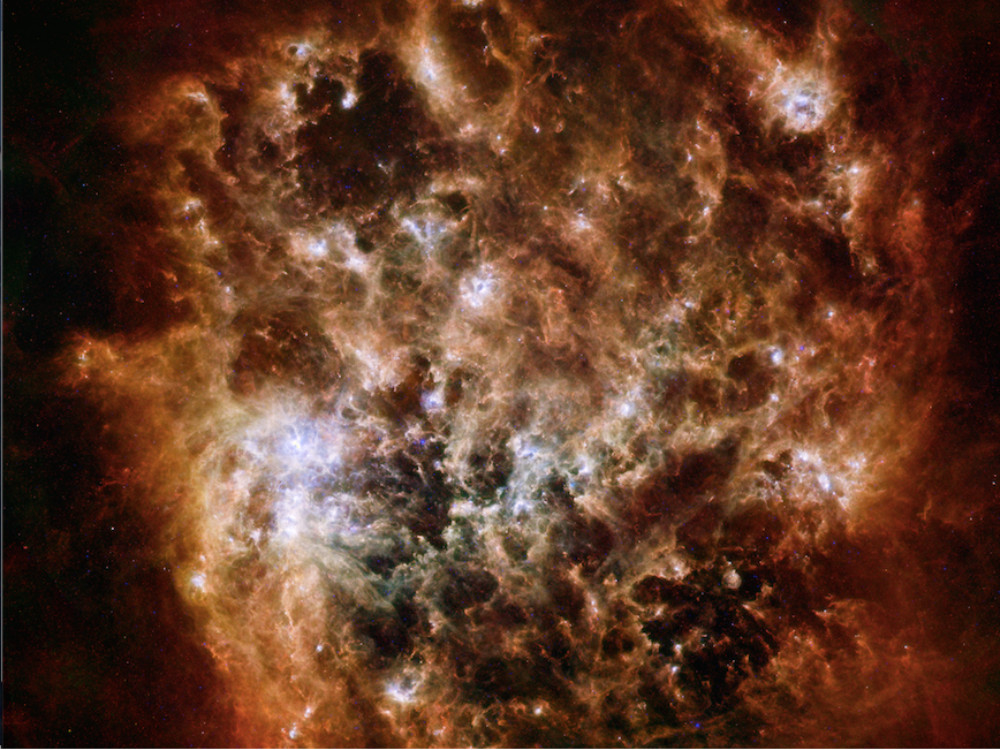
by Suzanne Madden, CEA Saclay, France
The interstellar medium (ISM) of galaxies harbors the reservoir of metals deposited over the history of star formation of a galaxy and contains the imprint of the astrophysical processes governing a galaxy's evolution. Understanding how the ISM becomes enriched with heavy elements, particularly in primordial ISM, would place important constraints on galaxy evolution models. Local universe dwarf galaxies provide a wide range of metallicities to study star formation and it feedback on ISM in conditions that may be representative of early universe environments.
We have been carrying multi-wavelength studies of low metallicity dwarf galaxies with the goal of understanding how metallicity impacts the evolution of the gas and dust and thus the star formation properties in galaxies. Their low mass, prominent star formation activity, and metal-poor ISM have a striking impact on the physical processes that take place to shape the structure of the ISM. The properties of the gas and dust associated with molecular clouds, photodissociation regions and ionised phases of dwarf galaxies show notable differences from those of their more metal rich counterparts. I will describe what we know to date from surveys and modelling efforts of the dust and gas and star formation properties in low metallicity dwarf galaxies.
(Abstract PDF)
Reactions of Nitrogen-containing Ions in Titan’s Atmosphere
by Wolf Dietrich Geppert, Stockholm University, Sweden
Ion processes play a pivotal role in the interstellar medium (ISM) and planetary atmospheres as intermediate steps in the build-up of larger complex molecules. A multitude of heavy anions (up to a mass of 10000 Da) and a large number of nitrogen-containing cations have been observed by the Cassini Plasma Spectrometer (CAPS) and Ion and Neutral Mass Spectrometer (INMS) in the atmosphere of the Kronian satellite Titan. Especially, several protonated nitriles were detected in this environment by the INMS. In addition, the anions CN-, C3N- and, possibly, C5N- have been identified in Titan’s ionosphere by CAPS. It is therefore necessary to investigate possible formation and destruction pathways of these species in Titan’s atmospheres.
During the last years, ion traps and guided beam devices have been successfully employed to investigate ion-neutral proocesses. The principal aim was to identify possible growth mechanisms large carbon- and nitrogen-containing molecules in Titan’s atmosphere via ion-molecule reactions. Such heavy entities can act as intermediates for the formation of tholines which are regarded as being responsible for the orange haze Titan is enveloped in.
Summer Term 2017
Molecules in a z=0.89 Disk Galaxy toward PKS1830-211
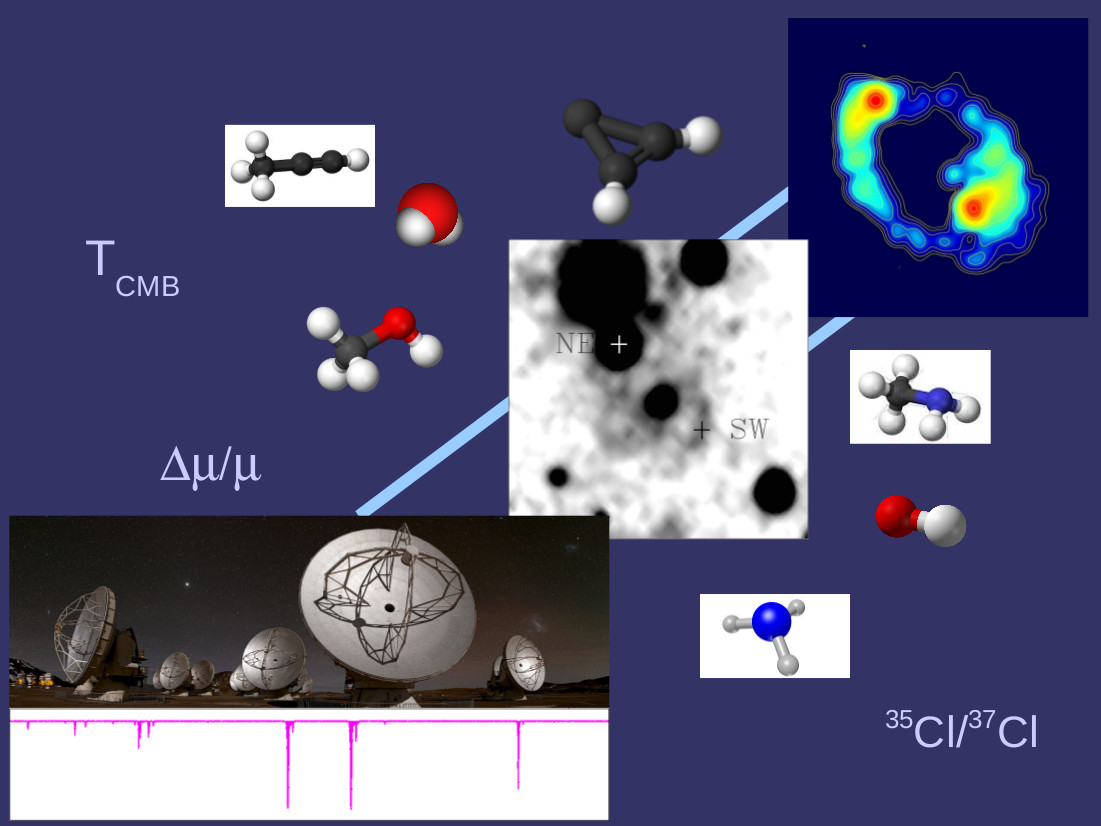
by Sebastien Muller, Chalmers University of Technology, Onsala Space Observatory, Sweden
The z=0.89 molecular absorber toward PKS1830-211 is a unique source to investigate the gas properties in the disk of a distant galaxy, at a lookback time of about half the present age of the Universe. We have investigated the molecular contents along two independent sightlines through the galaxy, and use the molecules as tools to probe the physical conditions and excitation, including the molecular fraction and cosmic-ray ionization rate of atomic hydrogen using hydrides. We compare these two lines of sight to lines of sight in the Milky Way, and find surprising similarities and also some differences. We also use the molecules as cosmological probes, and we have obtained a precise and accurate measurement of the cosmic microwave temperature at z=0.89, stringent constraints on the constancy of fundamental constants, and measurements of isotopic ratios of C, N, O, S, Si, Cl, and Ar elements.
(Abstract PDF)
Evolutionary Description of Giant Molecular Cloud Mass Functions on Galactic Disks
by Masato Kobayashi, Nagoya University, Japan
Recent radio observations show that giant molecular cloud (GMC) mass functions noticeably vary across galactic disks (e.g., Colombo et al. 2014). High-resolution magnetohydrodynamics simulations show that
multiple episodes of compression are required for creating a molecular cloud in the magnetized interstellar medium (e.g., Inoue et al. 2012). To understand time evolution of GMC mass functions, we formulate the
evolution equation for the GMC mass function to reproduce the observed profiles, for which multiple compressions are driven by a network of expanding shells due to H II regions and supernova remnants. We also
introduce the cloud-cloud collision (CCC) terms in the evolution equation in contrast to previous work. In this seminar, I would like to present computed time evolutions and the following two suggestions: (1) the GMC mass function slope is governed by the ratio of GMC formation timescale to its dispersal timescale whereas the CCC effect is limited only in the massive end of the profile, (2) almost all of the dispersed gas contributes to the mass growth of pre-existing GMCs in arm regions whereas less than 60 percent contributes in inter-arm regions. Our
results suggest that measurement of the GMC mass function slope provides a powerful method to constrain those GMC timescales and the gas resurrecting factor in various environments across galactic disks.
Turbulence and HI/H2 Phase Transitions in Galactic Molecular Clouds
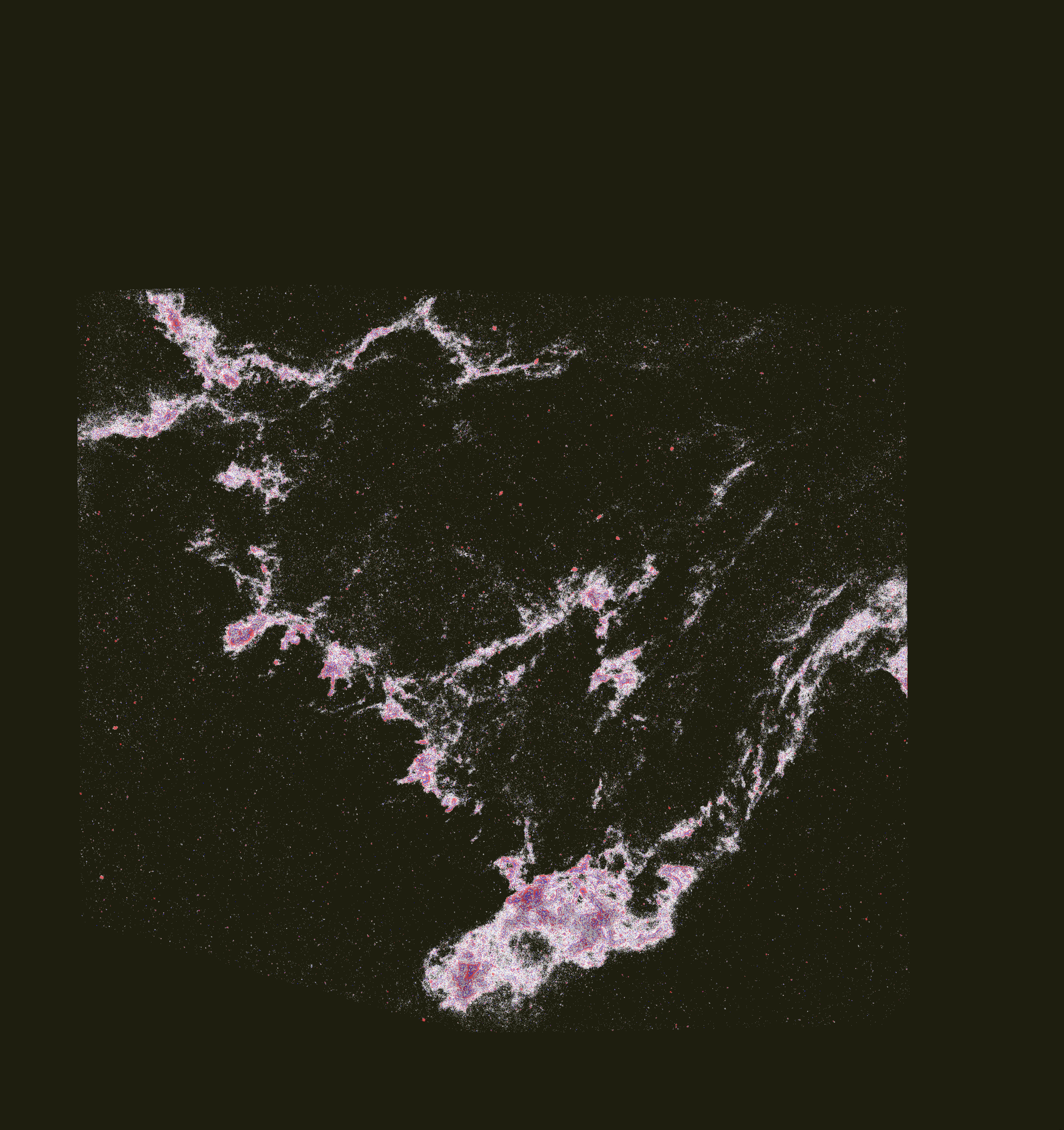
by Hussein Yahia, INRIA, Talence, France
tba
Laboratory Spectroscopy of Ions and Clusters Relevant for Astrochemistry
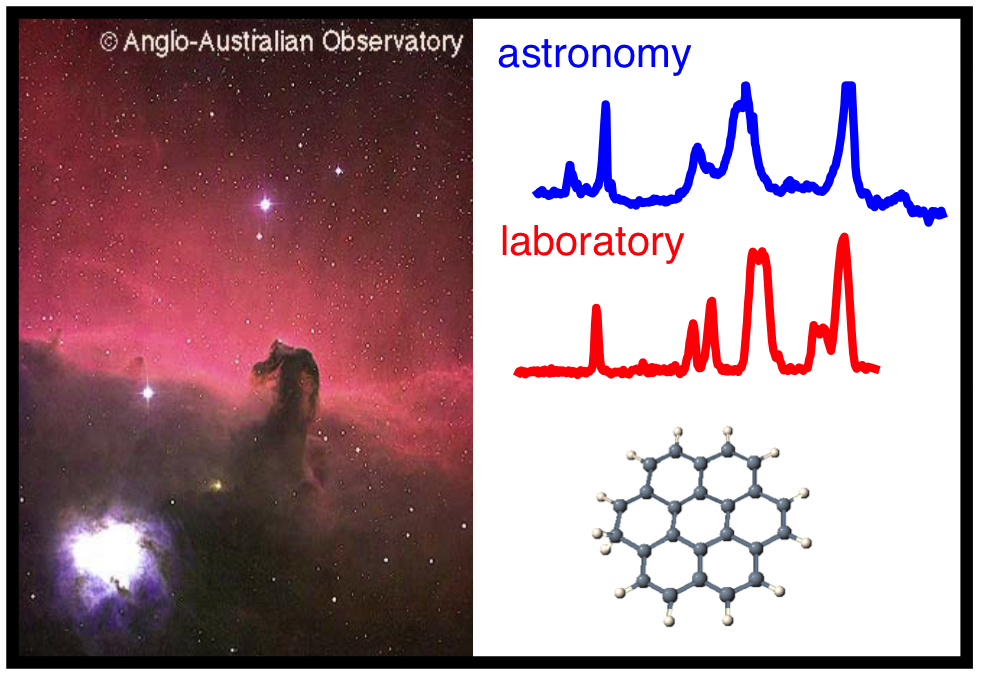
by Otto Dopfer, Institut für Optik und Atomare Physik, Technische Universität Berlin, Germany
The identification of stable and transient molecules, radicals, ions, clusters, and nanoparticles in space by astronomy requires detailed knowledge of their spectroscopic properties. To this end, their spectra have to be measured in the laboratory for comparison with astronomical data. Our group develops modern and highly sensitive spectroscopic techniques coupled with sophisticated molecular sources and mass spectrometric techniques to measure infrared and optical spectra of the size-selected molecular species of interest isolated in the gas phase at low temperature and at low concentration. Recent examples to be presented include elusive carbocations, protonated PAHs (up to coronene), nanodiamondoids, and silicon- containing molecules, for most of which we have measured the first spectroscopic laboratory data.
(Abstract PDF)
Are Galaxies Self-centered or Social Beings?

by David Elbaz, CEA Saclay, France
Local galaxies exhibit a bimodal distribution. Red-dead galaxies are more clustered than blue-star forming galaxies suggesting that galaxies are social beings whose life depends on their environment. In apparent contradiction, evidence has been accumulated for a universality of the star-formation history of galaxies independently of their environment. The so-called main sequence of star forming galaxies indeed suggests that it their mass that controls the history of galaxies; in situ mechanisms being more important than ex situ ones.
I will review recent results obtained with the combination of Herschel and ALMA and discuss this apparent contradiction between the respective roles of in situ and ex situ mechanisms in the history of galaxies.
I will present a population of distant massive star-forming galaxies that were missed by the standard Lyman-break technique and discuss their role on the origin of compact early-type galaxies seen at z~2, whose progenitors have been missing until now. The most extreme of these, missed even in the deepest HST NIR images, now jump to the eye with ALMA. I will show that these massive distant galaxies follow the universal star-forming main sequence up to z=4. Their closer siblings studied at z=2.5 trace the most distant massive galaxy cluster caught at the very epoch of its formation.
I will then discuss possible physical mechanisms at play in these galaxies. Do giant kpc-clumps of star formation play an important role in the mass growth of a galaxy? What is the role of galaxy mergers vs violent dynamical instabilities? Is there a negative or positive effect of active nuclei in the stellar mass growth of galaxies?
(Abstract PDF)
The Hunter's Slingshot: Protostellar Ejection from Filaments in Orion

by Amelia Stutz, Universidad de Concepcion, Chile
Interstellar and Interplanetary Solids - From Observations to Laboratory Simulations for Dust Models
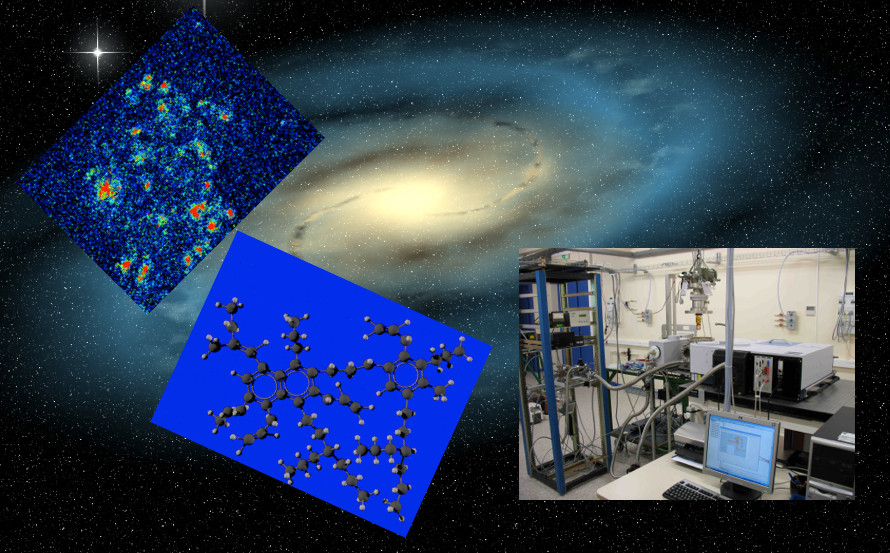
by Emmanuel Dartois, Institut d'Astrophysique Spatiale, Paris, France
The interstellar medium is a physico-chemical laboratory where extreme conditions are encountered, and whose environmental parameters (e.g. density, reactant nature, radiations, temperature, time scales) define the composition of matter. Whereas cosmochemists can spectroscopically examine collected extraterrestrial material in the laboratory or via space probes, astrochemists must rely on remote observations to monitor and analyze the physico-chemical composition of interstellar solids. The observations give essentially access to the molecular functionality of these solids, rarely to elemental composition constraints and isotopic fractionation only in the gas phase. Astrochemists bring additional information from the study of analogs produced in the laboratory, placed in simulated space environments.
In this presentation, recent advances from laboratory experiments will be presented, setting constraints on the composition of organic solids and molecules in the cycling of matter in the Galaxy. One objective will be to
draw some commonalities and differences between materials found in the Solar System and Interstellar dust.
This talk will particularly focus on carbonaceous dust materials from the far (ISM) and near (Solar System) space environments, small species released by the VUV irradiation of interstellar analogues and their influence on PDR regions compositions, and extraterrestrial collected dust, Ultracarbonaceous Antarctic Micrometeorites (UCAMMs), associated with the outer Solar System icy bodies.
(Abstract PDF)
Star Formation Towards a Few Southern Molecular Clouds Using a Multi-wavelength Approach
by Veena Vadamattom Shaji, Indian Institute of Space science and Technology, India
Star forming regions in the southern sky are relatively less studied compared to their northern counterparts. In this context, I will present the results of our multi-wavelength analysis towards few southern molecular
clouds, with specific emphasis on IRAS 17256-3631. Our analysis of the star forming activity of these regions cover a wide-wavelength range, from near-infrared to radio. While the embedded cluster and warm dust components are examined using infrared wavelength bands, the radio continuum has been used to probe the ionised gas. We have also mapped the low frequency radio recombination line (RRL) emission using GMRT, India. This is the first RRL mapping study of HII regions at low frequency bands (1.3 GHz) and we explain the observed continuum morphology using the kinematics of RRLs. In addition, we analyse the broadening of these lines by various mechanisms. Finally, we compare the star-forming activity in the clumps of the molecular clouds, by combining the information extracted using a plethora of tracers from different wavelength bands.
Star Formation from kpc to Hundreds of AU Scales

by Henrik Beuther, Max-Planck-Institut für Astronomie, Heidelberg, Germany
Star formation processes are important over a huge range of physical scales, from extragalactic star formation via large molecular clouds down to the scales of individual protostellar disks around stars. Linking these scales is crucial for a general understanding of star formation and the interstellar medium. I will set into context results from the nearby galaxy NGC3627 with large-scale clouds in the Milky Way and the fragmentation and disk formation processes within individual high-mass star-forming regions.
(Abstract PDF)
Winter Term 2016/17
Charge and Photon Dynamics in Driven Mesoscopic Systems: Devices – Detectors – Disordered Superconductors – Quantum Materials

by Marc Peter Westig, Kavli Institute of Nanoscience, TU Delft, The Netherlands
There is a growing interest in the physics of superconducting circuits. They are studied in interdisciplinary fields such as circuit quantum electrodynamics, quantum computing, ultrasensitive astronomical detectors, parametric amplifiers, devices made of disordered superconductors and hybrid devices. In the latter class of devices one combines e.g. massive superconducting electrodes with topological materials, low-dimensional systems like carbon nanotubes or graphene and with nanowires in general. In my talk I would like to focus primarily on circuit quantum electrodynamics, disordered superconductors and astronomical detectors, but would like to acknowledge interesting links to the other fields as well.
First, I will present the research focus of my former team of the Quantronics and Nanoelectronics groups at the Service de Physique de l’État Condensé/CEA Saclay. Here, we have contributed establishing a new direction in mesoscopic physics in which we have applied concepts of quantum optics to phase coherent mesoscopic circuits. A dc biased quantum conductor such as a Josephson junction gives rise to current fluctuations due to the granularity of charge carriers and the probabilistic character of quantum transport. Such current fluctuations may excite the electromagnetic environment, giving rise to a rich regime of light-matter coupling. I will show that this light-matter coupling strongly modifies the response of the quantum conductor and can produce non-classical radiation.
Second, I will present our actual research efforts at the Kavli Institute of Nanoscience in Delft in which we try to understand electronic inhomogeneity in disordered superconductors, providing evidence of different competing ground states in these materials. Ultimatively, we find a way of how to build a coherent quantum phase slip junction which would open up entire new directions of circuit quantum electrodynamics with an exactly dual element to conventional Josephson tunneling. New ideas to understand the noise physics of hot-electron bolometer mixers are briefly presented.
(Abstract PDF)
Observing Simulations: The Effect of Spiral Arms and Galactic Shear on Molecular Clouds
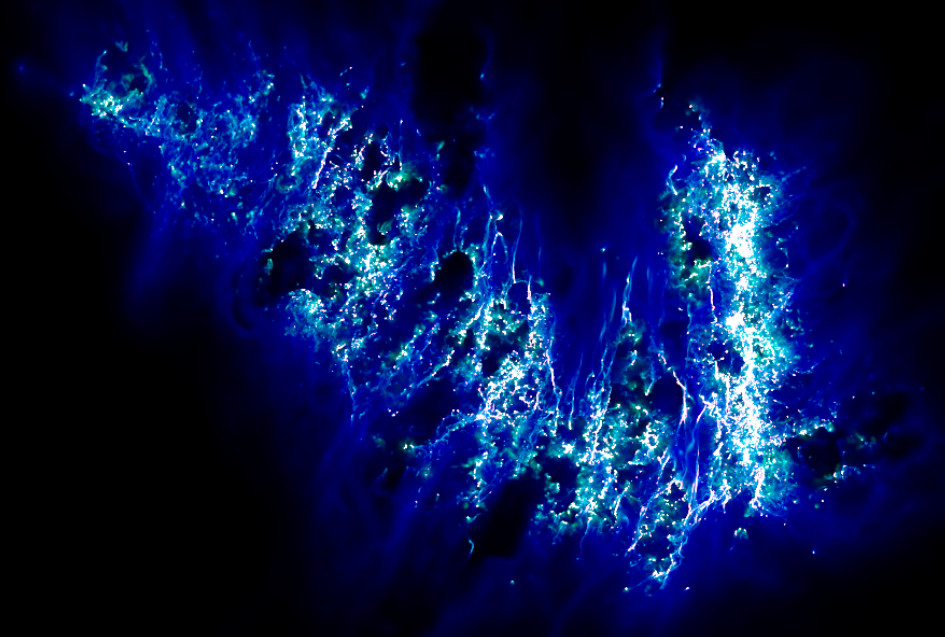
by Ana Duarte Cabral, School of Physics and Astronomy, Cardiff University, UK
To fully understand the global processes that lead to star formation, it is crucial to start by understanding the hierarchical organisation of the molecular component of the interstellar medium. However, defining and extracting molecular clouds is not an easy task: they are not a discrete well-defined entity - instead, they are formed as a result of the interchange and evolution of gas through the galaxy, and are thus often part of a continuum of gas with a mix of different fractions of atomic and molecular components, and different abundances of molecular species such as CO. Moreover, Milky Way studies suffer from yet another issue: a severe line of sight confusion that complicates the identification of “real” individual GMCs. Here I will present our recent work trying to grasp some of these issues, by studying the population of GMCs from a simulation of a portion of a spiral galaxy. We have used a new algorithm (SCIMES) to extract GMCs from both the physical 3-dimensional space, and from an observer’s perspective on CO emission datacubes. I will present the results from comparing the properties of clouds retrieved from the different extractions, as a means to understand the biases inherited from the perspective, resolution and tracer used. I will also explore how different galactic environments can affect GMC properties, namely by following the clouds as they travel from the shear-dominated inter-arm regions into and through spiral arms.
(Abstract PDF)
Exploring the Complex Chemistry of Embedded Protostars
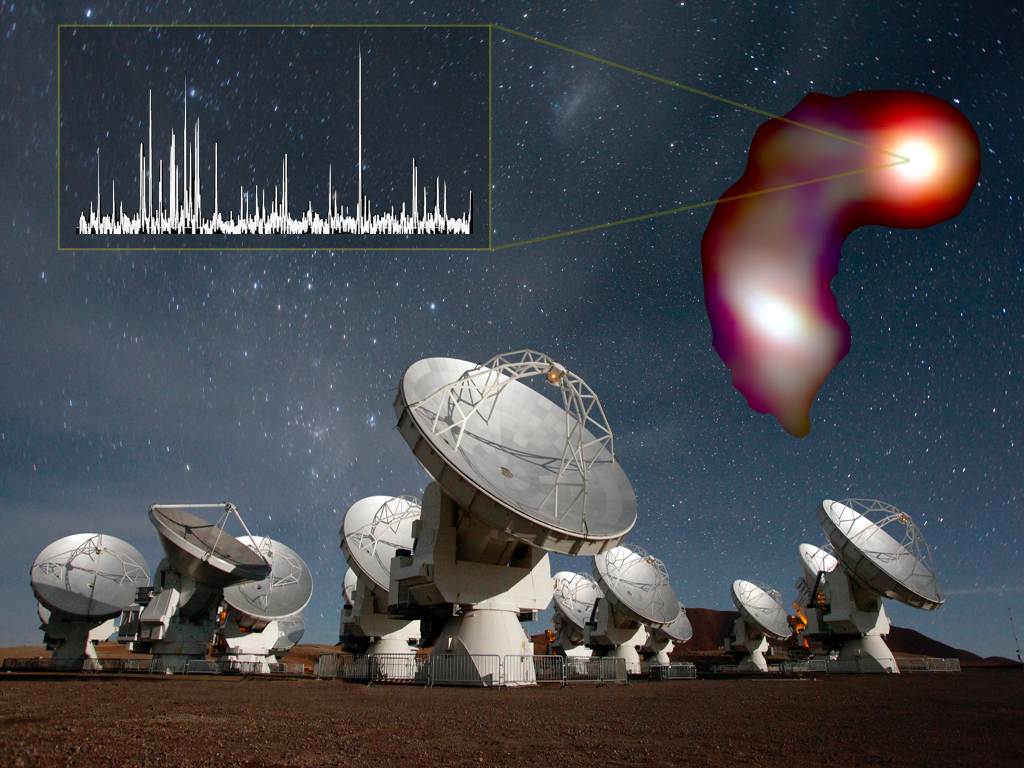
by Jes Jörgensen, Centre for Star and Planet Formation, Niels Bohr Institute, University of Copenhagen, Denmark
Low-mass stars like our Sun are formed in the centers of dark clouds of dust and gas that obscure their visible light. Deep observations at infrared and submillimeter wavelengths are uniquely suited to probe the inner regions of these young stellar objects and unravel their structures, as well as the physical and chemical processes involved. These earliest stages are particularly interesting as it is in these stages that the first seeds for the chemical evolution of the protoplanetary disk are planted and where some complex organic, possibly prebiotic, molecules are formed.
For this topic ALMA is providing important observational constraints with its high sensitivity for faint lines, high spectral resolution which limits line confusion, and high angular resolution making it possible to study the physical and chemical evolution of material as it is falls in from large scales in molecular clouds to circumstellar disks. In this talk I will discuss the constraints on the chemical structure of deeply embedded protostars offered by recent ALMA observations. I will discuss how we can use systematic surveys with ALMA to shed new light on the formation of complex organics and investigate the link between the physical and chemical structure of deeply embedded protostars on solar-system scales.
(Abstract PDF)
Broadband Spectral-line Surveys: A Unique Tool to Explore Early Star Formation
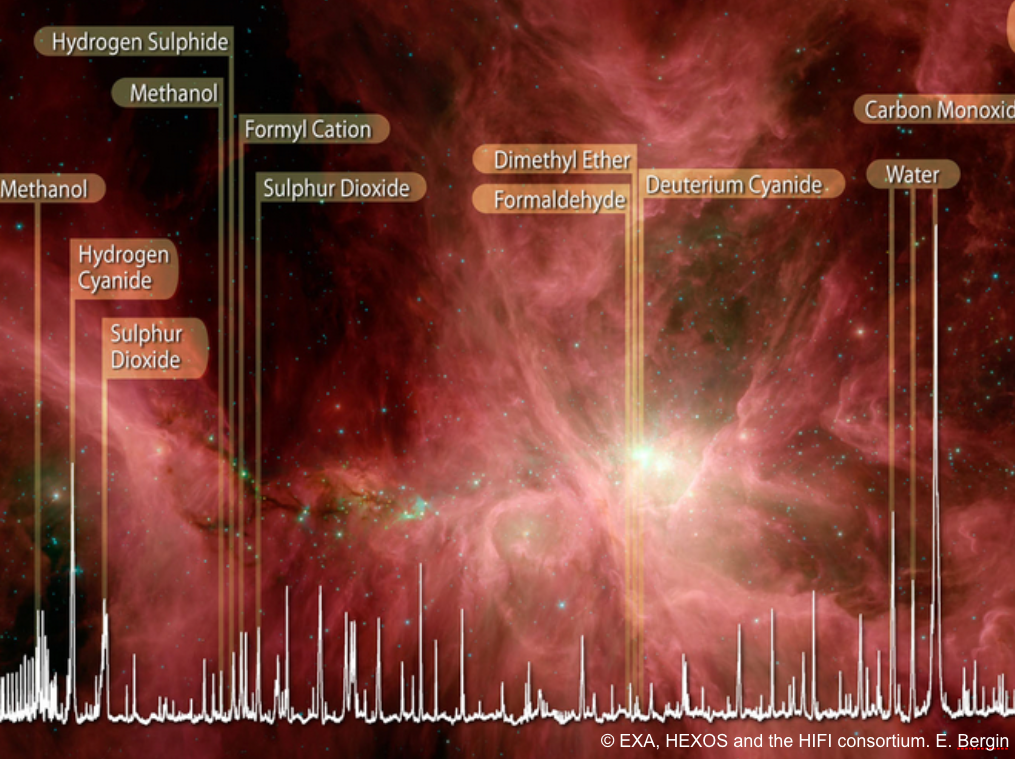
by Ana Lopez-Sepulcre, Institut de Radio Astronomie Millimetrique (IRAM), France
The past few years have witnessed a huge progress in the development of sensitive broadband (sub-)millimetre receivers, especially at single-dish telescopes. Thanks to this, it is now possible to carry out large spectral-line surveys that homogeneously cover tens or even hundreds of GHz in modest amounts of time, thus providing an unbiased, very powerful tool to explore the molecular composition of the region under study. As a result, a new and very promising road in molecular astrophysics is opening, in particular in the field of early star formation. I will introduce two large observational campaigns I have taken part in, ASAI and CHESS, entirely based on single-dish broadband spectral-line surveys of star-forming regions, and I will illustrate the huge potential of this approach with some selected results. Finally, I will introduce the importance of applying this technique also with (sub-)millimetre interferometers, where some first crucial steps are already taking place, and where the (hopefully near) future of unbiased spectral-line surveys lies.
(Abstract PDF)
Molecular Cloud Structure at Galactic Scales
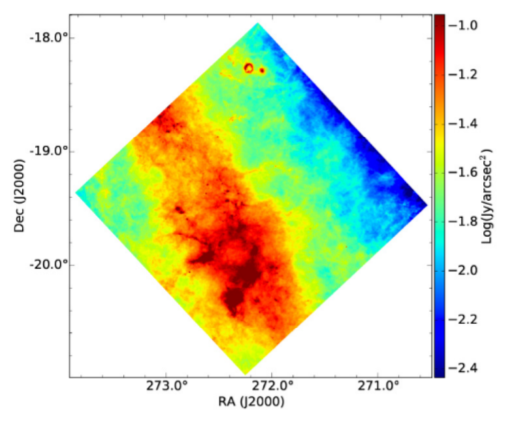
by Jorge Abreu-Vicente, MPIA, Heidelberg, Germany
The molecular clouds are mainly formed by filamentary structures that are the immediate sites of star formation. Molecular cloud structure is intimately linked to the physical processes driving their evolution. While molecular cloud evolution and star-forming activities are well understood in the Solar neighbourhood, systematic studies of these at Galactic scales are still lacking.
In this talk I will introduce the first systematic study of molecular cloud structure at scales involving galactic spiral arms. I will show how the molecular cloud structure changes with their evolutionary stages. Recently, a family of several tens-pc long filamentary molecular clouds have been found to populate the Galactic plane, equally distributed in spiral- and inter-arm regions. These are outstanding objects to study star formation at Galactic scales. I present a method to reveal giant molecular filaments and estimate their main physical properties.
Finally, I will present a method that combines the Planck and Herschel data in the Fourier space to absolute calibrate the latter. I show how this method improves our ability to measure reliable column densities and temperatures from Herschel data compared to the classical uniform background correction adopted. With this method, we will be able to obtain more accurate observational assessments of the molecular cloud structure at Galactic scales.
(Abstract PDF)
Sunbathing around Protostars - New Insights from the Far-Infrared Observations of Shock
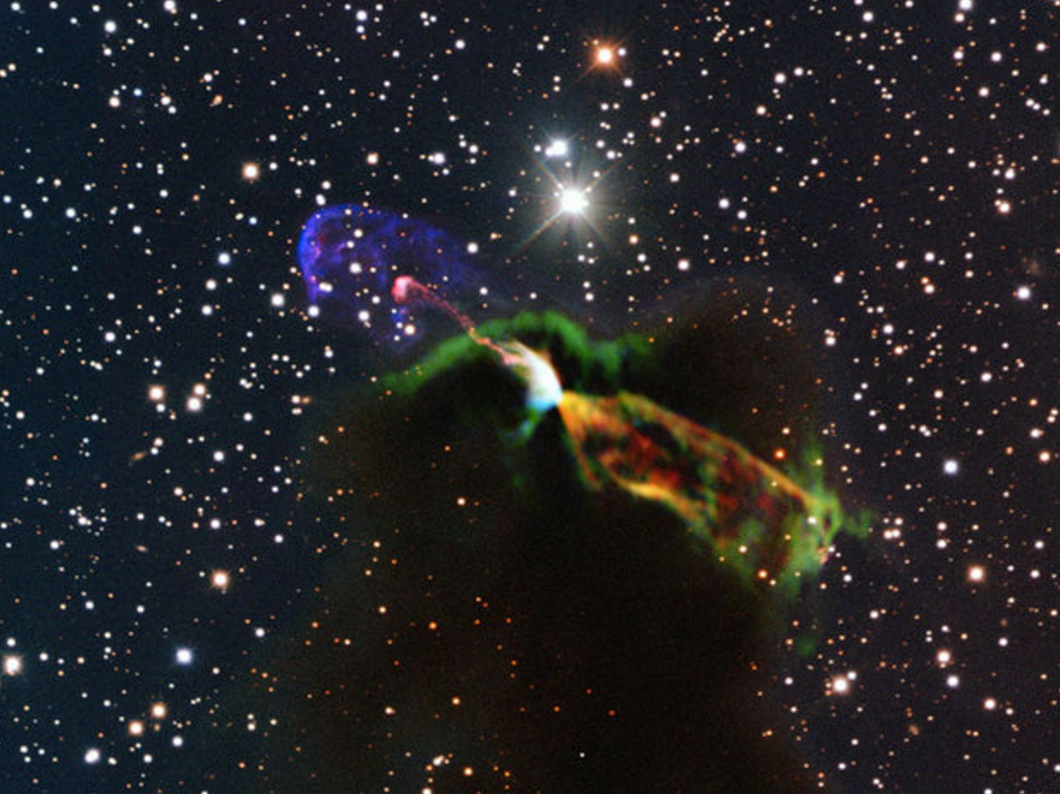
by Agata Karska, Torun Centre for Astronomy, Nicolaus Copernicus University, Torun, Poland
Stars form in dense molecular clouds, where gas and dust are well-shielded from the interstellar UV radiation. Nonetheless, UV photons can be produced in situ in the surroundings of young protostars: either by the accretion of material onto the disk or its partial ejection in the powerful jets. Recent observations with the Herschel Space Telescope reveal that even relatively small UV fields dramatically alter the chemical composition of the gaseous envelopes. In my talk, I will show the main results from Herschel related to feedback from low-mass protostars. In particular, I will demonstrate that standard models of shocks do not agree with observations unless their irradiation by UV photons is included.
(Abstract PDF)
Coevolution of Galaxies in Black Holes in Massive Environments
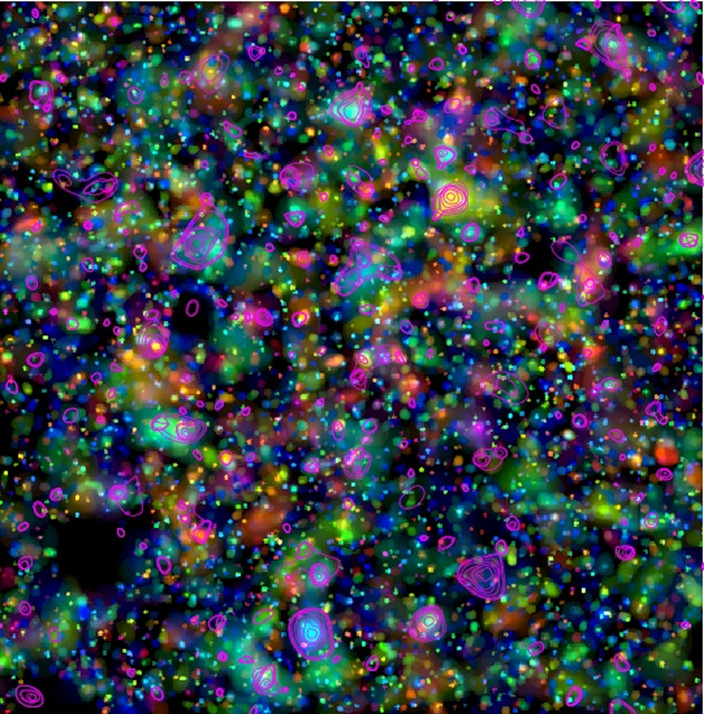
by Alexis Finoguenov, Max-Planck-Institut für extraterrestrische Physik, Garching, Germany & University of Helsinki, Finland
After an introduction to X-ray selection of galaxy groups in deep fields, I will review the results on the galaxy evolution and AGN triggering in massive environments. I will conclude that star-formation and tidal interactions are the two dominant processes, that describe our observations between now and a
redshift of 2.5. Triggering of AGN activity is governed by the same processes and serves as a sign-post of galaxy transformation.
(Abstract PDF)
Submillimeter-wave Spectroscopy of Molecules with Large Amplitude Motions of Astrophysical Interest
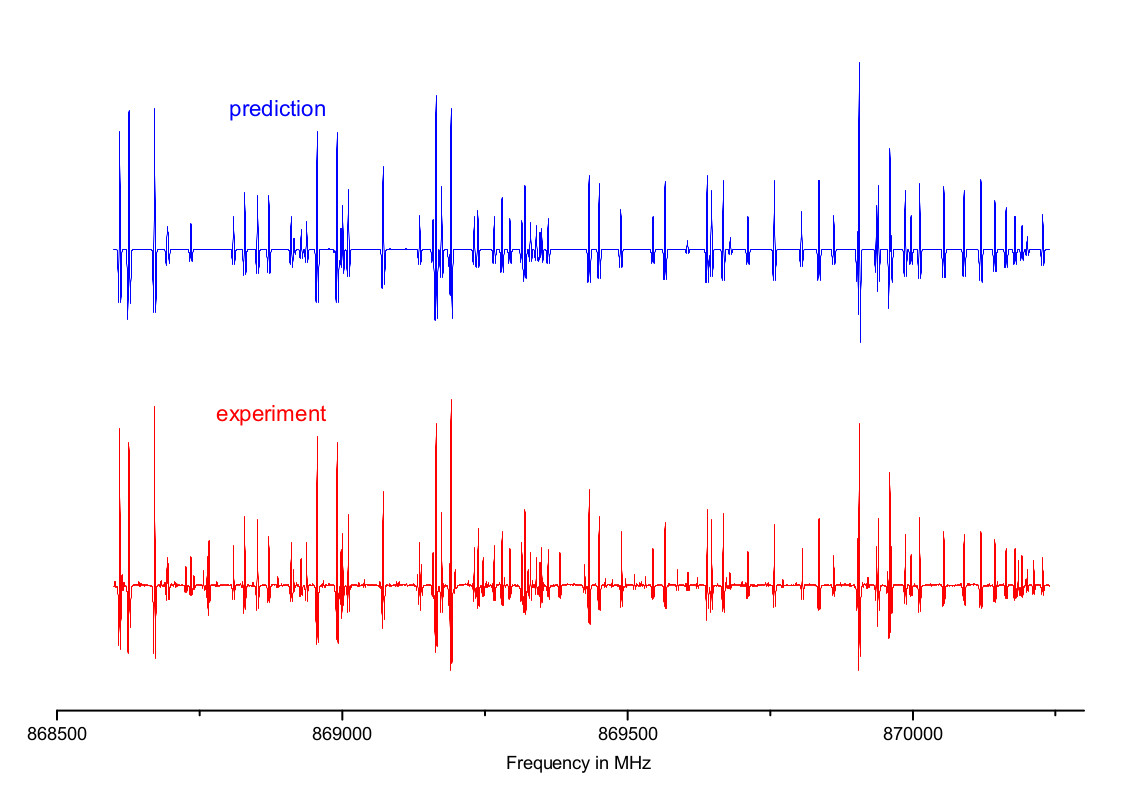
by Laurent Margules, Laboratoire PhLAM UMR CNRS, Université de Lille, France
This huge effort of gathering spectroscopic data is nowadays still pursued in order to prepare the sub-millimeter facilities like ALMA (Atacama Large Millimeter Array), NOEMA, SOFIA. It is expected that the high sensitivity and angular resolution reached by the instruments in these facilities combined with very precise spectroscopic analysis will provide accurate information about the formation of stars in the interstellar molecular clouds.
Since many years strong effort were done in order to improve the perfomances of submillimeter wave spectrometer. Laboratory spectroscopy take benefit of the development done with solid state devices based on Schottky diodes for the radiotelescopes. The new version used Direct Digital Synthesizer in order to speed up acquisition time. We construct a spectrometer covering a decade, from 150 to 1500 GHz, it scans the full range in 24 hours with high sensitivity and accuracy. This is particulary suitable for unstable or dangerous species. Last results about species presenting large amplitude motion will be presented.
(Abstract PDF)
Cold, Controlled Reactions between Molecular Ions and Radicals
by Philipp Schmid, JILA & University of Colorado at Boulder, USA
Radicals and ions frequently play an important role in gaseous media such as the interstellar medium, the upper atmosphere or flames and plasmas. Unfortunately, experimental measurements of the reaction rates and particularly the dynamics of reactions between ions and radicals are very few and far between. This is a direct consequence of the typical low densities of these species formed under experimental conditions in the laboratory. Most radical-ion reactions are predicted to be barrierless, thus can still occur rapidly at low temperatures. Therefore, measurements of such reactions under controlled conditions allow studying reaction pathways relevant for interstellar medium chemistry. At the same time it is possible to explore molecular spectroscopy and chemical reaction dynamics in a qualitatively new regime, e.g. at temperatures 1 K.
For sensitively probe radical-ion reactions, we designed a new experimental system combining two cold molecule techniques: The free radicals are derived from a Stark decelerator, which produces not only molecules in a very limited number of quantum states, but also with a controllable collision energy from ~0.1 to 200 cm-1. Molecular ions are stored in a linear quadrupole ion trap and sympathetically cooled with co-trapped, laser-cooled Ca+. Thereby the ions are translationally cooled with temperatures 1 K and have lifetimes of several hours. The combination of these two experimental approaches allows to probe chemical reactions with controllable energies in selected quantum states.
In this talk I will present the design of this experiment, showing its capabilities. Additionally I will report on the measurement of the quantum-state controlled reaction of Ca+ + NO. Furthermore planned experiments and upgrades to the present setup will be presented.
(Abstract PDF)
VIALACTEA: The Milky Way as a Star Formation Engine

by Sergio Molinari, National Institute for Astrophysics - Institute for Space Astrophysics and Planetology Rome, Italy
The Milky Way Galaxy, our home, is a complex ecosystem where a cyclical transformation process brings diffuse barionic matter into dense unstable condensations to form stars, that produce radiant energy for billions of years before releasing chemically enriched material back into the ISM in their final stages of evolution. Star formation is the trigger of this process, eventually driving the evolution of ordinary matter in the Universe from its primordial composition to the present-day chemical diversity necessary for the birth of life.
I will present an overview of the results of the Hi-GAL (Herschel infrared Galactic Plane Survey) key-project, a 720 square-degree survey of the entire Galactic Plane in five bands between 70 and 500 micron carried out with the HERSCHEL satellite. From diffuse ISM clouds, through a pervasive network of filamentary structures, down to the formation of dense clumps, the Hi-GAL survey traces the morphology and physics of dust structures at all spatial scales from the individual star formation site to the panoramic view of entire spiral arms.
Hi-GAL is the keystone of a suite of latest-generation Galactic Plane continuum and spectroscopic surveys from the infrared to the radio. With the VIALACTEA project we organised and analysed these datasets in a unified framework, deploying a homogeneous analysis and classification scheme for nearly 30,000 candidate filamentary structures and more than 100,000 dense clumps with heliocentric distance determinations. We are now able to complete the first resolved map of the Star Formation Rate in the Milky Way and analyse in detail its variation with Galactocentric distance and with respect to spiral arms, as well as in comparison to star formation triggering agents.
(Abstract PDF)
Addressing the Angular Momentum Problem During the Main Accretion Phase: Insights from Interferometric Studies of Class 0 Protostars
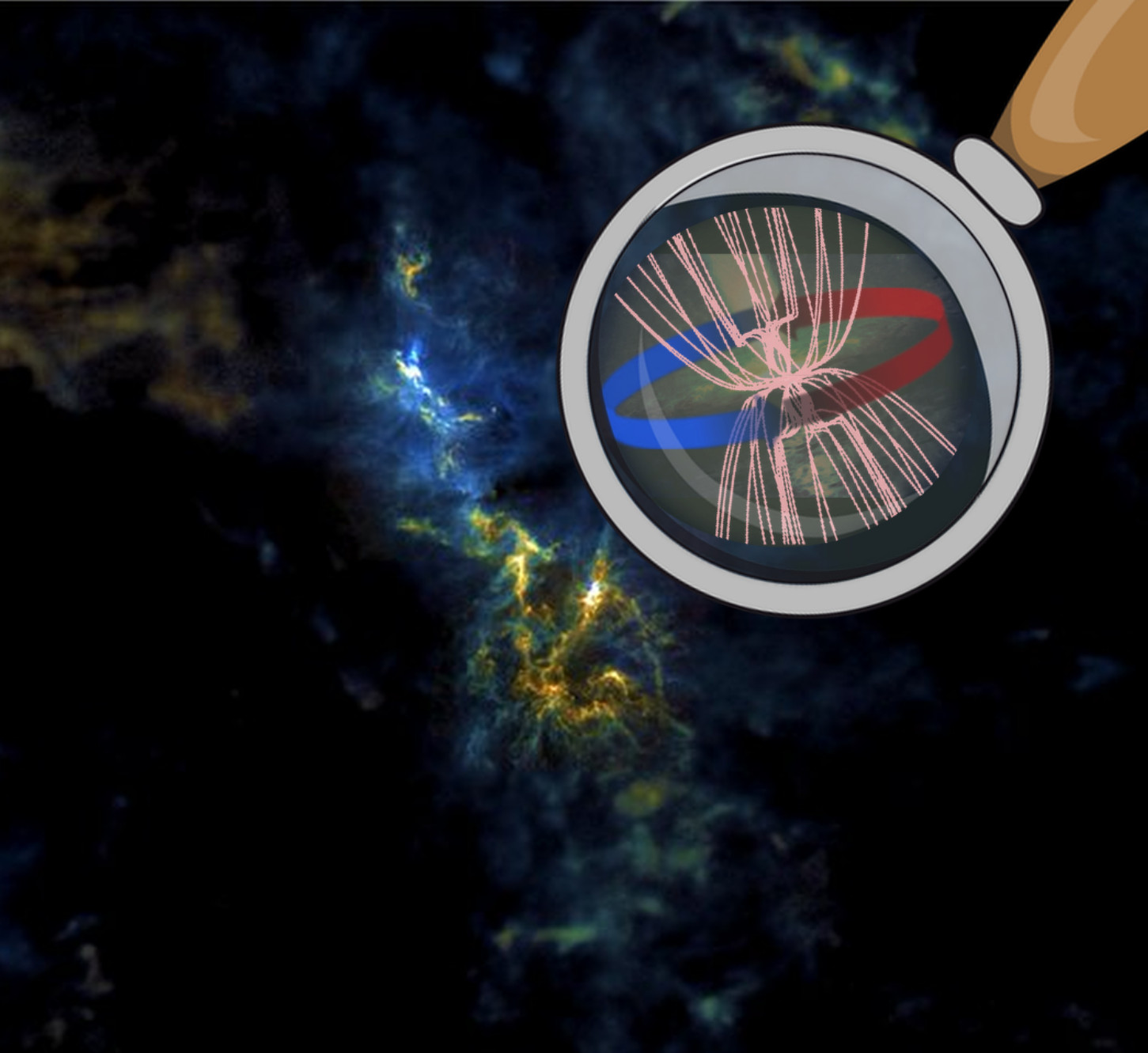
by Anaëlle Maury, CEA/AIM, Université Paris-Saclay, France
Class 0 protostars are the first (proto)stellar objects, observed only t0.1 Myr after their formation, while most of the mass is still in the form of a dense core/envelope collapsing onto the central protostellar embryo. The Class 0 phase is also the main accretion phase, during which most of the final stellar mass is accreted onto the central protostellar object. Therefore, during the Class 0 phase, the accreted circumstellar envelope must redistribute most of its initial angular momentum outward, or centrifugal forces will prevent further accretion onto the protostar: how this is done exactly is still an open question, known as the long-standing angular momentum problem for star formation.
Several key questions about the typical outcome of protostellar collapse, tied to this angular momentum problem, still remain open, such as the initial conditions for building protostellar disks and binary systems, which are routinely observed at the later stages of evolution. Solving not only these questions, but also understanding the typical outcome of protostellar formation, and therefore the formation of most stars, ultimately depends on characterizing the forces at work to regulate the angular momentum content and evolution during the Class 0 phase.
I will present new insights on the possible solutions to the angular momentum problem, obtained thanks to the detailed analysis of millimeter observations of protostellar envelopes probing the envelope density, structure and kinematics from the small scales (50 au) to large scales (5000 au) obtained mostly with the Plateau de Bure interferometer (PdBI) and the IRAM 30m telescope in the framework of the CALYPSO (Continuum and Line in Young Protostellar Objects, see http://irfu.cea.fr/Projets/Calypso/) program.
While the presence of large accretion disks is well documented in more evolved Class I objects and T Tauri stars, I will show that the detection of the large (r >100au) Keplerian disks expected from conservation of angular momentum during protostellar collapse, have remained elusive around Class 0 protostars. I will also present recent SMA and ALMA observations of magnetic fields in Class 0 protostars at scales 20-10000 au, arguing that the small disk sizes observed during the main accretion phase are in favor of a magnetically-regulated collapse scenario for the formation of most low-mass stars.
(Abstract PDF)
Massive Star Formation - An Investigation of Orion KL with ALMA
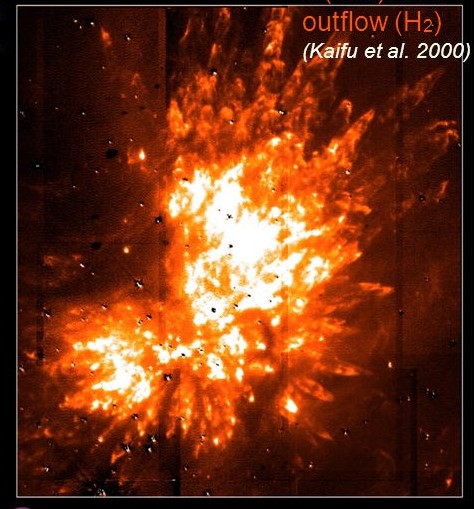
by Yuefang Wu, Peking University, Department of Astronomy, China
About massive star formation, there is a debate between two major models in recent years. One is the merger of less massive stellar objects, and the other is still through accretion but with the help of disk or outflow. So far the accretion-disk-outflow one has been supported with observation evidences mostly.
However we are wondering if this model can explain the massive star formation processes in our nearest massive star formation region Orion KL. Is the first outflow found here really driven by young stellar objects? Is there any material in infalling? What processes are in the sources (BN, Source I and n) ejected from the explosion 500 yrs ago?
An investigation was made using ALMA science verification data with a spatial resolution of ~1.5” and sensitivity of about 0.07 K and ?0.18 K for continuum and line, respectively. Six dust cores were detected. The gas consists of emissions of jet-propelled cores at the ridge and dense cores in east and south of the region. The outflow has multiple lobes, which seem to originate from explosive ejections, and is not driven by young stellar objects.
Four infrared bubbles were found in the IRAC emissions. These bubbles, the distributions of the previously found H2 jets, the young stellar objects, and molecular gas all together suggest that BN is the explosive center. The burst time was estimated to be _1300 yr. B? is at far north-west of the explosive center 500 yrs ago.
Strong signatures of gravitational collapse toward Source I was detected. Combining with the outflow and disk found previously we can see it is forming through accretion-disk-outflow typically. Blue profile toward the hot core was detected, showing material is infalling. These and together with the possible relatives of Source I and the hot core make it difficult to explain the Source I coming from outside of the hot core.
The related paper: (Wu, Liu, and Qin 2014, ApJ, 791, 123)
(Abstract PDF)
Interstellar Ice - a Hot Topic

by Harold Linnartz, Sackler Laboratory for Astrophysics, Leiden Observatory, University of Leiden, The Netherlands
Interstellar ices, composed of mixtures and layers of H2O, CO2, CO, CH3OH, and other molecules, frozen or formed on cold dust grains, are the main reservoir of heavy elements in dense interstellar clouds and protostellar envelopes and disks. Via the protostellar collapse phase they end up in comets in planetary systems, where they can enrich young planets with the volatiles needed to form oceans, atmospheres, and ultimately the building blocks of life. During this voyage, chemical modification by thermal and energetic (ultraviolet photons, cosmic rays, electrons) and non-energetic (atom-addition) processes takes place; complex organic molecules form and molecules desorb, physically or chemically, linking the solid state and gas phase in space.
The talk will show how these processes are studied in the laboratory, and how the results help us in understanding which solid state processes are at play in the dense and dark clouds from which new stars and planets form.
(Abstract PDF)
Star Formation and the Physical Conditions of the ISM Across Nearby Galaxies
by Frank Bigiel, Zentrum für Astronomie, Universität Heidelberg
I will present results from several new projects using ALMA and the IRAM telescopes to derive physical conditions in the molecular gas and their impact on star formation across nearby galaxies.
Using multi-line spectroscopy, our goal is to constrain the gas density distribution in each part of the galaxy, while using high resolution CO imaging to measure the structure (density, turbulence, and self-gravity) of the interstellar medium on the scale of individual star-forming clouds. The ability to make such measurements over large parts of a star forming galaxy is new in the last few years, thanks to the IRAM programs EMPIRE and PAWS and the beginning of ALMA operations.
I will show how the amount of dense gas changes across the disk of galaxies, and illustrate a more complex role for gas density in star formation than often assumed. I will also show how the basic cloud-scale structure changes from galaxy-to-galaxy, reflecting the local environment and how these relate to star formation. Finally, I will highlight first results of several programs with ALMA that promise to give us a sharp new view of cold gas in nearby galaxies over the next years.
Summer Term 2016
Star Formation - New Insights from Herschel and SCUBA2
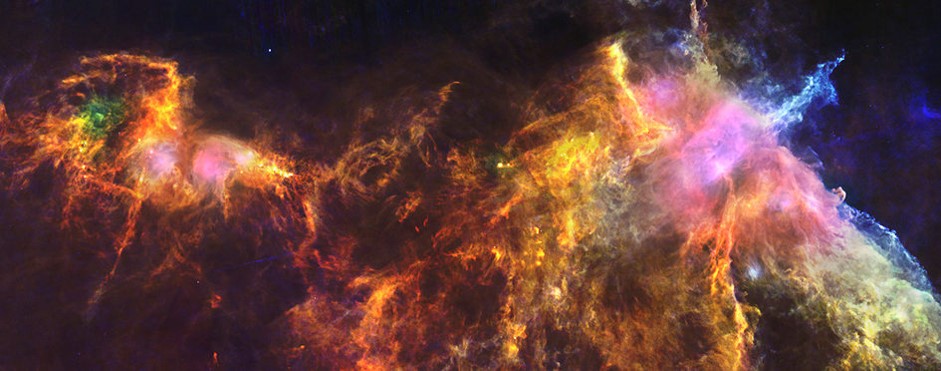
by Derek Ward-Thompson, Jeremiah Horrocks Institute, University of Central Lancashire, UK
The Herschel Space Observatory was an ESA space telescope which flew from 2009 until 2013 and collected a huge archive of imaging and spectroscopy data at several far-infrared wavelengths. It studied, amongst other things, many regions of star formation. Detailed analysis of these investigations has allowed us to present a new paradigm for how stars form. The new paradigm involves magnetic fields, filamentary structures and gravitational attraction combining to produce the stars that we observe today. The next generation of instruments, including SCUBA2 and its polarimeter, are now being used to test the predictions of this new theory. Initial results are presented from these instruments.
(Abstract PDF)
The Puzzle of Complex Organic Molecules in Cold Cores

by Aurore Bacmann, Institut de Planetologie et d'Astrophysique de Grenoble (IPAG), France
Instrumental progress has enabled us to detect ever more complex molecules in the interstellar medium. Among these molecules, organic species have attracted much interest because of the role they might play in prebiotic chemistry. Until recently, complex organic molecules were only detected in the hot cores of star forming regions. This led to the suggestion that they were the products of a warm chemistry: their presence could actually be well accounted for by models in which they formed on dust grain surfaces with high enough temperatures to allow precursor radicals to diffuse and recombine. The recent detections of complex organic molecules in prestellar cores at 10 K has cast doubts on this mechanism, as the temperatures are not high enough to warrant heavy radical diffusion on the grain surface. A number of theories have been put forward proposing different formation routes in the cold gas, but the lack of observational and laboratory data does not yet allow us to specify the respective roles of grain-surface or gas-phase processes. I will present recent observations of organic molecules and of their precursor radicals in the cold interstellar medium. These observations underline the role that gas-phase reactions play in the synthesis and destruction of these radical species. Our analysis enables us to highlight reactions for which laboratory measurements are crucial.
(Abstract PDF)
Revolutionizing Our View of Solar System Birth and Multiple Star Formation

by John Tobin, Leiden Observatory, The Netherlands
Proto-planetary disks are the birthplaces of planetary systems and they are thought to form at the onset of star formation due to conservation of angular momentum. These very young disks may also be massive enough
to be gravitationally unstable due to the rapid infall of mass from the collapsing cloud, enabling companion stars and possibly giant planets to form within disks. However, theory and simulations have suggested that
the formation of large, massive disks may be difficult due to the removal of angular momentum by magnetic fields. Observations are now sensitive enough to test these predictions, and we identified the first Keplerian disk around the youngest class of protostar. Moreover, ALMA observations are uncovering new Keplerian disks, in addition to enabling their molecular content to be examined. At the same time, we are using data from a large VLA survey to transform our knowledge of protostellar disks and multiple star systems at spatial resolutions of ~15 AU. We have identified new protostellar disk candidates that exhibit evidence or dust growth to ~cm-sizes and radial drift of solids already having occurred in the protostellar phase. Thus, magnetic fields may not strongly suppress the formation of disks > 10 AU in many cases. We have also discovered closer multiple systems than ever before, finding strong evidence for a bimodal distribution of protostar companion separations. This is suggestive of distinct mechanisms for multiple star formation acting on different scales. Finally, we also see indications of evolution in the separation distribution for younger protostars relative to those that are more-evolved. These results open the door to expanded multiplicity and disk surveys to determine if the initial trends we find are robust.
(Abstract PDF)
A Theoretical Understanding of the Central Molecular Zone: Star Formation Cycles, Instabilities, Turbulence Driving, Circumnuclear Streams and an Absolute Time Sequence of Protocluster Clouds

by Diederik Kruijssen, ARI/ZAH, Heidelberg University, Germany
The Central Molecular Zone (CMZ, i.e. the central 500 pc of the Milky Way) contains the largest concentration of high-density molecular gas in the Galaxy, but forms stars at a rate 10-100 times lower than expected based on commonly-used star formation relations. I will discuss our team's recent observational and theoretical efforts aimed at understanding how the nearest galactic nucleus forms its stars. These results show that star formation in the CMZ is episodic and is currently at a star formation minimum. I will present a self-consistent model for the duty cycle of gas inflow, star formation, and feedback in galactic nuclei, which successfully reproduces the main features of the Galactic CMZ as well as the star formation statistics of extragalactic nuclei. Finally, I will present a first look on how the conditions in the CMZ promote the formation of the densest young massive clusters in the Galaxy, and on how they reveal the physics of star formation and feedback under the conditions seen in high-redshift galaxies.
(Abstract PDF)
Dynamical Impact of Galactic Cosmic Rays and the Launching of Outflows
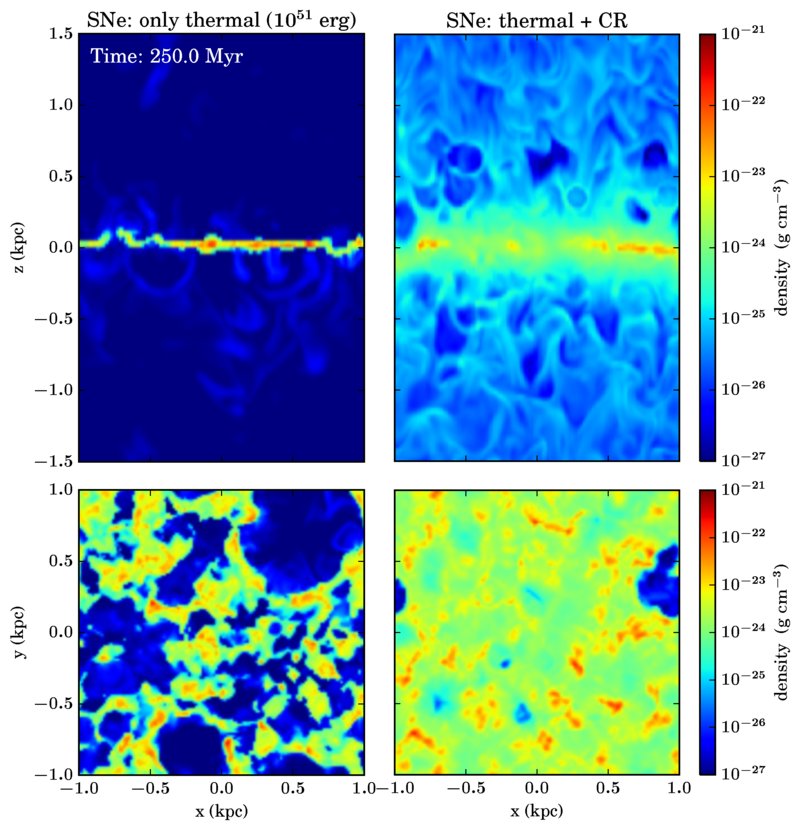
by Philipp Girichidis, Max-Planck-Institut fuer Astrophysik, Garching, Germany
Cosmic rays (CRs) contribute a significant fraction to the overall energy budget in the interstellar medium (ISM). Being high-energy particles, they have a small direct collisional interaction with the gas and therefore
different cooling and transport properties compared to the thermal gas. We present magnetohydrodynamic simulations of the supernova (SN)-driven, multi-phase ISM in stratified boxes with self-consistent modelling of the cosmic ray transport from the production sites in SN remnants through the magnetised ISM. We find that cosmic rays have a significant impact on the gas distribution in the galactic disc. They increase the scale height of the gaseous component of the disk and are able to launch and sustain outflows with mass loading factors of order unity even for Milky-Way like environments. The interplay between the SN positioning and clustering, the CR injection fractions and diffusion speeds determine the mass loading of galactic outflows, the composition of the outflow and the structure of the gas within the galactic disk as well as in the halo.
(Abstract PDF)
Conditions and Impact of Massive Star Formation

by Rolf Kuiper, Institute of Astronomy and Astrophysics, University of Tübingen, Germany
The formation of massive stars yields strong feedback effects onto its host core and stellar cluster environment via protostellar outflows, radiation heating, radiation pressure, ionization, stellar winds, and supernova (in chronological order). From a theoretical point of view, the question arises, how a massive protostar is able to accrete its mass up to the observed upper mass limit despite e.g. its strong radiation pressure feedback alone.
In this talk, I present results of several series of self-gravitating radiation-hydrodynamics simulations of core collapse towards high-mass star formation, including the effects of radiation heating, radiation pressure, protostellar outflows, (and preliminary: ionization). We propose a solution to the radiation pressure problem in the formation of massive stars via the so-called flashlight effect: due to the formation of an optically thick accretion disk, the thermal radiative flux becomes strongly anisotropic and preferentially escapes through the disk's atmosphere, i.e. perpendicular to the sustained accretion flow through the disk's midplane.
Furthermore, including feedback of early protostellar outflows yields a large scale anisotropy, which extends the disk's flashlight effect from the few hundred AU scale of the circumstellar disk to a core's flashlight effect up to a 0.1-parsec scale. This core’s flashlight effect allows core gas to accrete on the disk for longer, in the same way that the disk’s flashlight effect allows disk gas to accrete on the star for longer.
Finally, stability analyses of the forming accretion disks around high-mass protostar suggest that early disk fragmentation explains the observed multiplicity of massive stars.
In summary, I will demonstrate straight-forward mechanisms, which allows the formation of the most massive stars known in the present-day universe despite of their strong feedback. The basic theory of star formation herein is just a scaled-up version of low-mass star formation, i.e. based on accretion flows from core to disk to protostellar scales.
(Abstract PDF)
The ISM and Star Formation in Nearby Galaxies
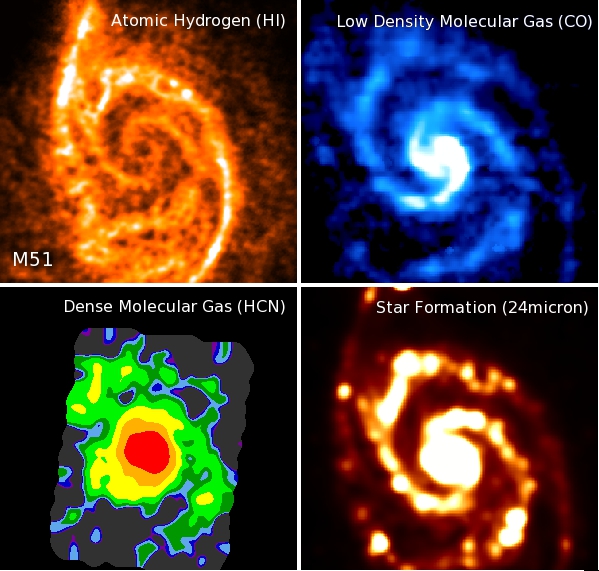
by Frank Bigiel, ZAH/ITA, Heidelberg University, Germany
I will provide an overview of various projects in our group studying the properties of the (gaseous) ISM and star formation in nearby galaxies. Specifically, I will cover first results from our IRAM 30m large program EMPIRE, where we map for the first the entire disks of 9 nearby galaxies in several molecular lines (e.g., HCN, HCO+, HNC) tracing the dense, immediately star forming gas. I will introduce the survey and ongoing projects and show first science results, where we relate these observations to existing mapping data from the radio to the UV to assess, e.g., if and how the fraction and star formation efficiency of the dense gas varies across disk galaxies and as a function of local conditions in the ISM. Another focus of my talk will be low-metallicity environments, where molecular lines are often difficult to observe and far-IR cooling lines may be our best handle on their star formation properties. In a series of projects, we model observations of the mid-IR and far-IR cooling lines in the Herschel Dwarf Galaxy Survey to characterize the physical conditions in the ISM of these low-metallicity systems. We find that such environments differ dramatically from those of more metal-rich disk galaxies. Most notably, the former are characterized by harder radiation fields and a porous structure, large filling factors of ionized gas and a large amount of molecular gas not observable using standard tracers like CO emission (“CO-dark gas”). Using velocity-resolved observations from SOFIA/GREAT, we find that this “CO-dark gas” can be up to 200 times more massive than that traced by CO emission.
(Abstract PDF)
Winter Term 2015/16
Electronic Spectra of Organic Radicals and Ions of Relevance to Interstellar Space

by John Maier, Universität Basel, Switzerland
Focus of our research is the measurement of the hitherto unknown electronic spectra of radicals and cations containing mainly carbon atoms, which are of astrophysical and combustion relevance. Initial information on the systems is often obtained by measuring the absorption in 6 K neon matrices using a mass-selected ion beam. In the gas phase the spectra of the neutral radicals are obtained by a resonant two colour photoionisation approach, whereas a radio-frequency trap is used for the cations. The mass-selected ions are restrained there and cooled by collisions with cryogenically cooled helium to 6–20 K prior to the measurement of the electronic transitions. The spectra have been obtained by a one- or two-colour, two-photon excitation-dissociation approach. A method to detect transitions using the difference in the rate of the complex formation with helium in the ground and excited electronic state has been demonstrated. The availability of gas phase spectra allows the in situ monitoring of the transient species in combustion processes and a direct comparison with astronomical observations. Such laboratory measurements at 6 K in the gas phase have led to the first definitive identification of two diffuse interstellar bands to C60+ .
(Abstract PDF)
Probing the Early Universe with Sub-millimeter Observations of Extremely Luminous QSOs

by Amy Kimball, CSIRO Astronomy & Space Science (CASS), Sydney, Australia
I will present ALMA observations of some of the most luminous quasi-stellar objects (QSOs) known, investigating their far-infrared emission and discussing an extremely broad and luminous double-peaked [CII] line in a QSO at redshift z=4.6. The parent sample was compiled from multi-wavelength sky survey data, with which we were able to identify the most luminous (unobscured) QSOs in the Universe. Of over 100,000 broad-line quasars identified in the SDSS, just 90 have bolometric luminosities greater than 1014 solar luminosities (as or more luminous than the most luminous obscured quasars currently known).
We are for the first time determining the far-infrared continuum of this extremely luminous population. In addition, an unusually broad [CII] line observed in one target suggests a massive rotating disk in place at redshift z=4.6, with implications for the high-redshift M-sigma relation.
(Abstract PDF)
What can we Learn from Presolar Grains about the Age of the Universe?

by Rene Reifarth, Goethe Universität Frankfurt, Germany
The synthesis of the chemical elements can be divided into two phases. First, the very short Big Bang Nucleosynthesis lasting less than one hour. The resulting matter consisted almost exclusively of hydrogen and helium. The birth of the first stars about 500 million years after the Big Bang marked the onset of the production of the heavier elements. Since than, more and more heavy elements are produced in different astrophysical processes.
The results of these processes can be observed in the abundance distribution of the solar system. In particular presolar grains found in meteorites are an extremely valuable source of information, since they are formed in single stars. The abundance distribution of the isotopes in these grains reflects the conditions inside the stars they are originating from.
Additional valuable information are imprinted in the abundance of long-lived radioactive nuclides. These nuclides act as tracers and record the history of the universe. It is therefore possible to constrain the time since the beginning of the nucleosynthesis and hence the age of the universe. A necessary condition is the knowledge is the underlying nuclear reaction rates under stellar condition with sufficient precision. A promising example is the nuclear decay of 87Rb. However, the production of 87Rb is strongly influenced by the neutron capture rate of 85Kr, which is only poorly known. Over the course of the next years, the stellar neutron capture cross section of 85Kr will therefore be investigated within the ERC funded project NAUTILUS.
(Abstract PDF)
From the Spectra of Molecular Complexes and Scattering Resonances to Rate Coefficients for Astrophysical Modeling

by Ad van der Avoird, Theoretical Chemistry, Radboud University Nijmegen, The Netherlands
Rate coefficients for ro-vibrational transitions in small molecules, such as CO, H2O, NH3 , and CH4, induced by collisions with other molecules or atoms are an essential ingredient in the astrophysical modeling of star-forming regions, protoplanetary disks, planetary atmospheres, etc. Such rate coefficients can be reliably obtained from quantum scattering calculations, if the corresponding intermolecular interaction potentials are accurately known. These potentials can be obtained from ab initio electronic structure calculations. I will describe how the accuracy of the potentials can be sensitively tested through calculations of the ro-vibrational levels of Van der Waals complexes and of molecular collision cross sections and comparison with high-quality experimental data. Then I will show results for collisions of CO, the second most abundant molecule in the interstellar medium, with hydrogen atoms and their application in astrophysical models.
(Abstract PDF)
Laboratory Astrophysics beyond CO

by Thomas Giesen, Universität Kassel, Germany
Detection of new molecules in space relies on accurate laboratory data accomplished by high level ab initio calculations. Especially for molecules which undergo large amplitude motions the approach of a rigid molecule is no longer useful. Linear C3, a textbook example for floppy molecules, turned out to be an abundant molecule in space [1,2]. Recently its structure has been derived experimentally from spectra of 13C substituted C3 measured at the Kassel laboratories for astrophysics. Singly 13C substituted species (13C12C12C and 12C13C12C) may also be abundant in space and a possible detection is feasible due to new laboratory data.
Beside C3 and other carbon chain molecules, small metal containing species and complex organic molecules as well are subject to current investigation at the Kassel laboratories. Their relevance to astrophysical environments have been approved by recent interstellar detections of new metal containing species and large organic molecules (See e.g. Ref [3-6]). The talk presents current progress and developments at the Kassel laboratories.
[1] B. Mookerjea, G.E. Hassel, M. Gerin, T. Giesen, J. Stutzki et al., Astron. Astrophys. 546, Art. No. A75 (2012)
[2] B. Mookerjea, T. Giesen, J. Stutzki et al., Astron. Astrophys. 521, Art. No. L13 (2010)
[3] T. Kaminski, C. A. Gottlieb, K. M. Menten, N. A. Patel, K. H. Young, S. Brünken, H. S. P. Müller, M. C. McCarthy, J. M. Winters, and L. Decin, Astron. Astrophys. 551 (2013), Art. No. A113.
[4] E. D. Tenenbaum and L. M. Ziurys, Astrophys. J. 694, L59–L63 (2009).
[5] E. D. Tenenbaum and L. M. Ziurys, Astrophys. J. 712, L93–L63 (2010).
[6] A. Belloche, R. T. Garrod, H. S. P. Müller, and K. M. Menten, Science 345, 1584–1587 (2014)
(Abstract PDF)
A Challenging Journey in High-resolution Infrared Laboratory Spectroscopy

by Michel Herman, Laboratoire de Chimie quantique et Photophysique, Université libre de Bruxelles, Belgium
The seminar will focus on the investigation of the absorption spectrum of ammonia (14NH3 and 15NH3) in the laboratory, in the far to near-infrared spectral ranges. A variety of instrumental techniques and different experimental conditions are used that will be presented. The study of vibrational overtones in the near-infrared range will be highlighted. Although they cannot be accessed as easily as fundamental vibrations, vibrational overtones play an important role in several scientific applications, including detection in the field, as will be demonstrated. Overtones have intriguing properties, facilitate the study of intramolecular dynamics and offer numerous challenges. Among these is the observation of van der Waals complexes. Some ammonia containing weakly bound structures excited in their vibrational overtones happen to show well-resolved spectral structures despite near-infrared energy excites them significantly above their dissociation limit. Unsolved problems concerning the carrier of mysterious bands observed with ammonia and rare gases in a supersonic expansion will be presented. The seminar will focus on trends and challenges and not on detailed spectroscopic aspects.
(Abstract PDF)
The HI and H2 Gas Content and Sub-mm Line Emission of Galaxies over Cosmic Time
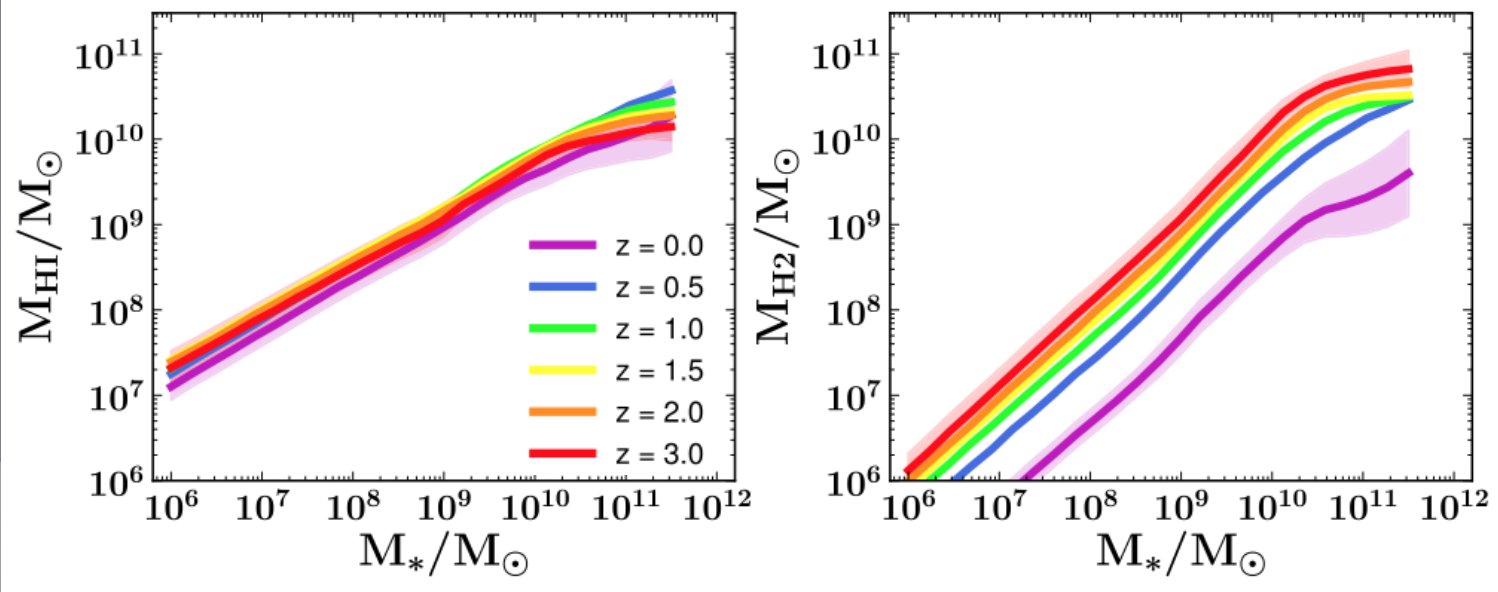
by Gergö Popping, ESO Garching, Germany
The star-formation activity of our Universe increased from early epochs (z~6), peaked around z=2, and then decreased by an order of magnitude until present age. To fully appreciate the physical origin of the star-formation activity of our Universe we need to focus on the gas content of galaxies over cosmic time. The most recent versions of cosmological models of galaxy formation explicitly include the detailed tracking of the atomic and molecular hydrogen content of galaxies and make predictions for the sub-mm lines emission from species such as CO, HCN, [CII]. New semi-empirical approaches provide data-driven predictions for the atomic and molecular gas content of galaxies. I will discuss the predictions made by these different types of models for the HI and H2 content of galaxies and their sub-mm line emission. These predictions include a weak evolution in the HI content and HI mass function of galaxies, strong evolution in the H2 content of galaxies, the weak evolution in the cosmic density of HI, the evolution of atomic and molecular gas in dark matter haloes, CO SLEDs of galaxies over cosmic time, and predictions for CO luminosity functions. I will compare these predictions to current observational samples, discuss future observing strategies, and will also demonstrate how the combination of cosmological and semi- empirical models can help to reveal caveats in our understanding of galaxy formation.
I will finish by showing our recent efforts to couple cosmological zoom-in hydro simulations with a radiative transfer code to model the emission and distribution of different CO rotational transitions in main-sequence galaxies at z=2.
(Abstract PDF)
Inside-Out Planet Formation

by Jonathan Tan, University of Florida, USA
The Kepler-discovered systems with tightly-packed inner planets (STIPs), typically with several planets of Earth to super-Earth masses on well-aligned, sub-AU orbits may host the most common type of planets in the Galaxy. They pose a great challenge for planet formation theories, which fall into two broad classes: (1) formation further out followed by migration; (2) formation in situ from a disk of gas and planetesimals. I review the pros and cons of these classes, before focusing on a new theory of sequential in situ formation from the inside-out via creation of successive gravitationally unstable rings fed from a continuous stream of small (~cm-m size) "pebbles," drifting inward via gas drag. Pebbles first collect at the pressure trap associated with the transition from a magnetorotational instability (MRI)-inactive ("dead zone") region to an inner MRI-active zone. A pebble ring builds up until it either becomes gravitationally unstable to form an Earth to super-Earth-mass planet directly or induces gradual planet formation via core accretion. The planet continues to accrete until it becomes massive enough to isolate itself from the accretion flow via gap opening. The process repeats with a new pebble ring gathering at the new pressure maximum associated with the retreating dead-zone boundary. I discuss the theory’s predictions for planetary masses, relative mass scalings with orbital radius, and minimum orbital separations, and their comparison with observed systems. Finally I speculate about potential causes of diversity of planetary system architectures, i.e. STIPs versus Solar System analogs.
(Abstract PDF)
Formation and Evolution of Giant Molecular Clouds: Gravity or Turbulence?

by Mordecai-Mark Mac Low, Department of Astrophysics, American Museum of Natural History, USA and Institut für Theoretische Astrophysik, Zentrum für Astronomie der Universität Heidelberg, Germany
Star formation in galaxies is observed to occur in molecular clouds. However, the origins and evolution of these clouds remains unclear, impeding the construction of a predictive theory of star formation. Indeed, the necessity of molecules for star formation has come into question, as it becomes clear that their formation may just be a side
effect of star formation, correlated with gravitational collapse but not causing it. In this talk I will present kiloparsec-scale, well-resolved, MHD simulations of the stratified, supernova-driven, interstellar medium performed with the Flash code. I will use the results of these simulations to argue that gravitational collapse rather than any sort of turbulent equilibrium determines the dynamics of molecular clouds, with a focus on the relationships between size, velocity dispersion, and surface density of the clouds.
(Abstract PDF)
The Dance of Stars in Galactic Nuclei

by Michela Mapelli, NAF - Osservatorio Astronomico di Padova, Italy
Super-massive black holes (SMBHs) give us a unique opportunity to study astrophysical processes under extreme conditions. The innermost parsecs around an SMBH should be a hostile environment for star formation. Molecular clouds are expected to be disrupted by the SMBH's tidal shear before they approach the central parsec. Thus, stars cannot form in 'normal conditions', even if the SMBH is quiescent. Despite this, we DO observe young (100 Myr) stars in the central parsec of our Galaxy. Furthermore, several observations suggest recent episodes of star formation in nearby galactic nuclei. Modelling the formation and the dynamical evolution of such young stars is an essential step to understand the interplay between an SMBH and its environment. In this talk, I will discuss the most recent scenarios proposed to explain the formation of stars close to SMBHs. I will show that the orbital evolution of the young stars can be used to probe the distribution of gas in the innermost parsecs of a galaxy. Finally, I will speculate on the chance of observing planets bound to SMBHs.
(Abstract PDF)
The Small and the Beautiful: How the Star Formation Law Affects Galactic Disk Structure
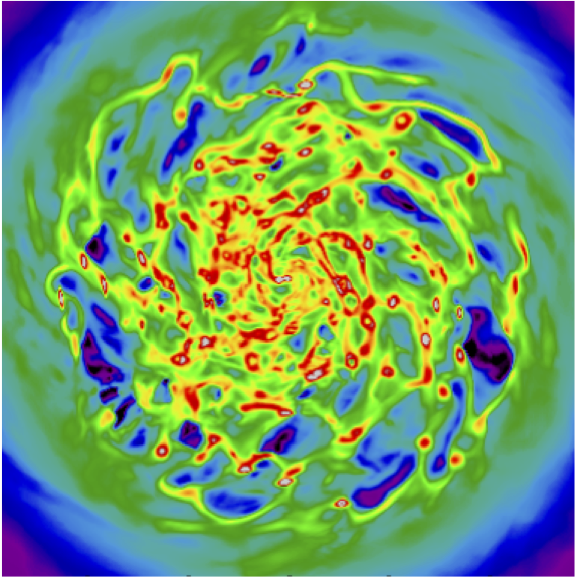
by Wolfram Schmidt, Hamburg Observatory
Star formation and supernova feedback cannot be numerically resolved in global simulations of disk galaxies. I will show how analytical models of star formation can be utilized as subgrid-scale models for simulations, here the star formation efficiency is locally expressed as a function of the turbulent Mach number and viral parameter on sub-resolution scales. However, there are substantial variations in the theoretical prescriptions. A systematic study of the impact of different star formation models in galaxy simulations reveals which models reproduce expected properties of galaxies. A roughly constant global star formation rate and a nearly linear relation between the local star formation rate and the molecular hydrogen column density in agreement with observational constraints is found for multi free-fall models. This means that the local free-fall time scale is integrated over the probability density function of numerically unresolved fluctuations with respect to the cell-averaged gas density. In other words, these models assume multiple free-fall time scales corresponding to the distribution of density fluctuations produced by turbulence in each grid cell. For simpler models, differences become apparent when the disc structure and the distribution of the gas over the different phases of the ISM are considered. In particular, the self-regulation of star formation is broken and a very clumpy disk not even remotely resembling a Milky-Way-like galaxy is produced in some cases.
(Abstract PDF)
Summer Term 2015
From Photochemistry to Microsolvation in Superfluid Helium Nanodroplets
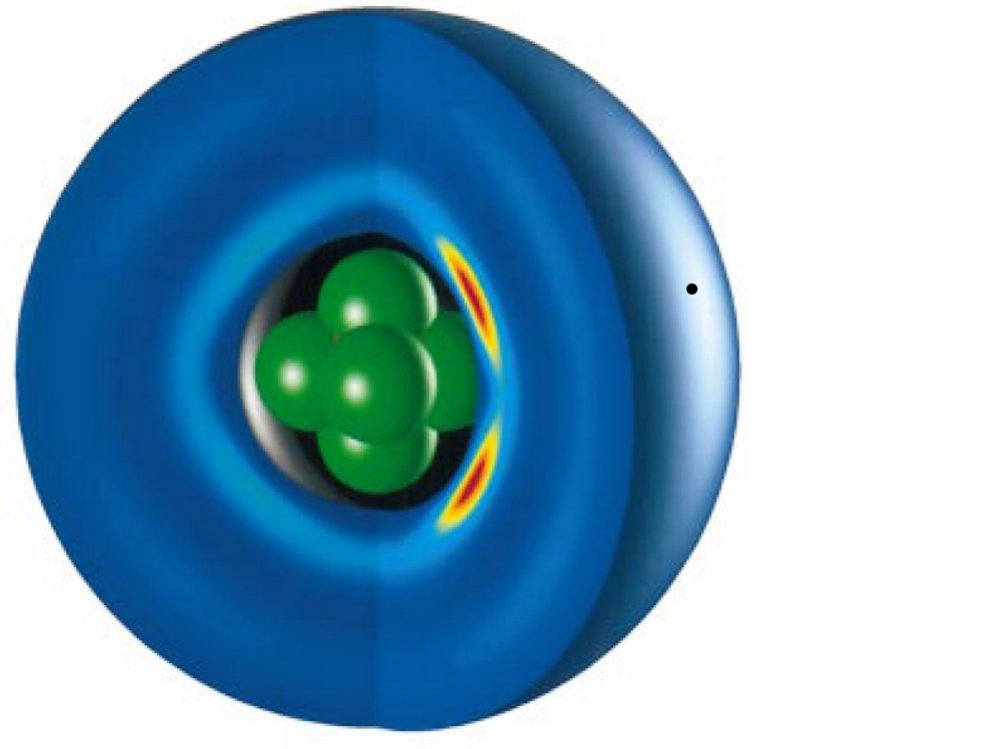
by Alkwin Slenczka, Institut für Physikalische und Theoretische Chemie, Universität Regensburg, Germany
Helium droplets serve as cryogenic host system for atoms, molecules and clusters to study structures and low temperature chemistry. The unique properties of helium droplets are based on the superfluid phase and have been revealed by high resolution spectroscopy in the micro wave, the infra red, and the UVvis spectral range. [1]
Our initial approach to utilizing helium droplets as cryogenic reactor for the study of photochemical processes revealed surprising perturbations induced by the superfluid helium environment. [2] It drew our attention to the helium environment. Molecular spectra recorded in helium droplets always carry information on both the dopant species and the helium droplet. [3] In order to interpret the molecular contribution it is important to understand the helium induced part of spectra. We feed this enterprise entirely from the experimental side. Systematic studies as well as detailed study mostly by means of electronic spectroscopy reveal information on the dopant to helium interaction and, thus, provide insight into microsolvation of molecules in superfluid helium droplet [4].
[1] J. P. Toennies and A. F. Vilesov, Angew. Chem. Int. Ed. 43 (2004) 2622.
[2] R. Lehnig, D. Pentlehner, A. Vdovin, B. Dick, A. Slenczka, J. Chem. Phys. 131 (2009) 194307.
[3] R. Lehnig, M. Slipchenko, S. Kuma, T. Momose, B. Sartakov, and A. Vilesov J. Chem. Phys. 121
(2004) 9396.
[4] T. Premke, E.-M.Wirths, D. Pentlehner, R. Riechers, R. Lehnig, A. Vdovin, and A. Slenczka,
Frontiers in Chemistry, Phys. Chem. and Chem. Phys. 2 (2014) Article 51.
(Abstract PDF)
Why is Star Formation Correlated with Molecular Gas?
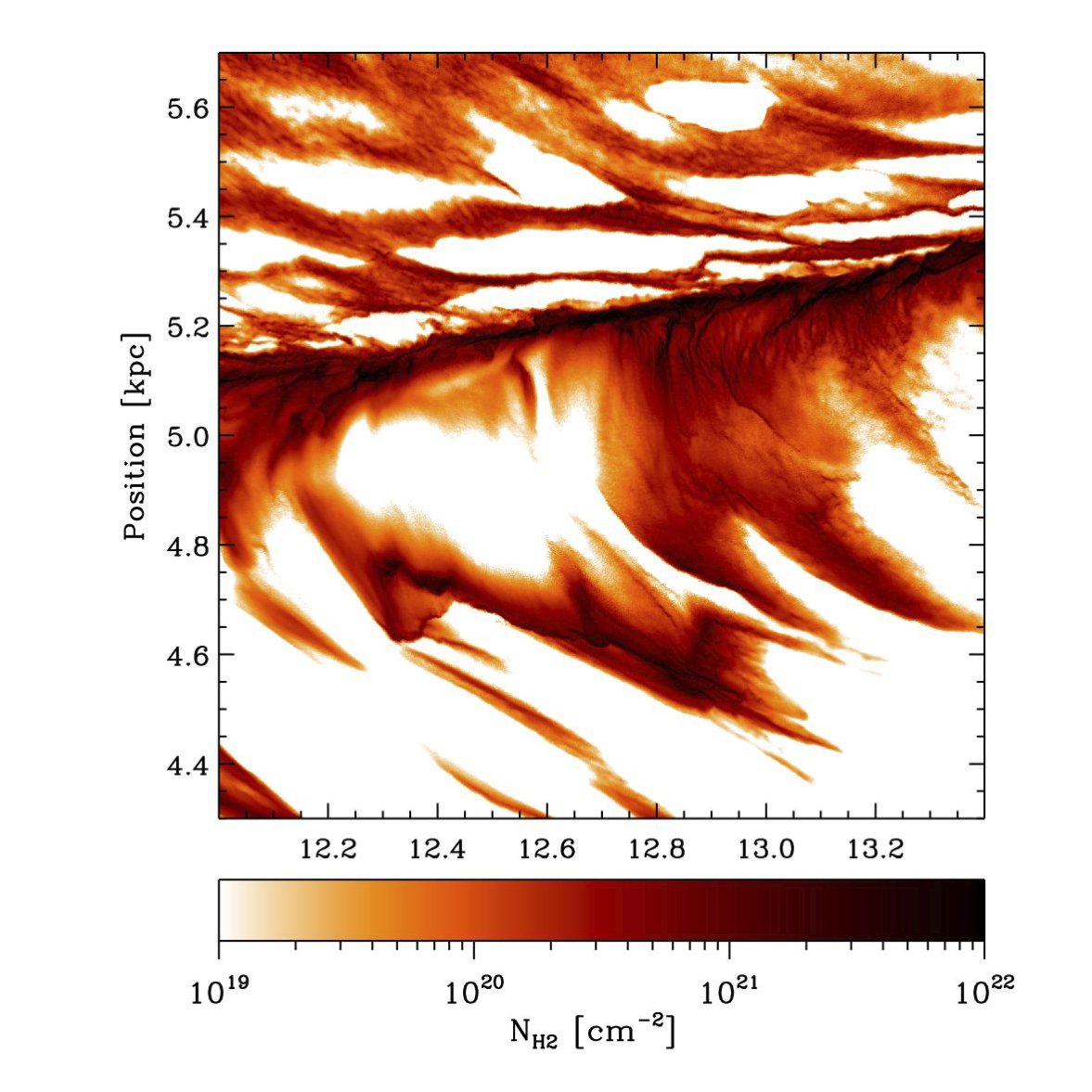
by Simon Glover, Zentrum für Astronomie, ITA, Universität Heidelberg, Germany
Observations of star formation within the Milky Way and other nearby metal-rich galaxies show that the surface density of star formation correlates better with the surface density of molecular gas than with the total surface density or the surface density of atomic gas. Although it is natural to assume that this correlation comes about because molecular gas is necessary for star formation, recent numerical studies have cast doubt on this assumption. Instead, they suggest that the correlation between molecular gas and star formation comes about because the conditions that favour star formation also favour the formation of molecules. In this talk, I will summarize this recent work and explore how we might test it observationally. I will also discuss what it implies for the relation between molecular gas and star formation in low metallicity galaxies.
(Abstract PDF)
Cold Plasmas in Laboratory Astrochemistry: Ions and Carbonaceous Dust Analogues
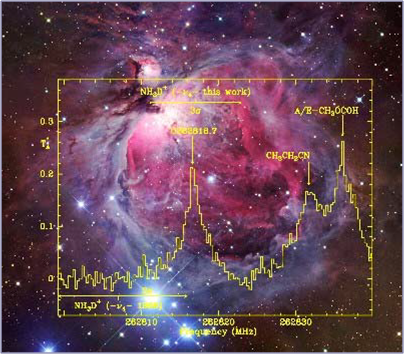
by Victor J. Herrero, Instituto de Estructura de la Materia (IEM-CSIC), Madrid, Spain
Víctor J. Herrero, Isabel Tanarro, José Luis Doménech, Belén Maté, Maite Cueto, Miguel Jiménez-Redondo, Esther Carrasco, Instituto de Estructura de la Materia (IEM-CSIC), Serrano 123, 28006, Madrid, Spain
José Cernicharo, Instituto de Ciencia de Materiales de Madrid (ICMM-IEM), Sor Juana Inés de la Cruz 3, 28049, Madrid, Spain
Cold plasmas are characterized by the lack of equilibrium between the high temperature (104-105 K ) of the electrons and the low temperature ( typically ∼ 300 K) of the heavy species (ions and neutrals) . They provide a highly reactive medium at low temperature and find widespread application in science and technology. Cold plasmas are usually produced in electrical discharges and can be employed for the generation of astrochemically relevant species, unstable under ordinary conditions like radicals or ions, that can then be used for spectroscopic or kinetic studies. The analysis of the plasma chemistry could also give clues about chemical pathways for these species in space.
The high resolution IR spectroscopy of the NH3D+ and ArH+ ions has been investigated in hollow cathode discharges by means of a difference frequency laser technique. The measurements for NH3D+ contributed to the recent detection of this ion in the interstellar medium (ISM). The available IR data for the astronomically relevant 36ArH+ and 38ArH+ isotopes were significantly increased.
Glow discharges of methane were also used to produce different deposits of hydrogenated amorphous carbon (a-C:H), that is a likely candidate for carbonaceous dust in the diffuse ISM. The results are compared with observations and with previous laboratory work.
(Abstract PDF)
Circuit Quantum Electrodynamics of DC-driven Electrical Conductors

by Marc Peter Westig, Service de Physique de l’Etat Condensé CNRS UMR 3680, CEA Saclay, France
A dc biased quantum conductor gives rise to current fluctuations, as a result of the granularity of charge carriers and the probabilistic character of quantum transport. Such current fluctuations may excite the surrounding electromagnetic modes, opening up an essentially unexplored regime of light-matter coupling at the quantum level. This light-matter coupling can be engineered on-chip leading to unparalleled detection efficiences for the emitted radiation.
I will report on recent experiments exploring the physics of the quantum-classical boundary with a superconducting circuit. The device consists of a voltage biased Josephson junction coupled to either one resonator or two resonators of different frequencies. The quantum fluctuations of the current through the junction couple to the resonator(s), so that a dc current flows through the junction when the transfer of a Cooper pair corresponds to the emission of an integer number of photons into the resonator(s). These photons can then retroact on the transfer of other Cooper pairs.
We show (1) that the radiation emitted by the Josephson junction into two different electromagnetic modes exhibits non-classical power correlations, (2) the transition of incoherent to coherent Cooper pair tunneling resulting in photon super-bunching and the present progress of (3) an experiment which aims to realize photon anti-bunching.
The progress in the development of the measurement technologies needed to perform these challenging experiments offer us tools to design a new experiment to explore fundamental physics of superconducting hot-electron bolometer frequency mixers through a measurement of their dynamical charge transport.
(Abstract PDF)
Probing the Methanol and CO Snow Lines in the Young Protostar NGC 1333-IRAS4B

by Sibylle Anderl, Institut de Planétologie et d'Astrophysique de Grenoble, France
One central question in the context of star formation concerns the evolution of complex chemistry that could eventually trigger the onset of life. In the interstellar medium, complex organic molecules seem to mostly form in reactions happening on the icy surface of dust grains, such that they are released into the gas phase when the dust is heated. The resulting “snow lines”, marking regions where ices start to sublimate, play an important role for planet growth and bulk composition in protoplanetary disks. However, they can already be observed in the envelopes of the much younger, low-mass Class 0 protostars that are still in their early phase of heavy accretion. The information on the sublimation regions of different kinds of ices can be used to understand the chemistry of the envelope, its temperature and density structure, and may even hint at the history of the accretion process. Accordingly, it is a crucial piece of information in order to get the full picture of how organic chemistry evolves already at the earliest stages of the formation of sun-like stars. As part of the CALYPSO Large Program (cf. http:/irfu.cea.fr/Projets/Calypso/), we have obtained observations of C18O, N2H+ and CH3OH towards the Class 0 protostar NGC 1333-IRAS4B with the IRAM Plateau de Bure interferometer at sub-arcsecond resolution. We observe an anti-correlation of C18O and N2H+, with N2H+ forming a ring (perturbed by the outflow) around the centrally peaked C18O emission. This reveals the CO snow line in this protostellar envelope with unprecedented resolution, with a radius of ~300 AU. In addition, we observe compact methanol emission, with a radius of ~40 AU. We have modeled the emission using a chemical model coupled with a radiative transfer module, using the temperature and density profiles self-consistently determined by Kristensen et al. (2012). We find that the CO snow line appears further inwards than expected from the binding energy of pure CO ices. This may hint at CO being frozen out in H2O or CO2 dominated ices. Our observations can thereby yield clues on the widely unknown composition of interstellar ices, being the initial seeds of complex organic chemistry.
(Abstract PDF)
Are All Galaxies the Same? A Synchronized, Uniform Framework for Galaxy and Black Hole Evolution
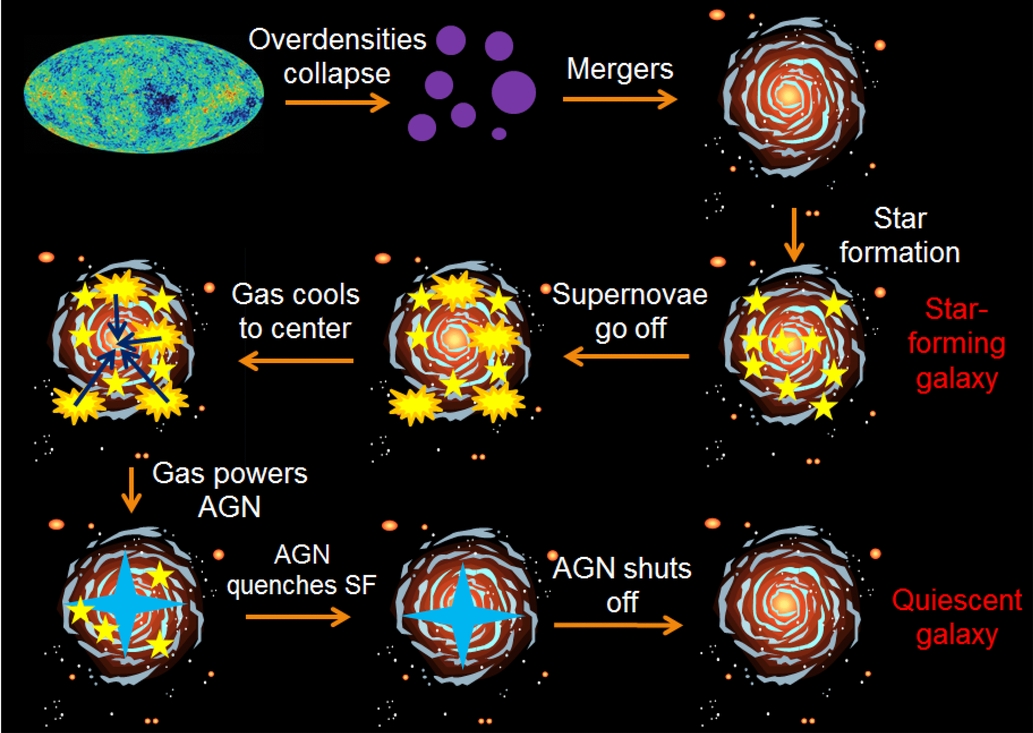
by Charles Steinhardt, Dr. Charles Steinhardt, California Institute of Technology, Pasadena, USA
Initial results from SPLASH, an ultra-deep multi-wavelength survey, allow a study of star formation out to z~6. Combining these results with dozens of star formation and supermassive black hole accretion studies, there is a consistent picture of galactic evolution at 0 z 6. These results also create tension with hierarchical merging at high redshift. We can define a "synchronization timescale" for galaxies as a measure of the uniformity of an ensemble of galaxies at various cosmic epochs. If galaxy evolution is dominated by stochastic processes, then galactic events occurring at high redshift should happen at nearly the same time across an ensemble of galaxies, while events occurring at low redshift should be much less synchronous. Surprisingly, this synchronization timescale is both mass- and time-independent, a constant 1.4 Gyr for all combinations of mass and time. As a result, we are prompted to consider a framework for galactic evolution along a main sequence so that star formation, supermassive black hole accretion, and feedback between the two are dominated by deterministic rather than stochastic processes.
(Abstract PDF)
Star Cluster System Dynamics as a Probe into Star Formation
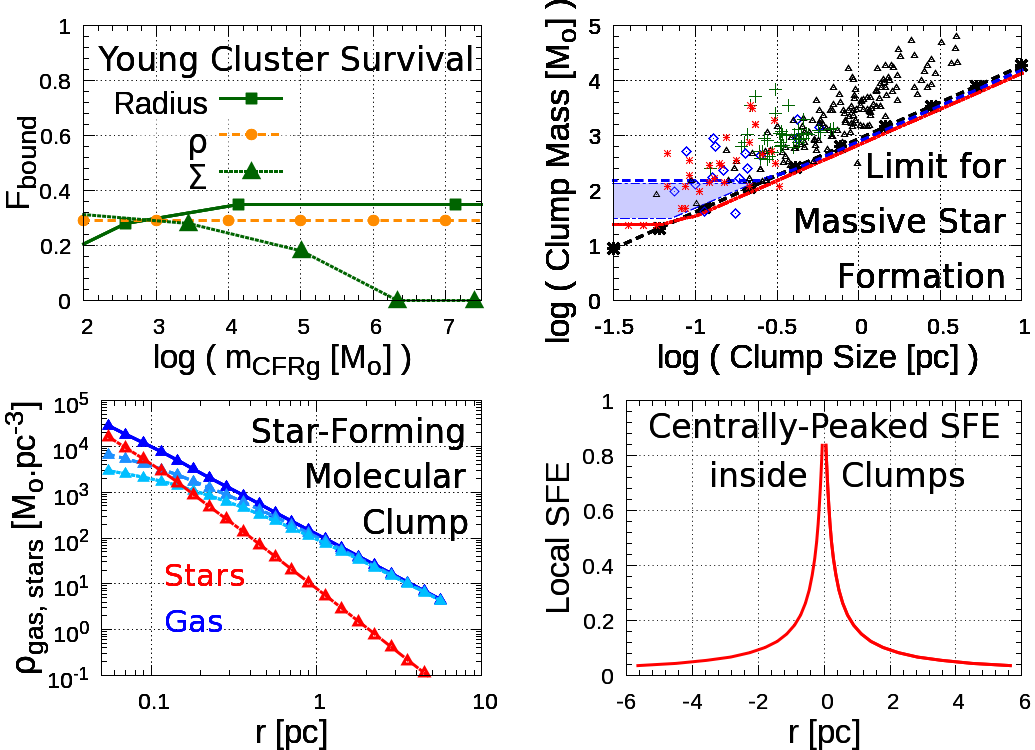
by Geneviève Parmentier, Zentrum für Astronomie, Astronomisches Rechen-Institut, Universität Heidelberg, Germany
Star clusters constitute a major channel of star formation in the local Universe. And as groups of largely coeval stars, they can be detected against the background of their host galaxy, and age-dated. They are therefore vital tracers of the process of star formation, as well as of the history of galaxies. As time goes by, however, star clusters steadily lose their stars and, eventually, get completely dissolved, a process which depends sensitively on their formation conditions. A thorough understanding of cluster formation conditions is therefore urgently needed to reconstruct the star formation history of galaxies from the encoded record left by their surviving star clusters.
In this presentation, I will show how the properties of star cluster systems can be exploited to probe into the formation conditions of star clusters. Specifically, I will build on the evolution with time of the cluster mass distribution to constrain the mass-radius relation of clusters at birth, and to explain the limit for massive star formation observed in the mass-radius space of molecular structures. These results
have stimulated the development of a new model for cluster formation. Not only is this model able to explain the steep relation between the local surface densities of molecular gas and young stellar objects of the Solar Neighbourhood, it has also prompted us to reassess the ability of clusters to survive the expulsion of their residual star-forming gas. Stellar age spreads in clusters as a function of their mean volume density will also be discussed.
(Abstract PDF)
Deep Surveys with GISMO: Searching for Luminous Starforming Galaxies at the Highest Redshifts
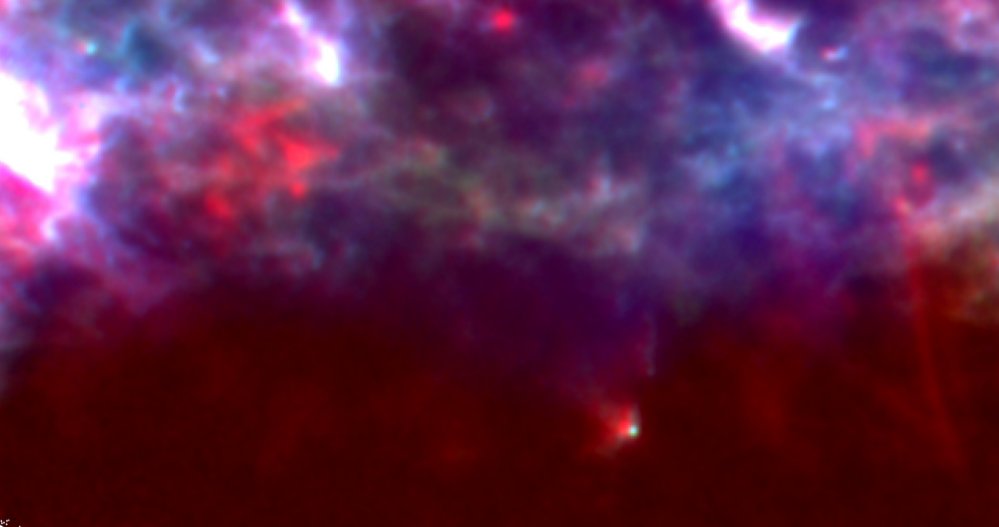
by Johannes Staguhn, Johns Hopkins University & NASA's Goddard Space Flight Center, USA
The GISMO 2mm bolometer camera the IRAM 30m telescope has been available to the astronomical community for many years. GISMO provides observational capabilities across a wide range of astronomical targets, including observations of galactic dust and free-free emission, the characterization of the SEDs of nearby galaxies, detecting dusty galaxies at high redshifts, and measurements of the Sunyaev–Zel'dovich decrement in the Cosmic Microwave Background Radiation, which traces the evolution of massive galaxy clusters throughout the history of the universe. The 2mm band is in particular well suited to trace the first dusty galaxies in the universe, since their redshifted SEDs peak close to GISMO's observing frequency, whereas the medium redshift galaxy foreground is almost invisible in this band. This effect makes GISMO's deep field observations a valuable complement, rather than a redundancy, to the HERSCHEL far-infrared and sub-mm surveys. Two deep sky surveys with GISMO.
Following a brief overview over some science highlights from the large variety of GISMO projects, we will describe two survey projects in detail. Models predict that an appreciable number of galaxies serependiously detected in deep 2mm surveys will be at very high redshifts (z~5-6 and above) with intrinsic luminosities of a few 1012 Lsol. The galaxy number counts, which can be derived from those surveys, provide new information on the evolution of star-forming galaxies throughout the history of the universe, one of the core science goals of GISMO. The first of these surveys is the GISMO Deep Field (GDF), which is centered on the Hubble Deep Field North. This deep survey by now has reached the confusion limit of the 30m telescope (we measure a confusion noise of 60 microJy at 2mm wavelength), and therefore provides galaxy count numbers at the lower end of the luminosity function. The second survey covers a shallower ~ 1/4 square degree region in the COSMOS field, in which by now we have obtained sufficient sensitivity to extract statistically relevant galaxy number counts at higher luminosities than in the GDF. By using auxiliary data, we also can study the redshift distribution of our deep field sources. We will present first COSMOS results that complement those obtained in the deeper GDF. A statistical analysis of the survey data provides a solid estimate of the expected rate of false detections among the source identifications. Furthermore, numerical simulations were used to estimate the "completeness" of our set of extracted sources. We will discuss how the derived galaxy counts compare to model predictions, allowing us to test galaxy evolution models.
Finally, we will provide an outlook into the future by outlining the variety of science questions, which we anticipate to address with our new dual band (1mm and 2mm) bolometer camera GISMO-2.
(Abstract PDF)
Winter Term 2014/15
Variations of Interstellar Grain Properties in Galaxies: Constraining Dust Evolution Models with Observations
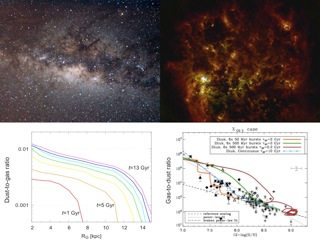
by Svitlana Zhukovska, Max-Planck-Institut für Astronomie, Heidelberg, Germany
Interstellar dust is indispensable component of the ISM and both a tracer of and active player in galactic evolution. Understanding of dust properties as a function of galactic environment can be improved by constraining dust evolution models with observations on multiple galactic scales. Local dwarf galaxies allow to study interstellar dust sources and probe their roles during galactic history.
I will discuss constraints on models of dust input from low- and intermediate-mass stars from recent Spitzer surveys of the Magellanic Clouds. To constrain the controversial efficiencies of dust condensation in type II SNe, we combine generic models of dust evolution in dwarf galaxies with recent Herschel observations of a large sample of dwarf galaxies. We show that the observed dust-to-gas ratio vs. metallicity relation requires relatively low condensation efficiency in SNe and additional growth of dust mass by accretion in the ISM, in contrast to previous studies.
Finally, I will introduce a more detail model of interstellar dust evolution based on hydrodynamical simulations of the lifecycle of molecular clouds aiming at interpretation of the small-scale variations of dust abundances observed in the local Milky Way.
(Abstract PDF)
The Galactic Centre: a Template for Understanding Star Formation in a High Pressure Environment
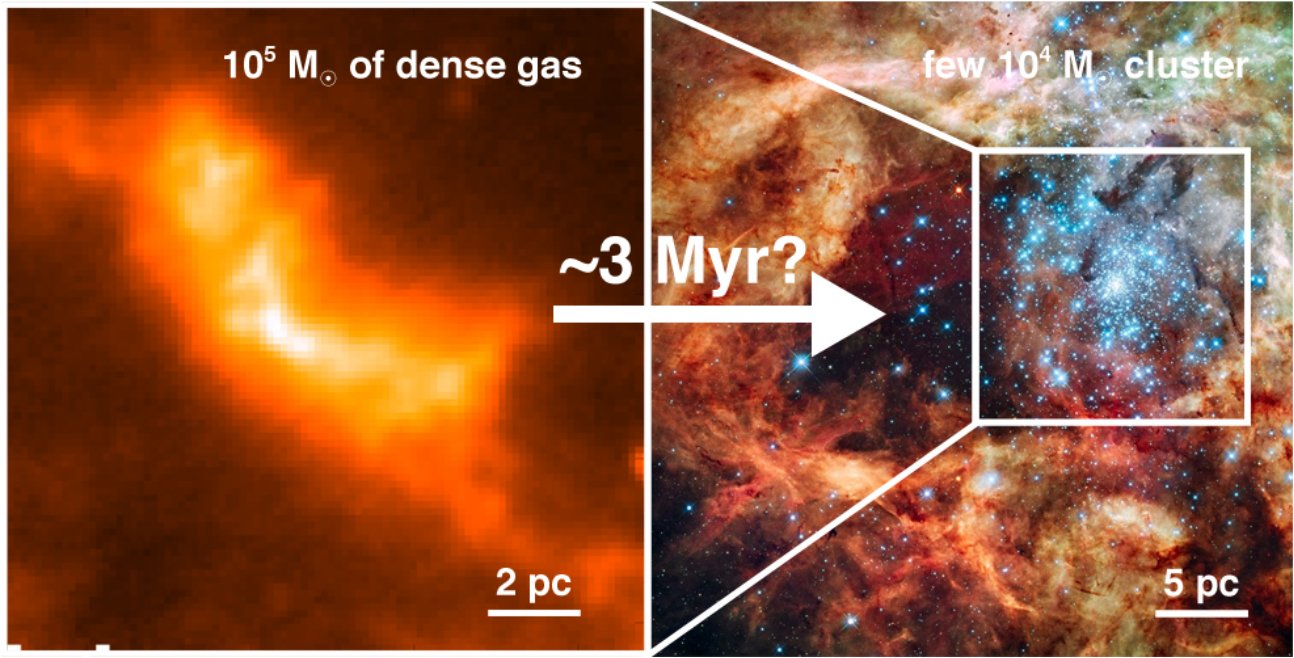
by Steven Longmore, Astrophysics Research Institute, Liverpool John Moores University, UK
10% of the total molecular gas in the Galaxy lies within the central 500pc. The density, temperature and pressure of this gas are extreme compared to that in the solar neighbourhood and disks of nearby galaxies, but similar to gas in high-z clouds and galaxies. Our Galactic centre can be studied at a level of detail unimaginable for such extragalactic systems, and is a natural bridge between Galactic and extragalactic star formation studies. I will summarise our recent work using the Galactic Centre as a laboratory for understanding both star formation and super star cluster formation in such extreme environments.
I will focus on a gas stream orbiting 200pc from the Galactic centre which contains the four most
massive and dense clouds in the Galaxy. The star formation in these super star cluster progenitor clouds appears to have been triggered by tidal compression during pericentre passage near the central supermassive black hole. This offers a unique opportunity to study the physics of stellar mass assembly as a function of absolute time. I will present our initial results exploiting this system of clouds to follow
the evolution of the core mass function with time since star formation was instigated and provide the first direct and time resolved tests of turbulent star formation theories in such an extreme environment: is the "critical density" for star formation ~4 orders of magnitude larger than the "universal" threshold reported in solar neighbourhood clouds? is the instantaneous star formation efficiency determined simply by the mass of gas above the critical density and the length of time that has passed since SF began? does this explain why the galactic centre violates density-dependent star formation relations by an order of magnitude?
These results represent the first steps towards a new benchmark for star formation and super studies in
environments closer to the conditions in which most stars in the Universe are thought to have formed, i.e. high-pressure environments in high-z galaxies.
(Abstract PDF)
Recent Advances in Reactive Scattering: From Combustion Chemistry to Interstellar Chemistry
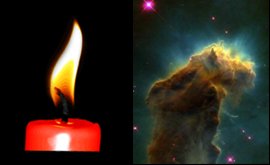
by Piergiorgio Casavecchia, Universita' degli Studi di Perugia, Italy
The reactions of ground state 3P oxygen atoms with unsaturated hydrocarbons have been the subject of extensive research because of their important role in combustion and atmospheric chemistry. Recently, these reactions have been recognized to have also general implications for the chemistry of interstellar medium (ISM). While efficient reactions with C-containing radicals in O-poor/C-rich environments do not destroy the C-C bond (rather elongate the C-atom skeleton), in O-rich environments of the ISM the growth of unsaturated hydrocarbons is strongly reduced, as these molecules are degraded to CO (or its precursor species HCCO and HCO) in the same way as it occurs in terrestrial environments of oxidizing (O-rich) flames.
For reliable modeling of combustion as well as of ISM oxygen chemistry, detailed knowledge is required of primary products and branching ratios for O(3P)+unsaturated hydrocarbon reactions. However, despite extensive kinetics and theoretical work over many decades, limited information exists on the nature of primary products, branching ratios, the role of intersystem crossing (ISC) from triplet to singlet potential energy surfaces (PESs) and overall reaction dynamics. The method most suitable for providing this critical information is the crossed molecular beams (CMB) scattering technique with mass spectrometric detection, empowered with “soft” ionization.
In this talk, I report on our recent investigations of the reaction dynamics of O(3P) with acetylene, ethylene, allene, methylacetylene and propene using the CMB method. By exploiting “soft” electron-ionization we have probed all energetically allowed product channels and characterized the dynamics, branching ratios and extent of ISC. The experimental results are compared with statistical calculations on ab initio PESs. For the benchmark multichannel non-adiabatic reaction O+C2H4, results are also compared with those of synergic quasiclassical trajectory surface-hopping computations on full-dimensional coupled ab initio triplet/singlet PESs. Recent upgraded chemical models for various astrochemical environments, which include a revision of O(3P)+unsaturated hydrocarbon reactions, are noted.
(Abstract PDF)
Starbursts, Normal Galaxies and the Molecular Gas History of the Universe
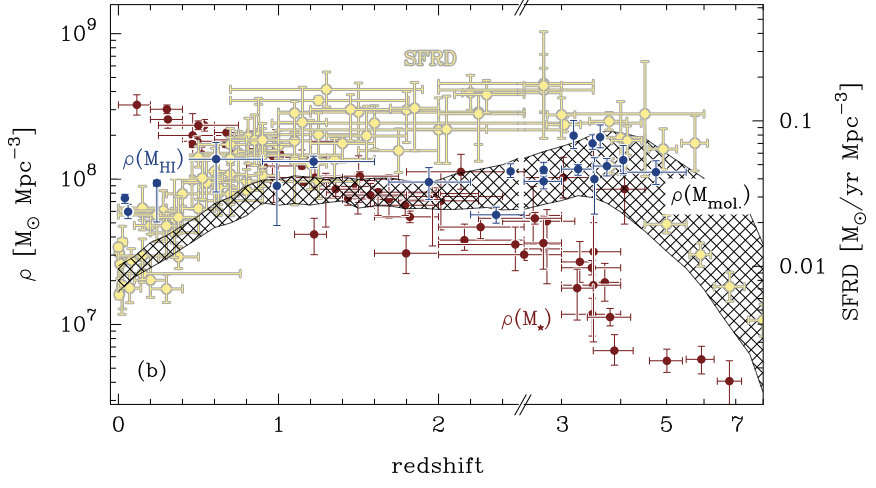
by Mark Sargent, Astronomy Centre, University of Sussex, UK
Observations during the past several years revealed the existence of a so-called "main sequence" for star-forming galaxies out to high redshift. While the majority of star-forming galaxies obeys this fairly tight relation between star formation rate (SFR) and stellar mass, a smaller subset of the population - referred to as "starbursts" - displays specific star-formation rates and star formation efficiencies (SFE) that can exceed those of “normal” (main-sequence) galaxies by an order of magnitude. But even though starbursts are among the most luminous and most rapidly growing objects in the Universe, the fact that they are relatively rare implies that most of the stars in present-day galaxies were formed in normal galaxies on the main sequence.
The study of the molecular gas which fuels the star formation in main-sequence galaxies near and far is thus a prominent area of current extragalactic astronomy. The interpretation of the CO-line emission from the roughly 150 normal star-forming galaxies detected to date at z > 0 suggests that there is a high degree of homogeneity between low- and high-redshift main-sequence galaxies in terms of their molecular gas properties. I will show that the variations of SFE and gas fraction about the characteristic value of a “typical” main sequence galaxy do not change over the range z 3. For starbursts, the change in SFE scales supralinearly with the SFR enhancement, as expected for merging events, implying a continuous distribution of galaxies in the Schmidt-Kennicutt plane that is not strictly bimodal, but nevertheless more clearly separated into a locus for starbursts and normal galaxies than their relative distribution in the space of SFR and stellar mass.
I will discuss how we can exploit these scaling relations to infer the molecular gas properties (e.g. H2 mass functions and CO-luminosity functions) of the large samples of distant star-forming galaxies that await detection in upcoming blind sub-mm surveys with ALMA and the JVLA. I will also apply our formalism for distinguishing between starbursts and normal galaxies to constrain the fraction of the total molecular gas content of the Universe that fuels burst-like and secular star-formation activity, respectively.
(Abstract PDF)
Strange Bonds and Odd Angles: Exploring the Fascinating World of High-energy Isomers using Rotational Spectroscopy
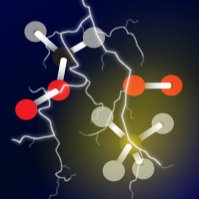
by Michael C. McCarthy, Atomic & Molecular Physics Division, Harvard-Smithsonian Center for Astrophysics, USA
Fourier transform (FT) microwave spectroscopy of supersonic molecular beams has developed into a remarkably sensitive technique for detecting and structurally characterizing transient species such as radicals, carbenes, highly-energetic isomers, and both positively- and negatively-charged molecular ions, which, once formed, often react at the gas-kinetic or Langevin rate. Although laboratory detection remains challenging, the rotational spectra of several hundred entirely new carbon, silicon, sulfur, and oxygen-bearing molecules have been detected by these means in our laboratory with collaborators and colleagues. Precise molecular geometries have been determined by means of isotopic substitution for nearly one-half of the newly found molecules.
This talk will provide a broad overview of our recent work, illustrating with a few specific examples the power of our laboratory techniques, and how these techniques can be applied to detect and characterize key reactive intermediates that are believed to play important roles in combustion, atmospheric, and interstellar chemistries. Many of the results are of general interest to the chemical physics community; they contribute to comparative studies of bonding between different elements in the Periodic Table, providing further evidence of the rich architecture of the chemical bond; and establish important benchmarks for theoretical chemistry. Recent work on reactive oxygen molecules such as HOON, dihydroxycarbene (HOCOH), and the simplest Criegee intermediate (CH2OO), will be highlighted.
Technological innovation is also an implicit part of our work. The feasibility of using chirped and cavity FT microwave spectroscopies to rapidly detect and automatically group spectral lines to entirely new species based on chemical and other assays, elemental composition, and exhaustive spectral cross-correlations using double resonance techniques will be discussed. Such methodologies may have important practical implications for analytical chemistry and ‘library-free’ detection.
(Abstract PDF)
Astrochemistry and Star Formation
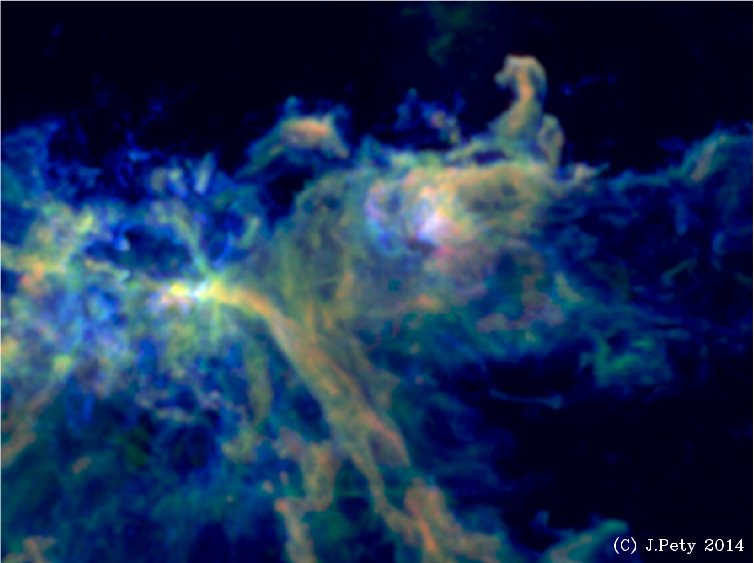
by Jérôme Pety, IRAM & Obs. de Paris, France
Molecular lines are used to trace the structure of the interstellar medium and the physical conditions of the gas in different environments, from high-z galaxies to protoplanetary disks. To fully benefit from the diagnostic power of molecular lines, the formation and destruction paths of the molecules, including the interplay between gas-phase and grain surface chemistry, must be quantitatively understood. Well-defined sets of observations of simple template sources are key to benchmark the predictions of theoretical models.
I will first present the observation and analysis of an unbiased spectral line survey at 3, 2 and 1mm with the IRAM-30m telescope in the Horsehead nebula, with an unprecedented combination of bandwidth, high spectral resolution and sensitivity. Two positions were observed: The warm photodissociation region (PDR) and a cold condensation shielded from the UV field. Approximately 30 species, with up to 7 atoms plus their isotopologues, are detected. These data are complemented by high-angular resolution IRAM-PdB interferometric maps of specific species.
The results include the detection of CF+, a new diagnostic of the UV illuminated gas; the detection of a new species in the ISM, C3H+; a deep study of the abundance, spatial distribution and excitation conditions of H2CO, CH3OH and CH3CN, which reveals that photo-desorption of ices is an efficient mechanism to release molecules into the gas phase; and the first detection of the complex organic molecules, HCOOH, CH2CO, CH3CHO and CH3CCH in a PDR, which reveals the degree of chemical complexity reached in the UV illuminated neutral gas.
I will then open the talk by the preliminary presentation of a complete 3mm spectral-image cube of the western edge of the Orion B molecular cloud (see image). These observations will provide a complete picture of the distribution of molecular emission in this template star forming region, which we will use to calibrate popular molecular probes, developing their full potential as tools of Galactic and extra-galactic star formation explorations.
(Abstract PDF)
Oceans of Data and Rosetta Stones: Understanding How the First Galaxies Formed

by Peter L. Capak, California Institute of Technology / IPAC, USA
I will begin by giving an overview of the Spitzer Large Area Survey with Hyper-Suprime-Cam (SPLASH), a 3.8 square degree survey of the COSMOS and SXDS fields. I will show early results on the evolution of the star forming galaxy main sequence, the galaxy mass function and galaxy clustering at 4 z 6 and what this teaches us about early galaxy formation. Next, I will show ALMA C[II] 158µm and dust continuum maps of ten normal z~6 galaxies selected from the SPLASH data as “Rosetta Stones”. These observations show us that the properties of the Interstellar Medium in galaxies are significantly evolving from z~6 to z~4, which must be accounted for when studying early galaxy formation. Finally, I will discuss the statistically robust tools I am developing to analyze the next generation of survey data from Euclid and LSST and how this will help us find the next set of “Rosetta Stones”.
The star forming galaxy main sequence is shown at z=5-6 based on data from the SPLASH-COSMOS field. Ten normal galaxies with ALMA Far-Infrared determined star formation rates are plotted in red. Note the generally good agreement with some significant outliers.
(Abstract PDF)
Deuterium Fractionation in Different Star-formation Environments
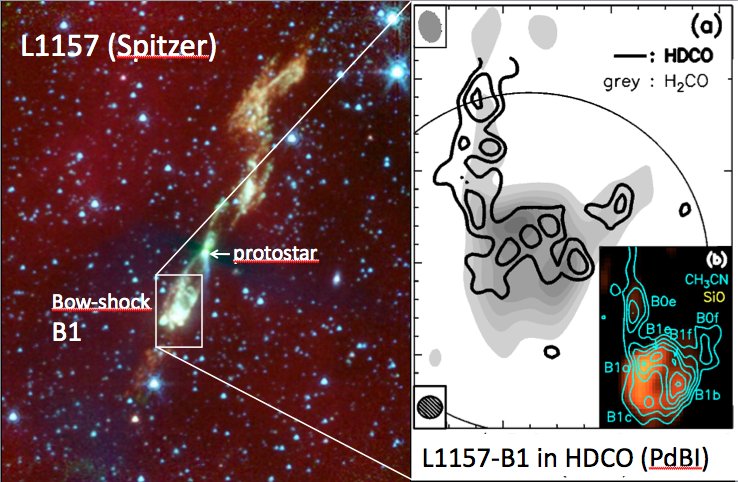
by Francesco Fontani, Osservatorio Astrofisico di Arcetri, Firenze, Italy
The process of deuterium enrichment in molecules from the main reservoir HD is initiated in molecular clouds by exothermic gas-phase reactions, which boost the formation of deuterated species in cold (T20K) gas, and inhibit it in warmer environments. For this reason, in the star-formation process, the fraction of deuterated molecules is thought to increase during the cold pre-stellar phase and then it is expected to drop after protostellar birth. Although this general framework remains true, growing observational evidence is showing that the story is not so simple. In fact, the deuterated species of several important molecules (NH3, CH3OH, H2O) can be formed also on the icy mantles of dust grains during the early cold phase, and then realeased into the gas due to evaporation/erosion of these mantles at later stages. This contribution from surface chemistry can hence make significant differences in the dependence with time of the observed deuterated fraction for molecules formed uniquely in the gas phase and those formed also on dust grains. This effect is expected to be relevant especially in environments where the impact of nascent stars on dust grains is most important, namely massive star-forming cores and protostellar outflows. I will present the main results obtained from observations of single-dish telescopes (IRAM-30m, Nobeyama-45m, GBT-100m), and interferometers (PdBI) with which we have surveyed several deuterated molecules (among which N2D+, NH2D, CH2DOH, DNC, HDCO) formed both in gas and on grain surfaces in both high-mass star forming cores and a prototypical chemically rich protostellar outflow, L1157-B1.
(Abstract PDF)
Search for Water and Ice in Planet-forming Disks
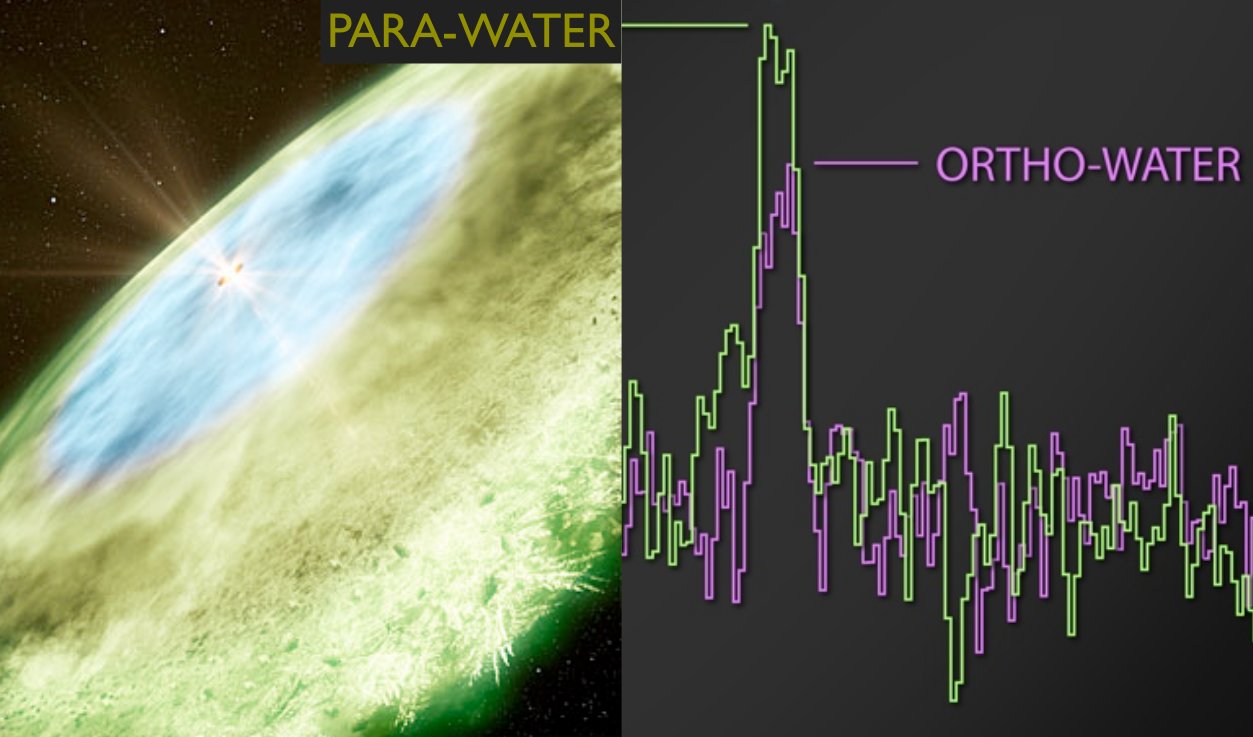
by Michiel Hogerheijde, Leiden Observatory, The Netherlands
Water is a key ingredient for life. Yet, the Earth and other terrestrial planets likely form 'dry', implying that water needs to be delivered at a later time, for example via impacts of icy bodies. Ices of common species, like water and CO, play other important roles in planet-forming disks. In those regions of the disk where the dust grains are sufficiently cold to grow ice mantles, the total budget of solids and the stickiness of the grains increases. This is thought to greatly help the formation of planetesimals and possibly explain the formation of gas giants such as Jupiter. I will present the results from our searches for water and ice in planet-forming disks using the Herschel Space Observatory and the Atacama Large Millimeter / submillimeter Array, and draw conclusions about the amount and location of the ice reservoir in these disks.
(Abstract PDF)
How to catch Cosmic Rays and Violent Protostellar Wind Sources by observing Molecules

by Cecilia Ceccarelli, Institute de Planétologie et d'Astrophysique de Grenoble, France
At large scales, Cosmic Rays (CR) permeate our Galaxy and ionise the UV-shielded molecular gas, which makes them crucial actors in shaping the Inter Stellar Medium (ISM) and governing star and planet formation. At smaller scales, newly born stars are suspected to be sources of energetic protostellar winds, which also affect the planet formation process. For example, traces of some short-lived radionucleides (e.g. 10Be) in meteoritic material suggest that the young Sun emitted an important flux of >MeV particles.
These two cases, CR and energetic protostellar winds, have in common the fact that >MeV particles are impossible to directly detect, as they are scattered by the galactic magnetic fields.
I will show that cold (100K) molecules can be used to catch the sources of MeV-GeV particles and study them.
Specifically, I will present observations that allowed us to infer the presence of an enhanced flux of CR and their MeV-GeV versus TeV spectrum towards molecular clouds close to some SuperNova Remnant (SNR). Using a similar technique, we revealed large fluxes of >MeV particles, similar to that necessary to explain the meteoritic 10Be presence, in a protocluster system that will eventually form a Solar-like planetary system.
(Abstract PDF)
Summer Term 2014
Feeding and Feedback in Seyfert Galaxies: The Case of NGC1068

by Santiago Garcia-Burillo, OAN, Madrid, Spain
The study of the content, distribution and kinematics of the interstellar gas is a key to understanding the origin and maintenance of nuclear activity (AGN) in galaxies. A detailed study of nearby AGNs is essential if we are to understand if and how black hole accretion can self-regulate. NGC1068 is the most luminous nearby Seyfert 2 galaxy and a prime candidate for studying the feeding and the feedback of activity using high-resolution molecular line observations. We have used ALMA to map the emission of a set of molecular gas tracers and continuum emission in the central 2-kpc of NGC1068 with spatial resolutions 20-35pc. These observations have greatly improved the sensitivity and spatial resolution of any previous interferometer study of this Seyfert, allowing us to make a significant progress in our understanding of the fueling and the feedback of activity in NGC1068.
Impact of Star Formation on Dusty and Magnetized ISM in Nearby Galaxies

by Fatemeh Tabatabaei, Max-Planck-Institut für Astronomie, Heidelberg, Germany
Stars, the most fundamental building blocks of galaxies, are born within the clouds of gas and dust and during their lives they enrich the gas and the interstellar medium (ISM) with heavy elements, magnetic fields, and cosmic rays all of which strongly affects the subsequent formation of stars and their host galaxy. To understand the evolution and appearance of galaxies it is therefore crucial to study the interplay between stars and the ISM. Gas and dust are the major constituents of the ISM in terms of mass, and cosmic rays and magnetic fields in terms of energy density. The pressure provided by both magnetic fields and turbulent motions are typically more important dynamically than that provided by different gaseous phases of the ISM. Putting together the infrared, submm, and radio observations of nearby galaxies, we have studied the physical properties of the dusty and magnetized ISM in nearby galaxies to address these main pressing questions: How the ISM components are inter-connected and how their physical properties change in different galactic environments e.g. star forming regions, spiral arms, nucleus and outer disks? In what extent the star formation influences the physical properties and structure of the ISM in a galaxy? I will show the effect of star formation on the dust emission properties, interstellar magnetic fields, cosmic ray electron energy index and further discuss the important factors in the energy balance of the ISM at different scales in M33, M31, NGC6946, and other nearby galaxies.
(Abstract PDF)
Recent Advances in Uniform Supersonic Flows, Gas Phase Reaction Kinetics Applications

by André Canosa, Université de Rennes 1, France
Observation of the Interstellar Medium has demonstrated the existence of a large number of molecules surviving in harsh environments penetrated by energetic particles and photons and characterized by their very low temperature (7 – 50 K typically) and ultra-low densities (1 – 105 cm-3 typically). Understanding the fate of these molecules and more precisely identifying the formation and destruction processes affecting their abundance has become a challenge for several decades for astrophysicists. Chemical modeling required developing numerical networks of chemical and physical processes involving thousands of reactions which efficiency had to be known at such unusual temperatures as well as the nature of the products generated by each of these processes. Assistance of laboratory experiments and theoretical calculations has been crucial therefore to constrain and optimize modeling of interstellar objects.
In the last decades, several experimental developments have allowed the scientific community to tackle this difficult task and a significant number of data (although largely insufficient) were delivered and introduced in the interstellar chemical networks. Among these techniques, uniform supersonic flows (the so-called CRESU technique) constituted an important breakthrough in the early eighties when applied to the study of cation-molecule reactions. A second breakthrough occurred in the early nineties when the technique was coupled to lasers for the investigation of neutral-neutral reactions, a large number of which were found to be very efficient at very low temperatures, opposite to the common thoughts at these times.
The talk will focus on recent technical and scientific advances of the CRESU technique which will be presented in detail. Significant results will be shown concerning some neutral-neutral reactions and new challenges will be pointed out.
(Abstract PDF)
The Birth of Early-type Stars: Recent Results and Expectations

by Riccardo Cesaroni, INAF - Osservatorio Astrofisico di Arcetri, Firenze, Italy
Despite the dramatic progress in the last two decades, much remains to be understood on the process of star formation, especially for the most massive (early B-type and O-type) stars. While solar-type stars are known to be forming through disk-mediated accretion, the same scenario cannot be trivially applied to stars in excess of ~6 Msun. Substantial observational and theoretical efforts have been devoted to shed light on the mechanism of high-mass star formation, and we are now in the condition to draw some (partial) conclusion. In this talk I will illustrate the basic differences between low- and high-mass star formation and I will then focus on two major issues: the definition of an observational criterion to identify the evolutionary stage of a massive (proto)star; and the role played by circumstellar disks in the accretion process onto the (proto)star. With this in mind, I will present the most recent results obtained by us with various instruments, including the Atacama Large Millimeter Array (ALMA). Finally, I will show how in the near future ALMA observations will determine a breakthrough in the search for disks around stars in excess of 20 Msun.
(Abstract PDF)
Mapping the Frozen Void: What can ice tell us about star-formation?
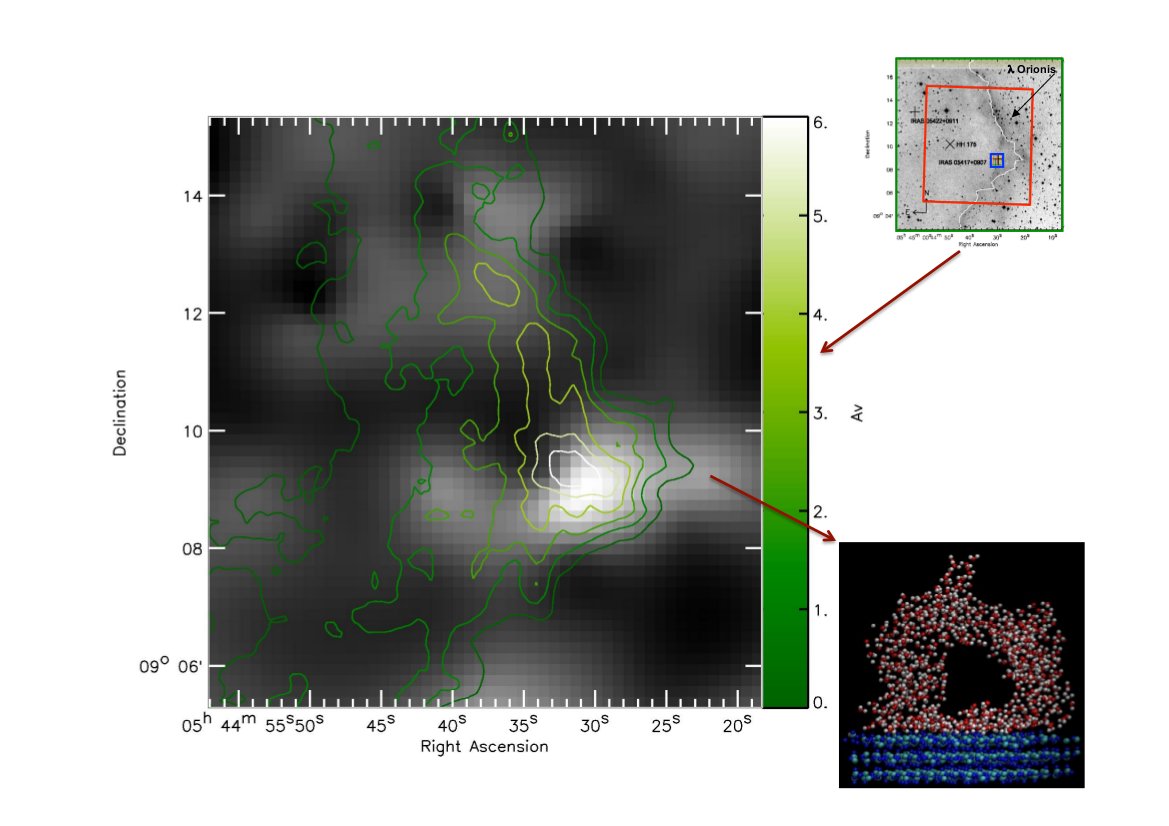
by Helen Fraser, The Open University, Astronomy Division, UK
In regions of star- and planet- formation conditions are sufficiently cold, 'dense' and dark that molecules and atoms acrete onto interstellar dust, forming layers of condensed molecular solids, or ices. The icy material is dominated by water, which under interstellar conditions forms a porous, amorphous material, whose hydrogen bonding structure and chemical and physical properties drastically influence interstellar solid-state chemistry, the gas-solid synergy of ISM regions, and the 'stickiness' of interstellar dust - and therefore whether or not it can impact on planet formation mechanisms around or beyond the snow line of protoplanetary disks.
Our research focuses on interstellar ice, and combines observational data with laboratory techniques and theoretical molecular dynamics calculations. We have recently focused on developing methods of spatially mapping ice distribution across pre-stellar cores, on scales of up to 10' x 10'. Such direct methods offer a rather different insight, on a significantly different astronomical scale, to the innovative, yet indirect, methods of inferring CO snow-lines from N2H+ imaging with ALMA. Our ice maps show that ice can be detected in regions where dust densities are relatively sparce, and way beyond the 'CO gas edge' or detectable 'dust emission edge' of a cloud. These transition regions are very interesting, as they probe the interface between the diffuse and dense ISM. The question then arises how and why ice might exist on interstellar dust grains in regions where we had not previously thought it could be possible. The potential for developing the technique in the JWST E-ELT METIS era will be highlighted.
This requires innovative laboratory techniques. By working with nano-fabrication experts we have developed nano-templated surfaces, which realistically represent interstellar dust grains. I will show that both optical and desorption properties of the surfaces change with scaling, and discuss the results in the context of interstellar chemistry. The results show the influence dust grain surfaces and their chemical composition can have on gas-solid synergies. The porosity of interstellar ices remains a bone of contention. using neutron scattering we can show that all interstellar ices are porous, and elucidate some very interesting data on the pore size and shape distribution, and the rate of collapse. These results are corroborated by molecular dynamics simulations. Finally I hope to showcase our latest experimental adventure. Using a THz SHRIM instrument, developed for atmospheric observations utilizing ALMA receiver technology, we are attempting to observe emission spectra from desorbing gas and radical species just above ice surfaces. The first data, from simple ice heating and desorption will be presented. The context in which such laboratory experiments can be applied to data from Herschel and ALMA will be discussed.
(Abstract PDF)
What We Learned from Surveying the Galaxy in [CII] with Herschel HIFI

by Jorge L. Pineda, Jet Propulsion Laboratory, California Institute of Technology, USA
We present results of a survey of the [CII] 158µm fine-structure line sampled over the entire Galactic Plane. These observations were carried out using the Herschel Space Observatory as part of the Open Time Key project, GOT C+, with spectrally resolved data from the HIFI instrument. The [CII] line traces different phases of the interstellar medium (ISM), including the diffuse ionized medium, warm and cold atomic clouds, clouds in transition from atomic to molecular, and dense and warm photon dominated regions (PDRs). The [CII] 158µm line is the brightest far–infrared line cooling line galaxies, representing 0.1 to 1% of their FIR continuum emission. It is therefore a potentially powerful tracer of star formation activity. We used the [CII] emission together with lines of HI, 12CO, and 13CO to derive the distribution of the different phases of the ISM in the plane of the Milky Way, including the CO-dark H2 component, which is molecular gas not traced by CO but by [CII]. We also compared the [CII] emission and surface density of the different ISM phases with the Galactic star formation rate distribution, which is derived using radio continuum data. We put our results in the context of using the Milky Way as a template for understanding distant galaxies.
(Abstract PDF)
Microwave Spectroscopy of Small Organic Molecules of Astronomical Interest
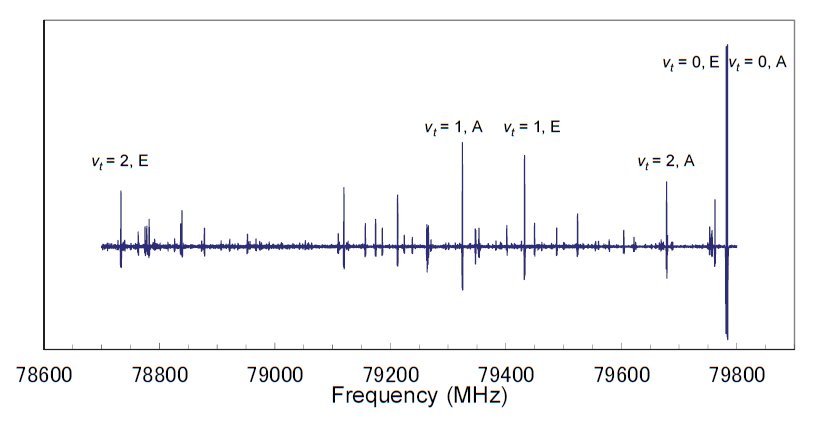
by Kaori Kobayashi, Department of Physics, University of Toyama, Japan
This talk will focus on methyl formate and t-ethyl methyl ether. The microwave spectra of both of these molecules are complicated by methyl-top internal-rotation splitting in the spectra, and both have astrophysical importance. Methyl formate in its ground vibrational state is a very well-known interstellar molecule and very abundant in warm parts of star forming regions. We have extended the spectroscopic assignments in its second torsional state and revised the spectroscopic parameters [1]. We identified a number of unidentified lines in Orion KL as belonging to methyl formate in its first and second torsional states [2, 3]. We hope that the ALMA science verification data provides us with further information.
Thus far, only a tentative detection of the t-ethyl methyl ether in W51 e2 was reported [4]. The interesting spectroscopic feature of this molecule is that two inequivalent internal rotors exist. The rotational spectral patterns in the torsionally excited states often differ from those expected from the one-top case or those of the two symmetric tops. In the case of t-ethyl methyl ether, not only the interaction between the two methyl torsions, but also an interaction with the lowest vibrational mode (skeletal torsion) must be considered as well. More than 4000 lines were least-square analyzed nearly within the experimental uncertainties.
References
[1] K. Kobayashi, K. Takamura, Y. Sakai, S. Tsunekawa, H. Odashima, and N. Ohashi, Astrophysical Journal, Supplement Series, 205, 9 (2013).
[2] K. Kobayashi, K. Ogata, S. Tsunekawa, and S. Takano, Astrophys. J. Lett., 657, L17-L19 (2007).
[3] S. Takano, Y. Sakai, S. Kakimoto, M. Sasaki, and K. Kobayashi, Pub. Astron. Soc. Japan, 64(5), 89 (2012)
[4] G. W. Fuchs, U. Fuchs, T. F. Giesen, F. Wyrowski, Astronom. Astrophys. 444, 521–530 (2010).
(Abstract PDF)
Winter Term 2013/14
Science with ALMA: The Cool Side of the Universe

by Leonardo Testi, European Southern Observatory, Garching
The Atacama Large Millimetre/Submillimetre Array is nearing completion at 5000m altitude in the Atacama desert. Science Verification and Early Science observations have already started to produce transformational science results. With the observatory quickly ramping up to Full Science operations, ALMA is the most powerful tool to explore the cool Universe. I will present the status of the observatory, its current scientific capabilities and science results. I will also discuss the science drivers and plans for ALMA upgrades in the coming years.
(Abstract PDF)
From Stellar Surfaces to Mass Loss with High Angular Resolution Optical-IR Instruments
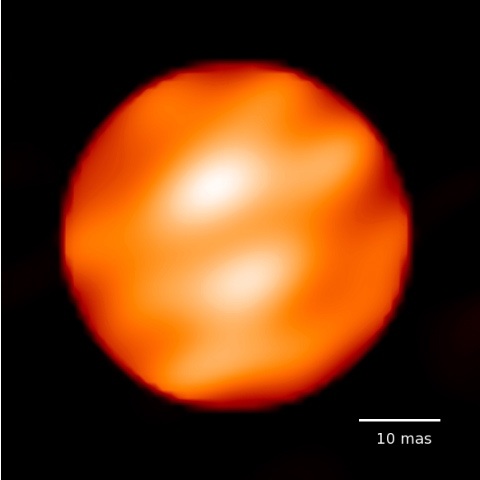
by Guy Perrin, Observatoire de Paris / LESIA
The details of how mass is lost in evolved stars are still partly elusive. The global picture of how molecules are produced and how gas is pushed away to the interstellar medium by a dust-driven wind is well understood. However, the scenario of how this works close to the star surface still has to be completed and is very much dependent on the star characteristics. In Mira-type stars, large amplitude pulsations are thought to be the major source of mechanical energy to lift molecules up to an altitude where dust can condensate. Such a scenario is not applicable to red supergiants and another source of energy is required. One candidate is convection and its connection with magnetic fields. A lot of progress has been made with photometric, spectroscopic studies and simulations. Another useful tool is imaging at high angular resolution. I will present some recent results in this field based on interferometric and adaptive optics imaging obtained by the group at Observatoire de Paris/LESIA. I will also present some prospects with long baseline interferometers and the FIRST instrument, a fibered pupil masking instrument installed at Subaru.
(Abstract PDF)
Linear Vibrational Spectroscopy of Supersonically Cooled Molecules and their Aggregation
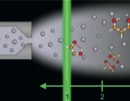
by Martin Suhm, Institut für Physikalische Chemie, Georg-August-Universität Göttingen
Our molecular picture of the interstellar space is somewhat biased due to the high visibility of strongly polar molecules in rotational spectroscopy. This talk will address a few molecules and molecular dimers with partially low or vanishing dipole moments, which we have studied in the laboratory in vacuum isolation at low temperature. The experimental tools are spontaneous Raman scattering and FTIR spectroscopy in supersonic jets [1]. In the main part, it will be shown how isolated linear alkanes fold under the influence of London dispersion forces, overcoming conformational barriers. Depending on how well a theoretical model describes van der Waals attraction between the chain ends and the conformational landscape, it will predict this to happen at a different chain length. Experiment now says it will happen beyond 17 or 18 carbon atoms [2]. Time permitting, one or more examples from the series HO-(CHx)n-CH=O with n=0,1,2 will be discussed. Formic acid (n=0) is itself polar, but it forms a non-polar dimer, for which we were recently able to establish the experimental binding energy within 1% [3]. Glycolaldehyde (n=1) was the first “sugar” molecule detected in space. Its dimers show a wide range of polarities and we could show that the global minimum structure is rather polar, offering at least a remote possibility to detect it in interstellar space [4]. Malonaldehyde (n=2) shows little tendency to dimerize, but a well-known THz tunneling splitting due to proton transfer in a symmetric double well. We were able to measure this tunneling splitting in more than a dozen vibrationally excited states, showing wide variations with the character of the normal mode [5].
[1] M. A. Suhm, F. Kollipost; Femtisecond single-mole infrared spectroscopy of molecular clusters, Phys. Chem. Chem. Phys. 15 (2013) 10702-10721
[2] Nils O. B. Lüttschwager, Tobias N. Wassermann, Ricardo A. Mata, and Martin A. Suhm; The Last Globally Stable Extended Alkane, Angew. Chem. Int. Ed. 52 (2013) 463-466
[3] F. Kollipost, R. Wugt Larsen, A. V. Domanskaya, M. Nörenberg, and M. A. Suhm; Communication: The highest frequency hydrogen bond vibration and an experimental value for the dissociation energy of formic acid dimer, J. Chem. Phys. 136 (2012) 151101
[4] Jonas Altnöder, Juhyon J. Lee, Katharina E. Otto, Martin A. Suhm; Molecular Recognition in Glycolaldehyde, the Simplest Sugar: Two Isolated Hydrogen Bonds Win Over One Cooperative Pair,
ChemistryOpen 1 (2012) 269-275
[5] Nils O. B. Lüttschwager, Tobias N. Wassermann, Stéphane Coussan, and Martin A. Suhm; Vibrational Tuning of the Hydrogen Transfer in Malonaldehyde – A combined FTIR and Raman Jet Study, Mol. Phys. (2013) in press
(Abstract PDF)
The ALMA View of One of the Nearest Starburst Galaxies

by Alberto D. Bolatto, Department of Astronomy and Joint Space Institute, University of Maryland, Visiting Humboldt Fellow at MPIA, Heidelberg
In the context of galaxy evolution, it is particularly interesting to understand better the mechanisms that regulate starburst activity in galaxies. In this talk I will present an analysis of the molecular ISM properties in the prototypical circumnuclear starburst galaxy, NGC 253, derived from ALMA observations. I will discuss the evidence for a molecular superwind, our measurements of the mass loss rate, and the possible gas entraining mechanisms. I will show our measurement of the properties of giant molecular clouds in the starbust, in an effort to better understand the conditions in this region. Finally, I will present and discuss some of the chemical complexity we see in the data. The extremely rich spectroscopy, a common feature in many ALMA datasets, opens new windows for the study of physical conditions in extragalactic systems.
(Abstract PDF)
MHD Turbulence within Interstellar Molecular Clouds

by Mark Heyer, Department of Astronomy, University of Massachusetts, Amherst
Turbulence within star forming regions of the Milky Way is generally inferred from supersonic velocity dispersions measured in the line profiles of molecular line emission, most notably, the millimeter rotational transitions of 12CO and 13CO. Driven primarily by computational simulations, it has been suggested that the production of newborn stars in molecular clouds is seeded by shocks produced from supersonic, converging streams of material and that the star formation properties (IMF, efficiency, degree of clustering) depend upon the specific attributes of the turbulent gas flow (velocity spectrum, turbulent driving scale, sonic scale). Our ability to measure these attributes has greatly increased in recent years owing to the deployment of heterodyne focal plane arrays at millimeter wavelengths that enable wide field spectroscopic imaging of molecular line emission and the development of analysis tools that exploit the velocity information resident within these data cubes. In my presentation, I will summarize the imaging campaigns of molecular line emission gathered by the FCRAO 14m telescope with the SEQUOIA focal plane array and the application of Principal Component Analysis on these data to derive fundamental properties of turbulent flows in giant molecular clouds. The near universality of velocity structure functions for a large sample of clouds is linked to the widely referenced but often misunderstood Larson (1981) scaling relationships, the driving scale of turbulence in the interstellar medium, and turbulent fragmentation descriptions of star formation. I will also present evidence for velocity anisotropy induced by interactions between Alfven waves (the Goldreich-Sridhar Effect), within the low column density envelope of the Taurus Molecular Cloud. These results emphasize the important role of the interstellar magnetic field in the dynamics of molecular clouds.
(Abstract PDF)
Multiwavelength Studies of Active Galaxies

by Areg Mickaelian, Byurakan Astrophysical Observatory (BAO)
A review of recent multiwavelength (MW) studies of active galaxies will be given. The activity types of 779 Markarian galaxies have been revised based on available SDSS spectra and a MW catalogue of Markarian galaxies has been created. Such MW catalogue is being created for all bright (m17) AGN as well, which will include their gamma-ray, X-ray, UV, optical, IR and radio data, altogether 38 photometric measurements, giving a large possibility for comparative studies of their SEDs. Activity types for 83 Byurakan-IRAS Galaxies (BIG) have been determined from SDSS DR7-DR9. We have cross-correlated X-ray (ROSAT) and radio (NVSS, FIRST) catalogues and obtained a sample of high probability bright AGN (Blazars, QSOs, Seyferts), which will be observed for spectroscopic identification. On the other hand, we have cross-correlated NVSS and FIRST and obtained a sample of variable radio sources (having > 3 sigma deviations between the two catalogues), as well as investigated the radio structure of the NVSS sources having multiple associations in FIRST (central source, radio lobes and possible jets).
(Abstract PDF)
Star Formation, Molecular Gas Fractions and Gas Dynamics in High-redshift Galaxies
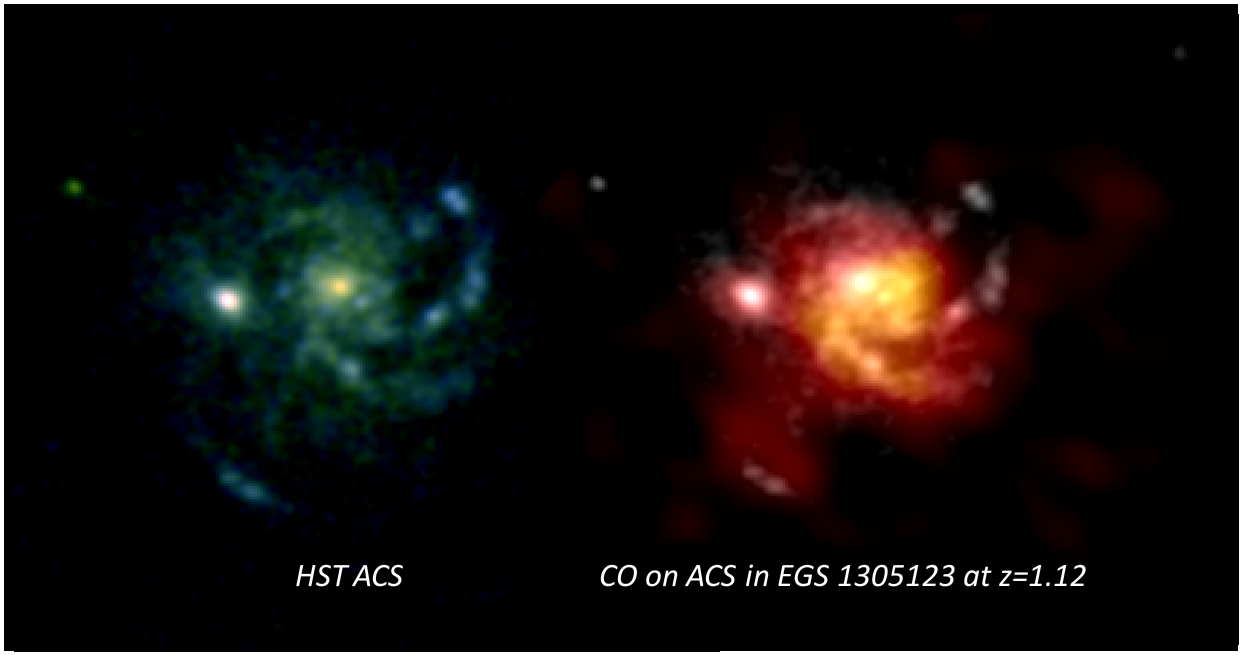
by Linda Tacconi, Max Planck Institute for Extraterrestrial Physics, Garching
Our understanding of the formation and evolution of galaxies has improved dramatically over the past decade. We now have a robust outline of the global evolution of galaxies since as early as 1 - 2 billion years after the Big Bang right up to the present epoch. However, we have yet to understand how exactly galaxies assembled their mass and evolved with time. The major limitation is our incomplete knowledge of the relevant mechanisms that control the phase, angular momentum, cooling, and dynamics of the baryonic matter. I will discuss progress on many of these issues through the study of the kinematics, star formation and cold gas properties of z~1-3 massive star forming galaxies (SFGs) with spatially resolved spectroscopy. Using the IRAM Plateau de Bure millimeter interferometer we are mapping the CO J=3-2 line emission in over 100 SFGs and find that they are very gas rich. These SFGs likely develop from continuous, rapid accretion of gas from their dark matter halos, and that their evolution is strongly influenced by internal, secular evolution. I will discuss the first scaling relations for massive SFGs that we derive from these data, and the impact of all of these new observations on our understanding of galaxy evolution in the early Universe.
(Abstract PDF)
Sculpting the Galactic Center
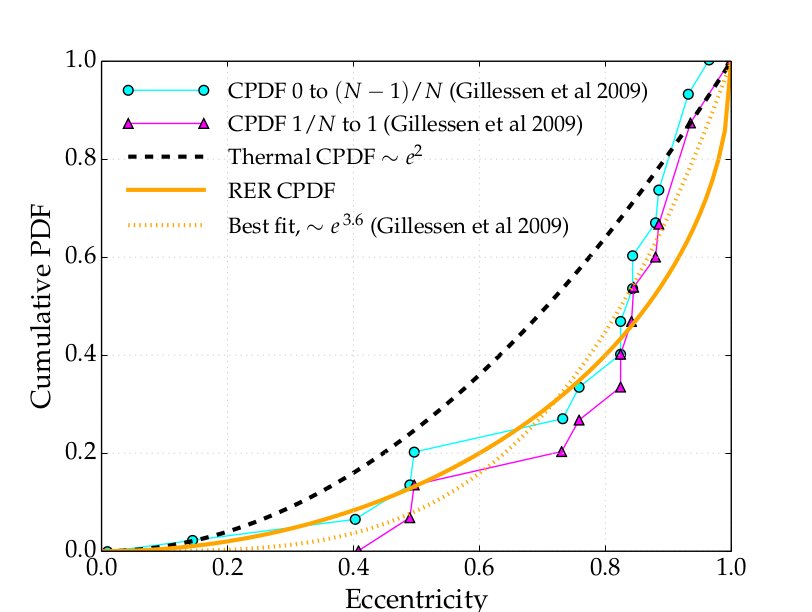
by Pau Amaro Seoane, Max-Planck Institute for Gravitational Physics, Potsdam
Since 1996 we have known that the Galactic Center (GC) displays a core-like distribution of red giant branch (RGB) stars starting at ~ 10", which poses a theoretical problem, because the GC should have formed a segregated cusp of old stars. I postulate that the reason for the missing stars in the RGB is closely intertwined with the disk formation, which initially was gaseous and went through a fragmentation phase to form the stars. After the star-forming episode, I prove that that disk is responsible for the range of eccentricities of the S-stars and the absence of Wolf-Rayet (WR) and O-stars inside 1".
The Multiple Personalities of Cosmic Dust
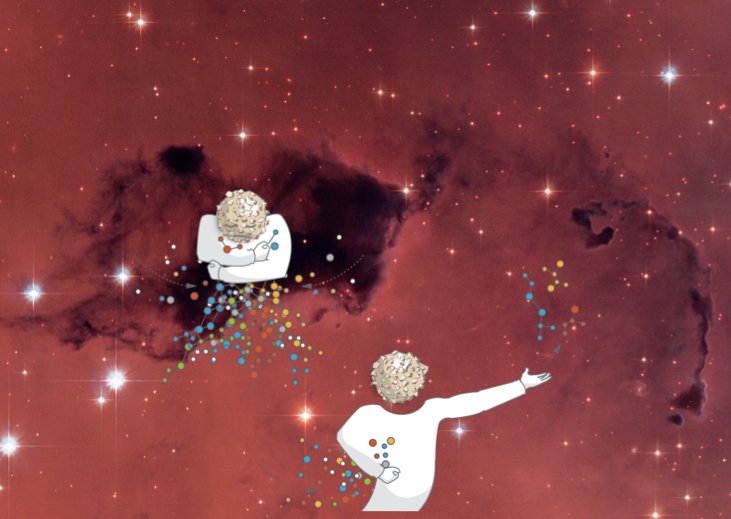
Summer Term 2013
The Horsehead's Mane: A Striking Molecular Reservoir

by Evelyne Roueff, Observatoire de Paris
The Horsehead's mane: a striking molecular reservoir
The Horsehead's mane is a nice template of a Photo Dissociation Region (PDR):
The density and temperature profiles across the PDR are well constrained by a bunch of observations from the infrared to microwave spectral windows.
The combination of close distance to Earth (about 400pc), moderate illumination and steep density profile allows to probe physical and chemical processes over relatively small spatial scales.
I will present and discuss some recent, sensitive, high spectral resolution observations performed at different positions in the Horsehead nebula. Particular emphasis will be put on the tentative identification of a new hydrocarbon cation C3H+, on the second detection of CF+ and the spatial abundance variation of complex molecules such as formaldehyde, methanol, methyl cyanide in relation with the physical and chemical environment.
(Abstract PDF)
SFB 956 presentation: Ion-molecule Reactions at Low Temperature: N+ + H2 by Oskar Asvany (Abstract PDF)Observing Low Mass Star Formation in High Mass Star Forming Regions: Assessing the Role of Environment in the Birth of Stars and Planets

by Tom Megeath, University of Toledo, Ohio, USA
Most low mass stars form in the massive molecular cloud complexes that are also the sites of high mass star formation. These vast complexes contain a rich diversity of environmental conditions, from the dense centers of clusters where low mass stars are found in close proximity to massive stars, to sparse groups of low mass stars many tens of parsecs from the nearest massive stars.
I will discuss an observational program to use these massive complexes as astrophysical laboratories for studying star formation across the mass spectrum and the formation of planets around low mass stars. This program uses multi-wavelength observations of rich star forming complexes such as Orion to empirically characterize protostars, pre-main sequence stars, and disks in the diverse conditions found within the complexes. These observations show how the conditions in the cloud gas and the density of nearby stars influence the rate and efficiency of star formation, the multiplicity and mass function of the nascent stars, and the presence of circumstellar disks. The large numbers of young stars in these complexes also makes them valuable hunting grounds for rare objects that may be unusual or in short-lived phases of protostellar evolution; I will overview some recent finds of rare objects in Orion.
(Abstract PDF)
SFB 956 presentation: Complex Organic Molecules in the Interstellar Medium: Pushing the Limits with Millimeter-wavelength Spectroscopy by Arnaud Belloche (Abstract PDF)The Herschel View of Orion: Reactive Ions and Beyond
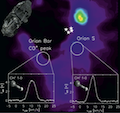
by Zsofia Nagy, Kapteyn Institute Groningen
The Orion region is the nearest site of ongoing high-mass star formation, located at a distance of about 400 pc. It includes HII regions, Photon Dominated Regions (PDRs), and hot molecular cores. The Orion Bar is a well-studied PDR illuminated by a cluster of young massive stars (Trapezium cluster) and provides an excellent opportunity to study the interaction between star formation and interstellar gas; and the chemistry in PDRs. Though the Orion Bar is the best studied PDR in the Orion region, a larger region is illuminated by the Trapezium cluster and represents a key environment to study chemical reactions in PDRs.
The Heterodyne Instrument for the Far Infrared (HIFI) on board the Herschel Space Observatory allows to carry out spectrally resolved observations of molecular line tracers of PDRs, including reactive ions. Reactive ions such as CH+, CO+, and OH+ react with the most abundant species H, H2, and electrons on short timescales. In addition to their reactivity, some of these ions require large energy input for their formation via endothermic reactions. Reactive ions were detected in emission using Herschel/HIFI in Orion in a region illuminated by the Trapezium cluster, including the Orion Bar and the FUV-illuminated surface of the Orion S molecular core.
In this talk, Herschel observations of reactive ions in Orion will be discussed with a focus on the Orion Bar and Orion S regions. The observations that will be presented in this talk are part of the HEXOS (Herschel observations of EXtra-Ordinary Sources, PI: E. Bergin) key program. The interpretation of the observations using radiative transfer and PDR models and a comparison of the results to other astrophysical environments such as diffuse regions, high-mass protostars, and X-ray dominated regions will be discussed.
(Abstract PDF)
Chemical Enrichment of the ISM Through the Mass Loss of Evolved Stars
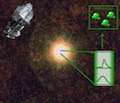
by Leen Decin, University of Leuven
In May 2009, the ESA Herschel satellite was launched from Kourou in French Guiana. With the largest mirror ever in space (3.5m) and the 3 infrared instruments on board, the Herschel satellite is a unique instrument for the study of evolved stars. The new observations challenge our current understanding of the physical and chemical processes in evolved stars. While the images show us an enormous complexity in geometrical structures, the infrared spectra are overwhelmed with molecular and dust features. Interpreting this wealth of information using new dedicated models is a real challenge, but it also shows us the enormous goldmine of new astrophysical information hidden in the data. I will discuss some of the recent Herschel highlights, illustrating how dedicated models are the key for exploiting these observations.
(Abstract PDF)
Comet Chemistry

by Dominique Bockelée-Morvan, LESIA, Observatoire de Paris
Comets provide a record of the composition of the solar nebula at the time planetary bodies were forming. About two dozens of molecules have now been identified in comets, either from in situ or remote sensing measurements. This includes complex molecules such as ethylene glycol, and molecules produced from the degradation of organic grains. In addition, key isotopic ratios (e.g., D/H, 14N/15N) have been measured, which comparison to star-forming regions and other solar system primitive materials provide constraints to processes at work in the early solar nebula. Unexpected was the detection of Earth-like water in a comet. A review of our knowledge of cometary chemistry will be presented, in light of the recent results obtained with Herschel.
(Abstract PDF)
Chemistry and Spectroscopy in Warm Molecular Clouds
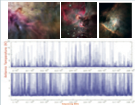
by José Cernicharo, CAB. CSIC-INTA, Madrid
Astrochemistry in the Lab: Low-Temperature Chemistry in Merged Neutral Beams
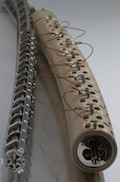
Winter Term 2012/13
Molecules and Chemistry as Tracers of Galaxy Evolution
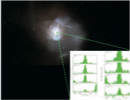
by Susanne Aalto, Onsala Observatory, Sweden
Laboratory Spectroscopy and Astronomical Observations in Search for a Drifting Proton-Electron Mass Ratio
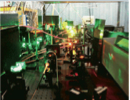
by Wim Ubachs, Institute for Lasers Life & Biophotonics, VU University, Amsterdam, Nederland
Since the days of Dirac scientists have speculated about the possibility of varying constants and time-varying laws of nature. In the past decade it has been established that spectral lines of atoms and molecules, which can currently be measured at ever-higher accuracies, form an ideal test ground for probing drifting constants. In particular the spectra of molecules are sensitive for probing a variation of the proton-electron mass ratio mu, either on a cosmological time scale, or on a laboratory time scale. In the talk a comparison will be made between spectra of molecular hydrogen observed in the laboratory and at a high redshift (z=2-3), using the Very Large Telescope (Paranal, Chile) and the Keck telescope (Hawaii) [1]. This puts a constraint on a varying mass ratio delta mu/mu at the 10^-5 level. The optical work can also be extended to include CO molecules. Further a novel direction will be discussed: radio-astronomy of hindered internal rotor molecules which appear to be very sensitive for a varying proton-electron mass ratio.
(Abstract PDF)
SFB 956 presentation: Nonequilibrium in Superconducting Terahertz Detectors by Marc WestigGraphite and Graphene, Low Temperature Catalysts Producing Weakly Excited H2 Molecules
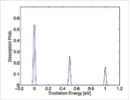
by Wilhelm Brenig, Physik Department, Technische Universität München, Germany
A model for the low temperature catalysis of hydrogen molecules with low internal excitation on graphite and graphene is proposed: Hydrogen atoms are physisorbed on graphene and transported ballistically to a (barrierless) chemisorbed state at the boundary. A second atom then can produce a molecule via a hot atom or Eley-Rideal process. Since much of the energy is needed to desorb the molecule from the tightly bound chemisorbed state the desorbing molecules have only low internal excitation energy in agreement with astronomical observations.
(Abstract PDF)
Water in Protoplanetary Disks: Steambath and/or Dry Desert?
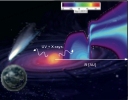
by Inga Kamp, Kapteyn Institute, Groningen, The Netherlands
The disks around young stars, protoplanetary disks, are thought to be the birthplaces of planetary systems such as our own. Spitzer and ground-based observations showed in several cases the existence of water in such disks around young stars, hence inspiring the discussion of how much water vapour and ice is present to form gas giant planets, water worlds, but also to deliver the Earth oceans and eventually lead to the emergence of life.
One of the goals of the GASPS Open Time Key Program (PI: B.Dent) is the detection of water in young protoplanetary disk systems. We detected water using the PACS instrument in several protoplanetary disk systems, young T Tauri as well as Herbig stars and also in the more mature system TW Hya. This is currently the highest water detection rate on class II/III objects obtained with Herschel. Resolved line profiles from HIFI observations from the WISH key program and our own follow-up observations help us to distinguish between various possible origins of the water emission.
I will discuss the interpretation of the various observations, using a variety of tools: simple LTE slab models, shock models, thermo-chemical disk models, and a large grid of parametrized disk models, DENT (Disk Evolution with Neat Theory), which was generated using a pipeline of the Monte Carlo RT code MCFOST and ProDiMo.
(Abstract PDF)
Shadows, Gaps, and Ring-like Structures in Proto-planetary Disks
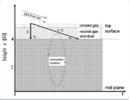
by Ralf Siebenmorgen, ESO Headquarters Garching, Germany
We study the structure of passively heated disks around T Tauri and Herbig Ae stars (AA 539, 2012) and present a vectorized Monte Carlo dust radiative transfer model (ApJ 751, 2012). The vectorization provides a speed up factor of 100 when compared to a scalar version of the code. Proto-planetary disks are composed of either fluffy carbon and silicate grains of various sizes or dust of the diffuse ISM. The IR emission and the midplane temperature derived by the MC method differ from models where the radiative transfer is solved in slab geometry of small ring segments. Under the assumption of hydrostatic equilibrium we find that the disk in the inner rim puffs up, followed by a shadowed region. The shadow reduces the temperature of the midplane and decreases the height of the extinction layer of the disk. It can be seen as a gap in the disk unless the surface is again exposed to direct stellar radiation. There the disk puffs up a second time, a third time and so forth. Therefore several gaps and ring-like structures are present in the disk surface and appear in emission images. They result from shadows in the disks and are present without the need to postulate the existence of any companion or planet. As compared to Herbig Ae stars, such gaps and ring-like structures are more pronounced in regions of terrestrial planets around T Tauri stars. We present an accurate treatment of PAH molecules in the MC code. Particular attention is given to the photo-dissociation of the molecules by energetic photons. We consider beside PAH destruction also the survival of the molecules by vertical mixing within the disk (see Fig.). By applying typical X-ray luminosities the model accounts for the low PAH detection probability observed in T Tauri and the high PAH detection statistics found in Herbig Ae disks (AA 543, 2012). Spherical halos above the disks and mid-IR images are presented. We show that disks are easier to resolve when PAH emission dominates.
(Abstract PDF)
SFB 956 presentation: Sunblock Extreme - Astrophysics and Astrochemistry in Photo-dissociation Regions by Markus Röllig (Abstract PDF)Crosscorrelation Statistics and Modelling the Spectral Properties of ISM
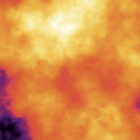
by Stepanov Rodion, Institute of Continuous Media Mechanics, Perm, Russia
The inverse problem of the detection of the helical properties of a turbulent magnetic field using integral observation statistics is discussed. A principal solution that sets the relation between the values of magnetic helicity and the level of correlation between the Faraday rotation measure and the polarization degree of radio synchrotron emission has been presented. The effect of depolarization plays the main role in this problem and allows for the detection of magnetic helicity for a certain frequency range of observable radio emissions. The proposed method is mainly sensitive to the large-scale magnetic field component.
(Abstract PDF)
Liquid Microjet Synchrotron Radiation Photoelectron Spectroscopy of Chemical State Change in Aqueous Solutions
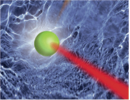
by Manfred Faubel, Max-Planck-Institute for Dynamics and Self-Organization, Göttingen, Germany
The free vacuum surface of aqueous solutions is prepared in high vacuum as a tiny, sub-Knudsen size liquid jet with 15 µm diameter. X-ray photoelectron spectroscopy of chemical shifts for 1s shells of N, O or C-atoms, thus, can be exploited for site specific binding state analysis in liquids.
This is allows measurements of electronic state binding energies and relaxation energies in liquid electrochemical systems, for example, or, microscale studies of the pH dependent protonation/deprotonation process of amino acid groups in solvated organic molecules.
In addition, by variation of the photon/photoelectron energy the method yields liquid surface segregation stoichiometric data and near surface concentration depth profiles of individual solute groups at the liquid-gas interface.
(Abstract PDF)
SFB 956 presentation: Dark Molecular Gas and the formation of Molecular Clouds in the Milky Way and the Nearby Galaxy M33 by Christian Glück (Abstract PDF)Comparing Theory to Observations during the Early Stages of Star Formation
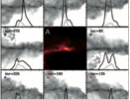
by Rowan Smith, Institute for Theoretical Astrophysics, Universität Heidelberg, Germany
Observations are revealing the ubiquity of filamentary structures in molecular clouds. Collapsing cores form along the filaments and massive stars are formed where multiple filaments converge. I will examine the dynamics of such systems by using radiative transfer modeling to obtain molecular line profiles from simulations and critically comparing to observations.
Filaments are found to typically exhibit low line widths and have mild velocity gradients of a few km/s across their length. In high density clustered regions, internal filament velocities can hide collapse signatures from their embedded collapsing cores in up to 50% of cases, and the line profiles are highly variable with viewing angle. In some cases, red asymmetric line profiles can even be seen from collapsing cores.
In simulations of massive star forming regions there are large scale convergence motions centered on the massive protostars. Such motions are the result from massive stars forming at the bottom of the potential-well of their parent proto-cluster. The resulting line profiles are less variable with viewing angle than their low mass analogues. Furthermore, a characteristic “saw-tooth” line profile is often seen from massive star forming regions instead of the more usual double peaked blue asymmetric profile.
(Abstract PDF)
SFB 956 presentation: Chemical Evolution in Hot Molecular Cores by Rumpa Choudhury (Abstract PDF)ALMA in the Final Straight of Construction
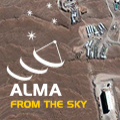
PREVIOUS COLLOQUIA
02.07.2012 (supplementary colloquium)
Principal Component Analysis for Chemistry Simulations (Abstract PDF)
by Erik Bertram, Institute for Theoretical Astrophysics, Heidelberg, Germany
25.6.2012
Structures in the Interstellar Medium: Filaments, Pillars, and Globules (Abstract PDF)
by Nicola Schneider
CEA Saclay, Observatoire de Bordeaux, France
18.06. 2012 (supplementary colloquium)
A Statistical Approach to Derive Mass Functions of Condensations (clumps and cores) in Molecular Clouds (Abstract PDF)
by Todor Veltchev, Sofia University, Bulgaria
11.6.2012
Peering in to the Dark: Probing the Initial Conditions for the Formation of Stellar Clusters and Massive Stars (Abstract PDF)
by Gary Fuller
Jodrell Bank Centre for Astrophysics & University of Manchester, UK
14.5.2012
The Physics and Chemistry of Star Formation as Revealed by HIFI Observations (Abstract PDF)
by Floris van der Tak
Netherlands Institute of Space Research (SRON), Groningen, The Netherlands
16.4.2012
Peculiar Star Forming Regions (Abstract PDF)
by Maite Beltran
INAF-Osservatorio Astrofisico di Arcetri, Florence, Italy
02.04.2012
Global Spectroscopy of Small Molecules (Abstract PDF)
by Oleg L. Polyansky
Microwave Spectroscopy Lab, Institute of Applied Physics, Russian Academy of Science, Russia
01.03.2012 (supplementary colloquium)
The Dusty Heart of Active Galaxies - Dissecting the Torus with IR Observations (Abstract PDF)
by Sebastian F. Hönig, University of California Santa Barbara, Department of Physics, USA
Announcements
Winter term 2012/13 (PDF)
Summer term 2012 (PDF)
Winter term 2011/12 (PDF)
Summer term 2011 (PDF)